Learn Japanese
I want to learn Japanese!
If you follow the instructions in this over the top, step-by-step guide, you will reach your goal of Japanese fluency.
However, this journey is going to take a lot of effort and hard work on your part. Anyone who tells you learning a language is going to be easy is either misinformed or trying to sell you something. And eventually, after the honeymoon phase of learning wears off, progress feels slower. You burn out. Sh*t hits the fan. If you've ever tried learning something new, you know exactly what I'm talking about.
Instead, you need to do things the hard way (i.e. the correct way) right from the start.
Just because we're doing it right doesn't mean it has to be inefficient.
This method for learning Japanese starts at the very beginning. I assume you have zero knowledge of the Japanese language and guide you through each step. I'll cover reading, writing, speaking, and listening. And we explain what you should use, when, and why.
This should be everything you need to progress, that way you don't use all of that fresh enthusiasm you're feeling on planning how to learn, and instead spend it on actual learning.
Make like those famous shoes and just do it.

Our goal is to reach Japanese fluency as directly as possible. Unlike a teacher or a textbook, we have the freedom to be ruthless in the path we take to get there.
There are no tests or quizzes to take. You don't have to move at the speed of the slowest learner in your group. All you need to do is follow each step, do the work, and progress.
Just keep in mind that because of this, some steps may seem counterintuitive. They may even seem slow compared to other methods, but everything has been carefully selected to get you to the finish line faster and more efficiently. We'll talk more about that later.
A bit of housekeeping first: This is a living document, meaning it will be updated from time to time. Check back, subscribe to our email list , or follow us on Twitter to know when these updates happen. And, if you already have experience with Japanese, I still recommend you give it a read. There's a good chance you'll find something important to help you on your own Japanese language journey.

Table of Contents
Learn to read hiragana, basic japanese pronunciation, learning to type hiragana in japanese, understanding the concept of "kanji", beginning kanji & stockpiling kanji knowledge, learn to read katakana, learning to type katakana, learning to type kanji, 1. collecting vocabulary, 2. processing, 3. adding the words to your srs, beginning japanese grammar, a beginner's japanese textbook / program, answering your japanese language questions, order of learning, fact checking / cross referencing, do the work, sometimes, you'll just get stuck, optional: finding a japanese language tutor, suggested books and resources, intermediate level japanese, zero knowledge of japanese.
Welcome to learning Japanese! This section is for the true beginner. You know little-to-no Japanese. Maybe a "konnichiwa" here and a "baka" there. These first steps you take are especially important because they're going to set a foundation you can build off of.
The more deliberate your steps, the easier everything that follows will be.
Carefully completing this section is going to be necessary if you want to avoid the thing that takes down most learners: the intermediate wall. Instead, take your time on these foundational steps. What feels slow now is actually speed later on.
Estimated Time: 1 day to 1 week

Hiragana is Japan's version of the alphabet. It is one of three Japanese writing systems you need to learn to be able to read. The other two are katakana and kanji, but hiragana is where everything starts.
The ability to read hiragana is going to be a prerequisite for most beginner Japanese textbooks and resources. It's the first thing you learn in a traditional classroom. Surprisingly, I agree with everyone else. This is a good place to start.
Most Japanese classrooms spend an entire month learning how to read and write hiragana. That's too long! Instead of writing out each hiragana character over and over to memorize them, use the guide below and you may be reading hiragana later tonight. It uses mnemonics and worksheets that are designed to help you learn and be able to recall hiragana faster than you thought possible.
Do it: Learn How to Read Hiragana
It's important to note that this guide is going to teach you how to read hiragana and not how to write it. This has a purpose! While it is important to learn how to hand write Japanese eventually, right now it will slow you down immensely with very little payoff. Typing covers 99% of modern day writing so you will learn how to type hiragana (and katakana and kanji) instead.
This, in combination with mnemonics and worksheets, will allow you to learn how to read hiragana in a day or two instead of a month.
Remember: You're not in a class. You don't have to move at the speed of the slowest 10%. There is no speed limit .
In order to complete this section and move on, you need to get to the point where you can read all of the hiragana. Even if you're slow, as long as you can recall each character, as well as the contractions, without cheating, that's enough. You're about to get plenty of practice and your reading speed will naturally increase over time as you move on.
Note: Read "Japanese Pronunciation, Part 1" (below) before you start learning hiragana.
Estimated Time: n/a

Good pronunciation starts with hiragana. While hiragana alone won't teach you everything, it is the key to understanding how and why Japanese words sound the way they do. It will also help you get the foundation you need for a native-sounding accent. At the very least, hiragana will get you 80% of the way there.
For the remaining 20%, we wrote a guide covering the basics of Japanese pronunciation. Before you begin learning how to read hiragana, you should read up to the "Japanese Sounds and Your Mouth" section.
Once you've finished learning how to read hiragana, go though that section again, but this time read about "Important Differences" as well. This section will cover all of the sounds that don't exist in English, giving you a head start. Make sure you can pronounce all of the hiragana characters correctly before moving on.
Read: Basic Japanese Pronunciation Guide
With pronunciation, it's best to put the time and work in now, at the beginning. Don't ignore it because it's hard. When things get more difficult, it's very important that you've spent time speaking and hearing these sounds so that you can learn about all the differences and exceptions headed your way.
Okay, now go ahead and get back to learning how to read hiragana . Get to the point where you can read and recall everything, then move on to the next section.
Estimated Time: 1-2 days (or less) Prerequisite: Able to read hiragana

Now that you can read and pronounce hiragana (remember, slowly is okay!) it's time to learn how to type it on your computer or smartphone.
First, you need to install a Japanese keyboard. Luckily, you don't have to buy a special piece of hardware or computer to do this thanks to a type of software called an IME (input method editor). You can add an IME onto almost any kind of computer, phone, or operating system. Just follow the instructions in this guide to add them to your devices:
Read: How to Install a Japanese Keyboard
After you’re done installing, it’s time to learn how to actually type. Use the following guide, and only focus on the hiragana portion (since that’s all you know how to read right now):
Read: How to Type in Japanese
Assuming you are able to read hiragana, typing in hiragana is surprisingly straightforward. Once you feel confident in your typing abilities, including trickier things like contractions, small tsu, and dakuten, move on to the next section. It's time to talk about the elephant in every Japanese learner's room: kanji.
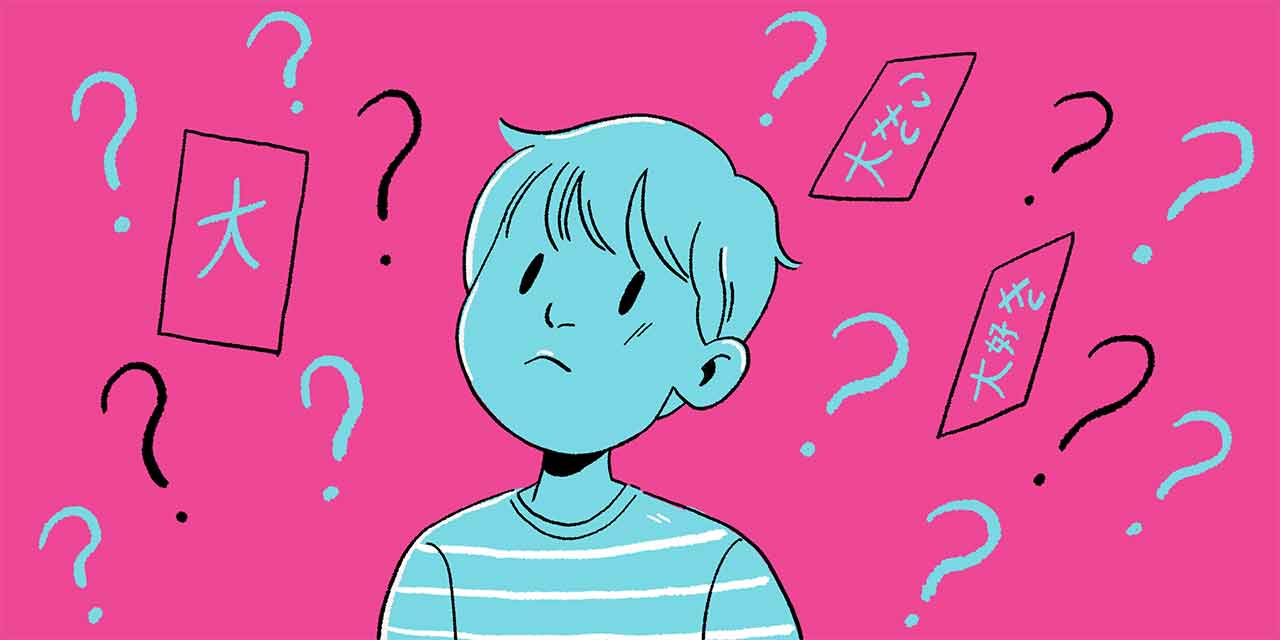
In our Japanese learning method, you're going to learn to read kanji characters very early. As soon as you can read and type hiragana it's time to start tackling kanji.
Here is our reasoning:
The most difficult thing about learning Japanese is kanji. At least, that's what people say. But trying to save it or brush it off until later isn't going to help you learn Japanese. Almost everything uses kanji, making it one of the most important aspects of learning this language. Your learning quality of life will drop drastically if you choose to ignore it.
A lot of a beginner’s time when using a textbook is spent looking up kanji and vocabulary. This takes your focus away from the grammar you're trying to learn and makes progression slow and frustrating. Learning (some) kanji and vocabulary first makes learning grammar a lot faster and, more importantly, easier. Think of it this way: you're losing a little time now to save a ton of time later.
Kanji leads to vocabulary, vocabulary aids communication, and grammar is like the glue that holds vocabulary together. Without vocabulary there's nothing for the grammar glue to stick to and everything gets messy. It makes grammar abstract and difficult to learn, when it doesn't have to be.
Like hiragana, we have a way for you to learn kanji that's way more effective than the traditional methodology (rote memorization). Thanks to that, it won't be as difficult as everyone says. It may even *gasp* be a pleasure to learn! Maybe.
This kanji-vocabulary-first route will get you to the point where you can use Japanese quickly. It feels slow at first, but soon you will rocket past your fellow Japanese learning compatriots. You'll also be able to get over that "intermediate wall" easier and quicker than if you were to use a traditional method. This lowers your chances of burnout and giving up all together.
If you're on board with this philosophy, you need to start at the very beginning: understanding what kanji is and how it's used. For that, we have another guide for you to read:
Read: On’yomi vs. Kun’yomi: What’s the Difference?
Once you understand how Japanese kanji readings work, you’ll be ready to learn some actual kanji.
Estimated Time: 1-3 months

Important note about this section: You should start to learn katakana (the next section) at the same time as this step. "Beginning Kanji & Stockpiling Kanji Knowledge" will take 1-3 months. In fact, you can complete all of the steps up to "The Beginner of Japanese" while you work on this one!
Okay, so it's time to actually learn kanji. Let's define what "learn kanji" means before you get started. That way you know what is expected of you.
When I say "learn kanji" I mean learn the kanji’s most important (English) meaning(s), and their most important (Japanese) reading(s). As you know from reading about on'yomi and kun'yomi, some kanji have a lot of readings. And, unfortunately, English meanings are just translations and can't always match the Japanese meaning one-to-one. That means there can be many correct English meanings for a single kanji that you'll need to deal with. We'll narrow those down so you only learn the most important meanings and readings first—the ones used 80-90% of the time. The remaining meanings and readings will come via vocabulary and other practice.
As you learn kanji you will also learn vocabulary that use those kanji. Not only will this help solidify those kanji concepts in your mind, but it will also be where you learn the remaining kanji readings. Plus, as you know, this vocabulary will be used to give you something to glue together with grammar later.
By the end of this guide, your goal is to know around 2,000 of the most important kanji as well as 6-7000 vocabulary words that use them. With this groundwork you should be able to read almost anything—or at least have the tools to easily decipher the rest on your own.
Your goal should be to learn 20-30 kanji and ~100 vocabulary words that use those kanji (and only those kanji) each week. If that seems like a lot, don't worry: there is a method for memorization that will speed things up considerably. Please read up on the Radicals Mnemonic Method. As a bonus, you will learn some important foundational knowledge about how kanji works in here as well.
Read: Learn kanji with the radicals mnemonic method
In this guide you will learn how to narrow down kanji meanings and readings to the most important ones. You will learn how to use radicals and mnemonics and how to create an effective routine.
You should be able to use these techniques to create a weekly study plan on your own for free, as long as you put in the work. But, if you would like all of the above (and then some) in one, complete package, we recommend the kanji learning program, WaniKani .
We'll be referencing it going forward, but just know that creating your own content and schedule is totally fine and doable. You'll just need to make sure you maintain your pace to keep up. Or, for some of you, make sure you slow down so you don't burn out!
Once you begin learning vocabulary in WaniKani (or your own system) read the Basic Japanese Pronunciation Guide from the Pronouncing Vocabulary section all the way through to the end. You will learn about long and short vowel sounds, double consonants, dropping sounds (all common stumbling blocks for beginners), and more. You will also learn about pitch accent. Although it may be difficult now, just knowing pitch accent exists and how it works in Japanese will give you a leg up.
Okay! Make sure you get started now. Do the work, don't just plan to do it! Sitting down and starting is the hardest part.
Estimated Time: 2 days to 2 weeks Prerequisite: Able to read hiragana

Learning katakana is about the same as learning hiragana, with a few Shyamalanian twists. We have yet another mnemonic-based guide for you, and chances are you'll be able to read katakana within the next few days if you're willing to put in the work.
You should get to the point where you can read all of the katakana, however slowly, by the time you start unlocking vocabulary in WaniKani (or by the time you start vocabulary in your own kanji method). Although katakana words won't show up a lot right from the start, there are enough to make it worthwhile. It's also a good way to spend your extra time while the number of kanji you're learning is still quite low.
Do it: Learn to Read Katakana
Note: Katakana tends to give learners more trouble than hiragana. This is because it seems to be used less than hiragana and kanji, especially at the beginning stages. Later on, katakana will appear more frequently, but for now simply being able to read katakana is enough. There will be plenty of opportunities to get better at it—just know that reading katakana may not come as quickly as it did with hiragana. And that's okay. Hiragana and kanji are just more useful right now, so spend your limited time and energy there.
Once you can read each katakana character—no matter how slowly—move on to the next section about typing katakana.
Estimated Time: 1-2 hours Prerequisites: Able to type hiragana, able to read katakana

Katakana is similar to hiragana in many ways, and thanks to this, learning how to type it should be fairly easy. There are a few differences to figure out, but you will be able to apply your hiragana knowledge to it and progress quickly. Jump to the katakana section of our typing guide and get started.
Read: How to Type Katakana
Note: Make sure you keep working on your kanji! If you’re using WaniKani, just do your reviews as they become available. It's important to make this a habit. Because WaniKani is a spaced repetition system there must be spaces between reviews. Longer and longer ones, in fact (though it will depend on how well you're doing). Do your reviews on time and you’ll get through this initial "slow" phase in a week or two. That's a drop in the bucket compared to your entire Japanese-learning career, so try to be patient. The waiting time is critical to testing your ability to recall information.
Estimated Time: 1-2 hours Prerequisite: Able to read 20-30 kanji

Before starting this step, make sure you can read a handful of kanji. Twenty or thirty will do just fine. If you're using WaniKani, this is when you start unlocking vocabulary or are around level 2.
Okay, are you done?
Typing in kanji is a little more complicated than typing in hiragana or katakana, but it still follows similar rules. Learn how to type in kanji using the kanji section of our guide then read to the end. There are some additional tips and tricks in there (punctuation, symbols, etc.) that may come in handy.
Read: How to type kanji
Now you know how to type everything there is to type in Japanese (that is, unless you count kaomoji )! If you can type in English, typing in Japanese is surprisingly easy. With practice, you'll be able to type it as naturally as you type in your native language.
To continue using this typing knowledge, you'll need to know more kanji and vocabulary. Once you get there though, you'll be ready for "The Beginner of Japanese" section!
Before moving on, you should reach level 10 on WaniKani (or around 300 kanji and 1,000 vocabulary words using your own method).
This is an important time in terms of pronunciation too. Make sure you consciously mimic the vocabulary audio. Think about pitch accent as you do it. This work will prepare you for sentences later.
With this kanji knowledge (and good pronunciation, to boot!), grammar is going to come quickly to you. You won't be spending your grammar study time looking up every other word. Instead, you'll be able to focus solely on grammar, and you'll know the contents of 80% of every sentence you see for the first time. When you say these sentences out loud, you won't be tripping over your tongue because you'll already be intimately familiar with Japanese sounds and pronunciation. The time you put into kanji, vocabulary, and pronunciation will begin to pay off.
Put your head down, trust in this, and do the work each day.
Go on, get to it, and come back here when you're done.
The Beginner of Japanese
Being a beginner of anything is great. Everything is new, everything feels like real, tangible progress, and even if you're bad at something, you can't really tell because you don't know enough yet anyway.
Enjoy it while it lasts.
At this point, you have a strong base of kanji and vocabulary. If you are using WaniKani , you should be at level 10 or above. If you are doing kanji on your own, or using another resource, you should know the most common meaning and reading of around 300 kanji and 1,000 vocabulary words. If you are using a resource that only teaches you the meaning of a kanji (and not how to read it), that doesn't count . You need to be able to do the whole thing, not just the easiest 20%.
With this assumption about your knowledge in place, we're going to go through some options for how you can learn Japanese grammar. This includes using a textbook as well as creating your own grammar program from scratch. We offer some of our own material as well. Most likely, you'll end up doing a hybrid of the above. No matter what you choose, your foundation of kanji, vocabulary, and pronunciation will make everything much easier. Without it, even the best Japanese textbook will be a frustrating experience.
Using a Spaced Repetition System For Vocabulary
Estimated Time: 2-4 hours + ongoing

You will learn a lot of vocabulary purely from your kanji studies. As long as you have a good kanji system in place, you shouldn't worry too much. However, you will definitely need to learn all of the words that do not use kanji too. In the beginning, this will largely be grammatical things, and words that don't use kanji, from your textbook. Later it will be vocabulary you pick up from signs, manga, and other real life sources.
It's time to learn how and when to introduce vocabulary words from outside your kanji studies into your study routine. The most important thing is to have a good system in place.
You need to be able to record and store these words so that you can study them later. You also need a good system to handle and process these words. It's a waste if you record them once and never look at them again.
At your currently level, most of the new words you encounter will probably be hiragana or katakana-only words. Once you start reading more and more Japanese, the number of new words you encounter will increase, so being able to keep track and add these to your routine becomes even more important. For now though, your goal is to develop a habit of collecting, processing, and studying vocabulary that is unfamiliar to you. This should become second nature.
Most likely, you will find most of the vocabulary that you want to learn in your Japanese textbook (we'll cover that really soon!). As I mentioned earlier, these might be words that don't have kanji, or maybe they're words that you didn't learn in WaniKani. There are a lot of words out there and no one resource will teach you all of them.
Once you've found some words that you want to learn you need to collect them. How you do this doesn't matter as much as actually doing it. Put them in a spreadsheet, a tool like Evernote or OneNote, or just write them down on a piece of paper. Make sure wherever you put these new words is easily accessible and make a trigger for yourself that essentially says " if I see a vocabulary word I want to learn, then I add it to my list."
There are plenty of list-apps and pieces of paper out there, so it's going to be difficult for me to say what you should use. I'm partial to Evernote and have my own processes built up there. And Airtable is a great spreadsheet app for people who don't think in math. But maybe you like physical pocket-sized notebooks, to-do lists, your smartphone camera (with a special folder for future processing), or something else.
Whatever you use, make sure it's easy for you . Figure out what makes sense and make it work. If this step doesn't happen, everything else will fall apart.
The next step is processing. I'd recommend you create a habit where every day, week, or month (it depends on how much new vocabulary you want to introduce to your routine) you go through this list and put them into your SRS of choice. What is an SRS? I'm glad you asked.
If you've been using WaniKani, you've been using a "Spaced Repetition System" (a.k.a. SRS) this whole time! But you'll want to use something else for the vocabulary you find out in the wild. For this, we wrote a guide. In it you'll learn how to collect vocabulary and add them to your SRS.
Read: Spaced Repetition and Japanese: The Definitive Guide
One additional piece of reading I'd recommend is this article on Keyword Mnemonics. For the non-kanji vocabulary you want to learn this is a surprisingly simple (and effective) mnemonic method which will allow you to learn more vocabulary in one sitting, and be able to recall it for longer.
Read: Keyword Mnemonic Method for Learning Japanese Vocabulary
As I said earlier, you won't be working with a ton of vocabulary at the start. For now, let your kanji studies give you most of your vocabulary. Then, when stray street vocabulary does start coming up, send it through the vocabulary process you've built.
Make this a habit.
Habit generally means 3-6 weeks of doing something regularly. And you should start now, because in six weeks you'll be needing to utilize this habit a lot more.
Estimated Time: It's a mystery

It’s (finally!) time to start learning grammar. If you followed this guide to the letter, you’re probably 2-4+ months into your Japanese studies. If it's more than that, don't worry about it. We all go at our own speeds and the important thing is that you kept moving forward. You should know around 300 kanji and 1,000 Japanese vocabulary words, and your pronunciation should be getting better, or at least you're being conscious about improving it. Now it’s time to kick Japanese grammar's butt.
Let's start by internalizing a philosophy. Carry this with you for the rest of your life:
When learning something new, you should already know 80% of it.
This means that each new thing you learn should be a 20% (or smaller) incremental step. A +1 from where you are, rather than a +20 or +100.
Most people go into a textbook with zero knowledge and wind up spending a large chunk of their time looking up words they don't know. How much of a sentence is vocabulary? Depending on the length, it's easy to answer "more than 80%."
So when you're learning grammar with a textbook, coming into it with prior vocabulary knowledge brings you to that 80%. Leaving you just the grammar, which you can then point your laser-like focus towards. Instead of constantly flipping to the index to look up a word or kanji and deal with context switching when you finally get back to the lesson, all you have to worry about is learning the grammar and nothing else.
That's the +1 we're talking about.
Let's assume for a moment that your Japanese vocabulary knowledge doesn't get you to 80% (or more). If that's the case, there are a few possible reasons:
You don't know enough vocabulary: If you don't know a lot of the words in a sentence before studying with it, then you don't understand 80% of the sentence before you start. In this case, go back to your kanji/vocabulary studies for a while and reconsider the level of the resource you're using. Another solution would be to pull the vocabulary from the resource, study them with your SRS method, and then come back once you've learned them.
You don't know enough grammar: Imagine you're looking at a sentence that contains three separate grammar points. If you're being taught one of the three, but you don't know the other two, you're dipping way below that ideal 80%.
The sentence is very short: If a phrase only has three parts (ex. "[vocabulary] + [particle] + [vocabulary]"), and you don't know one of them, you're going to be at 66%. In cases like this, you can make an exception. Knowing 66% of a three piece phrase, or 75% of a four piece phrase is acceptable. This will be very common in the beginning.
That's the philosophy we're working off of going forward, so double-check that you have that base of kanji and vocab before continuing with this guide. Your failure rate increases dramatically if this foundation is weak!

It's time to take our philosophy and apply it to a beginner textbook. All the things that would have normally tripped you up (the things teachers and textbooks have a tough time explaining, due to the curse of knowledge ) should now be less difficult to deal with. And with kanji and vocabulary already in your tool belt, learning grammar should be much more interesting. You won't be spending 90% of your time and energy on looking up kanji and vocabulary you don't know. Instead, you'll just be doing it.
With this base knowledge, choosing a specific textbook or program to follow becomes less important, but there are still many "good" textbooks and many "bad" textbooks out there. Most will teach you the same content one way or another, so pick one that you feel fits your learning style.
To help you with this choice, we wrote a guide:
Read: The Best Japanese Textbooks for Beginners
Whatever you end up choosing, get started right away. It's so easy for people to get trapped in a "preparation loop" where they spend all of their time planning and getting ready, only to stop before any actual work gets done.
At this point you will focus on working through your textbook of choice. Try to progress through the entire thing from beginning to end. Doing this will create a strong foundation of Japanese inside of you, something you can use to base other knowledge off of.
Once all of the basic, foundational grammar is in place you'll be able to really accelerate and work toward fluency.
It will take around 2-6 months to get through most beginner Japanese textbooks. Though, this does depend on how much time you have to spend on your studies and what grammar method you choose. You can even go through a couple different textbooks at the same time, if you want. What one textbook doesn't teach well, another probably does. That being said, if you don't feel like you understand a concept, or you want to know more, there's plenty of ways to get your questions answered. I recommend not skipping questions—instead, follow your curiosity! Learning is supposed to be fun, though school may have "taught" you otherwise.
Read the next section as you start your textbook studies. You'll eventually run into something you don't know that your textbook doesn't explain. You might as well be ready for it.

As you're going through your textbook, you're going to run into things you don't understand. Or, you'll find you don't know 80% anymore. It's not necessarily a failure of your textbook, it's just that many of them were designed for teachers to use in a classroom. They expect someone to be there to answer questions for you. Or, there just isn't enough paper in the world to cover everything.
Not to worry. When you run into something you don't understand you can look it up. No matter what kind of question you're asking or answer you're searching for, we wrote up a guide that will tell you how to find anything Japanese language related:
Read: How to Answer your Japanese Language Questions
Note: You should continue to use WaniKani (or whatever kanji learning method you chose) as you continue on. You should keep going until you finish, and/or you reach the end of this guide. It is important to keep your kanji-vocabulary knowledge ahead of your grammar knowledge at all times. If you don't, that 80% ratio will tick down until your studies no longer feel sustainable or fun.
Alternative: Learning Japanese Grammar On Your Own

By gathering all that kanji and vocabulary knowledge you’re making it possible to learn grammar on your own. Learning grammar is easy comparatively. That being said, if you decide not to use a Japanese textbook as your main resource, there are some things you'll want to consider:
This is a topic we'll be writing a big guide on. But, it's quite complicated so I haven't gotten around to it yet. We'll fill in this section with that guide in the near future, but for now don't use my slowness as an excuse. Just get started. If you do, ordering will, for the most part, naturally fall into place if you follow the "know 80% of all new things" philosophy.
Don't just trust any ol' thing you read on the internet. The same goes for textbooks and teachers, too. When you learn a new piece of Japanese grammar, make sure to read explanations from multiple sources. Some will be complicated with hard linguistic language while others will be overly simplified. And a few here and there will be just right! Making a habit out of using multiple explanations and resources for one thing will feel like it's slowing you down at first, but it's much faster overall. We'll list some really good reference books at the end of the Beginning Japanese section, so make sure to take a look.
If you're studying Japanese grammar on your own, it's even more important to do the work . It's not hard to study and use what you've learned. It's hard to sit down and start . Even more so than a class or textbook, you'll need to make sure you actually sit down and make progress. Measurable progress, preferably, though you'll have to figure out just how to measure it.
With a textbook, you can just say, "I could answer all the questions," or, "I made it through twelve pages this week." Doing grammar on your own makes it harder to see and feel yourself moving forward. You are, but it's a bit hidden.
If this is happening a lot—and no amount of research gets you through it—you might want to consider finding a professional to help. Speaking of professionals…

This may be the time to consider finding a Japanese language tutor, especially if you feel like you're not able to answer your questions about Japanese on your own. With a foundation of kanji and vocabulary already in place, you will be able to focus on the things that a tutor can help you with the most: speaking, listening, and answering questions.
Keep in mind that focusing on kanji and vocabulary with a tutor tends to be a poor use of this time. Most teachers don't have any idea how to teach kanji (it's just, "go learn these kanji and vocab by next week") and many tutors try to promote rote memorization because that's how they learned as a child.
When using a tutor it's important to focus on things only a tutor will be able to help you with. Those include their ability to speak, think, and explain nuances that haven't been written about or studied (yet).
You're not required to get a tutor or a teacher at this point, but if you were really looking forward to this part, now is the appropriate time to do it. Everything from here on out won't rely on your having access to a teacher, tutor, or native speaker, so you can still progress without needing to complete this step.

As you're moving along, there's always going to be more to learn. Don't be afraid to stop moving forward to indulge your curiosity. These "slowdowns" will speed you up as you strengthen past knowledge and make connections between them.
For times like this, reference books are quite good. If you're only going to buy one, I'd recommend the "Basic" book from the Dictionary of Japanese Grammar series . It is the best Japanese language reference book out there, in my opinion.
Other than that, look through the "Reference Books" section of our Beginner Japanese Textbooks, Reference Books, and Dictionaries article. There are quite a few good ones!
Read: The Best Japanese Reference Books & Dictionaries
Note: With any skill, it's important that you focus on the things you're worst at. "Raise the floor, not the ceiling," so to speak. If you do that, you'll find everything else gets elevated, and you'll be less frustrated overall. You'll have more data to reference in your brain as more unknown ideas and concepts pop up. For example, if you're bad at verbs, pick up The Handbook of Japanese Verbs and just read through it. It might take you an afternoon, but every verb you see from that day on won't be a detriment to your progress. Instead, it will positively affect all other aspects of your Japanese.
Raise the floor, because no matter how high your ceiling, you'll still be down on the ground.
The "intermediate" level of Japanese is by far the worst. Most of the people who ultimately give up on learning do it here (assuming they made it past the first few weeks).
Available resources begin to dry up, in both number and quality, and learners get stuck or plateau. Without guidance, it can feel like progressing is an impossible task.
This is the intermediate wall.
The thing that makes the intermediate level the hardest, though, is what got you here: your competence.
The beginner section was your unconscious incompetence stage. That is, you didn't realize you were incompetent, so you never felt discouraged, overly embarrassed, or stupid. But now you know a thing or two, and it's just enough to know you're not actually amazing at this thing called the Japanese language. It hurts and it's because you are now consciously incompetent, which is no fun at all.
Thankfully, a lot of the pain most learners feel at this stage comes from poor learning or teaching methods from the beginner stages. Things that you, hopefully, avoided. And although everyone will experience conscious incompetence to some degree, some people can get through it quickly and some get trapped here for years. Most, unfortunately, can't make it through at all and give up.
Be the type of person that gets through this stage quickly.
The other side of this wall is extremely fun and rewarding, so don't give up and don't let your conscious incompetence get you down.
Here's how you do it:
Recognize this stage exists and know that you're supposed to feel these uncomfortable feelings. This helps a surprising amount. You don't have to feel dumb because you know that everyone goes through this exact same situation. It's all a part of the process and if other people made it out, you can too.
You've already been preparing for this moment. This guide has prepped you to get through this fairly quickly. You're at an advantage! Most people wallow in the conscious incompetence stage for a long time because they lack two things: kanji and vocabulary. But by this point, you know more kanji and vocabulary than any intermediate level Japanese language student ought to. This is why you spent so much time on WaniKani (or one of its alternatives). It slows you down in the beginning so that you can blast through this wall.
With all that in mind, it’s time to start on some intermediate material. Make sure you are good on 100% of the previous sections before moving on. This is, by far, the most difficult portion of your Japanese education. You must have a good foundation to jump off of. When you're ready, you can start browsing our Japanese articles and Grammar pages . Good luck! 💪🏻
Learn Japanese — In A Practical and Effective Approach
For those on the path to learn Japanese , there are many twists and bends along the journey. Every language encompasses an entire plethora of forms and patterns, and Japanese is no different. And it can feel quite overwhelming for new learners to retain all of the novelty that comes with a new language or even to know where to start!
In light of that challenge, we’ve put together this comprehensive article highlighting all of the major elements of Japanese that beginners should start to look at and consider as they approach the challenge of Japanese mastery!

We cover everything from the Japanese alphabet to some important grammar points here. Keep in mind that this is more of a comprehensive guide than anything else, so we won’t be diving too deeply into any one subject. Still, it’s sure to offer plenty of support and direction for young students looking for a reference point!
Here is a guide on what you need to know to learn Japanese in the early stages!
- 1.1 ひらがな (Hiragana)
- 1.2 カタカナ (Katakana)
- 1.3 かんじ (Kanji | 漢字)
- 2 Japanese pronunciation
- 3 Japanese numbers
- 4 Japanese grammar
- 5 Common Japanese phrases
- 6.1 How to remember Japanese words
- 7.1 Name suffixes
- 7.2 Formal and informal Japanese
- 8 The best way to learn Japanese
- 9 Japanese learning resources
The Japanese alphabet
For starters, we need to tackle the Japanese alphabet – it’s the foundation of everything else in the Japanese language, after all! You should be aware that there are three Japanese writing systems, each serving its own function within the language. Let’s get into it!
ひらがな (Hiragana)
ひらがな (hiragana) can be considered the standard alphabet of the Japanese. It’s the curvy and softer Japanese alphabet and is used solely for the purpose of writing words in Japanese.
Okay, that’s pretty obvious… what we mean is that ひらがな (hiragana) can and is used to write any word that originates from Japan itself! Words that come from foreign lands use another alphabet, which we cover next.
This alphabet today is comprised of 48 base characters/letters: 5 vowels, 42 consonant-vowel unions, and 1 special “voiceless” consonant. Start learning hiragana today and kickstart your Japanese language learning journey!
カタカナ (Katakana)
カタカナ (katakana) is an essential Japanese alphabet you may have come across if you’re into manga or Japanese reading material. This alphabet is used for the sole purpose of constructing words that originate from other languages!
Well, to be honest, it is also sometimes used for making words and names look cooler, onomatopoeia, and other things, but those are secondary functions!
As a foreign student studying the Japanese language, you can start your studies by learning how to write your first and last name using カタカナ, which is a given. Also, be aware that many foreign words have become more than commonplace amongst the Japanese and can be found everywhere.
Take the word タクシー(takushii), for example, or just “taxi” in English. Common commuters in the larger cities take taxis all the time, and use the word just as much as any other!
This alphabet carries the same number of characters as ひらがな(hiragana), with the addition of some peculiar combination sounds that have more to do with the function of カタカナ than the written forms themselves.
かんじ (Kanji | 漢字)
Finally, there is かんじ (kanji | 漢字) – a large collection of pictographic symbols comprising its own alphabet of thousands of characters with numerous sounds and sometimes meaning too. Kanji is a beast in its own right! It originates from China but was adopted and adapted by Japan centuries ago.
Kanji is an inescapable part of the Japanese language and is an imperative component to study for anyone hoping to be an effective reader or writer of the Japanese language.
Due to the sheer amount and complexity of Kanji, it takes months, if not years, of study to fully master. But do not be discouraged! Even Japanese and Chinese natives learn these characters slowly over the span of years.
Important note: Each of these alphabets follows its own set of rules and complexities, even down to the order of the strokes in which they’re written (which is rather important as you move further along the path). Dedicate some time to remember these patterns if you haven’t done so already since they are the foundation for everything else that follows!
Japanese pronunciation
One of the greatest perks for native English speakers who want to learn Japanese is the fact that, for the most part, the pronunciation comes easily. Aside from just a few utterances and nuances, each and every sound in Japanese can be found in the English language!
And remember those foreign words we mentioned are super common in Japanese? Well, many of them come from English, so you’re already halfway there to pronouncing them correctly.
As far as getting better at pronunciation goes, what we can recommend more than anything else is to simply master the sounds of hiragana and to continue to practice saying common words and sentences. So long as the foundation is strong, everything else will follow, so don’t skimp on getting your pronunciation as close to perfect as possible in the early stages!
Practice listening by engaging with Japanese audio and video content. This practice not only improves your listening comprehension but also plays a significant role in refining your pronunciation.
For an in-depth guide on Japanese pronunciation, check out our extensive article on the matter!
Japanese numbers
Japanese numbers have their pros and cons when it comes to study and mastery for the English learner. On the easy side, there are very few irregularities in the structure of the counting system when simply using numbers by themselves.
Also, ordinal numbers (for example, first/1st, third/3rd, etc.) in Japanese are simple and labeled by the addition of a separate character as opposed to Engish with its many variations.
On the more difficult side, combining large numbers in Japanese can be a doozie since the Japanese use the Sino-Chinese system, which groups numbers by both 1,000 and 10,000.
To clarify this briefly, here are a few number examples:
- 100 = ひゃく(hyaku|百)
- 1000 = いっせん(issen|一千)
- 10,000 = いちまん(ichi man|一万)
- 1,000,000 = ひゃくまん(hyaku man|百万)
What would be 1 million in English is only considered as one hundred (distinct) ten thousands in Japanese.
This is always just ever so tricky for someone not used to thinking in this way, but since it’s just one decimal place to remember, it doesn’t get in the way too much!
Another challenge of Japanese numbers is the use of what are known as counters when… well, counting things. In Japanese, depending on the peculiarities of an object (i.e., shape, size, animal, etc.), the counter word used to identify it changes.
Rarely, the words for the numbers themselves change when used as or in the company of special counters too. But even those changes are based on a universal standard (within the language) and, once remembered, are a piece of cake!
Getting a better grip on Japanese numbers is pretty easy to do with a bit of repetitive practice, especially if you can remember to recall Japanese numbers in your head during your day-to-day living! We also have an article on Japanese Counters if you want to get to it right away.
Japanese grammar
Grammar, in this case, Japanese grammar, is obviously not only one of the most imperative pieces of the language, but it’s also one bound to be more complex and perhaps harder to grasp overall. The truth is, yes, Japanese grammar can be challenging for native English speakers – but there are levels to it!
Some grammar points are used every single day for native speakers, while others are never used at all. Some grammar is only used in spoken language, some only in written language, and some in both. Some are used on a very high level, like in a business setting or with professionals, while others are used under more casual circumstances.
Depending on how far you wish to go with the language may very well reflect how much grammar mastery you’ll have on your plate. On the flip side, grammar in Japan does have some differences from English grammar that make things starkly simpler, like the fact that there are no plurals, no gender words, and almost no irregular verbs!
Remember that grammar (like every new venture) is best taken up bit by bit and with enough supporting knowledge beforehand. In other words, be sure to understand first the Japanese alphabet (hiragana and katakana), as well as basic vocabulary words (nouns and verbs) before stepping up to grammar.
Otherwise, you risk creating more confusion than when you began and wasting time looking up new words in the learning process.
We tackle the topic of Japanese Grammar pretty extensively in our article carrying its name – head there for a quick, fully comprehensive read on the topic if you haven’t done so already!
Common Japanese phrases
Sometimes, it’s more helpful to get your hands on a few commonly used phrases at the onset of your learning experience to keep your sword sharp, useful, and relevant. Therefore, we think it’s best to prep you with some super common Japanese phrases to help you learn Japanese the most effectively.
These phrases you will need forever, so get a jump on them now!
- こんにちは (konnnichiwa) is how to say “ hello” in Japanese , but more specifically, this is how one would say “ good afternoon .” Learn more about this phrase here!
- すみません (sumimasen) means “ excuse me” in Japanese , and at times, it can also be used to say sorry .
- ありがとうございます (arigatou gozaimasu) you probably learned even before you began studying Japanese! Of course, this is the baseline Japanese expression to say “ thank you .”
- わかりません (wakarimasen) is the polite way to say that you do not (or that someone does not) understand something . It is a word that students studying Japanese in school will be very familiar with!
- じゃあまたね (jaa mata ne) is how to say “ Well, see you later!” in Japanese. If you want to just say “ goodbye” in Japanese (which, of course, feels more long-lasting), the expression is さようなら(sayounara).
- ごめんなさい (gomen nasai) would be the standard way to apologize and say “ I’m sorry” in Japanese .
- がんばって (ganbatte) is a good Japanese expression to use among friends that means good luck or, more technically, do your best!
- そうです (sou desu) is the Japanese way to say “ that’s right,” as in when agreeing with someone about something that was said.
- おやすみなさい (oyasumi nasai) is how to say “ good night” in Japanese . This is the kind of good night you can only say to someone right before they are going to turn in for the night, i.e., go to bed. You can discover the ins and outs of this phrase here.
Get a handle on these expressions by using them whenever you can, as often as you can!
Common Japanese words
A little different than phrases, we also give you some common Japanese words, i.e., verbs , adjectives , and nouns , found abundant throughout the language. Keep in mind that these words are given in their definitive, unconjugated/unaltered forms! Here they are:
- これ (kore) means this , and それ (sore) means that in Japanese. To say that over there , you should use the word あれ (are).
- わたし (watashi) is the universal way to say I in Japanese, although it is not the only way to do so.
- する (suru) is a verb that means to do or to make .
- いく (iku) is the verb to go .
- なに (nani) means what , だれ (dare) means who , どこ (doko) means where, いつ (itsu) is when , どう (dou) is how, and なんで (nande) means why .
- おいしい (oishii) is an adjective that means delicious . You can also say うまい (umai).
- いえ (ie) means home or house
- じかん (jikan) is how to say time/hour in Japanese.
- いま (ima) means now , while (ato) means later .
- こども (kodomo) would be the Japanese word for child . (okaasan) is how to say mother, and おとうさん (otousan) is how to say father.
- です (desu) is Japan’s to-be verb.
Just a bit of a head start on your way to mastering Japanese!
How to remember Japanese words
At every level of learning, there is surely the great challenge of finding effective ways to remember words not just for the day but for the long run. Going forward, aiming to learn Japanese, keep in mind these few tips for remembering words that, if implemented now, may make all the difference going forward!
For one, using mnemonics is a powerful and proven way to learn new words – it’s also quite intuitive, so it won’t be very hard to implement. In short, mnemonics are when you associate the sound of a new foreign word with another word within your native language.
For example, let’s take the Japanese word for book: ほん (hon|本). This word sounds awfully like the English word “hone,” which carries its own meanings and implications for native speakers.
In order to remember the Japanese word (hon), you may associate books with something you use to hone your skills. This associative learning is what mnemonics is all about, and it’s a great help!
Another proven technique for remembering Japanese words is the SRS system, or the Space-repetition System, of learning. In a nutshell, this just means to study something, take a break, and then have a crack at it again.
The thing is (as is the problem with “drill learning”) that the brain does not fare well with information overload – too much information and the brain stops absorbing. Thus, it’s far more effective to assimilate new information, take a break from it, and then return to it another day and test how well you’ve remembered what you’ve learned.
It’s that simple! This is especially useful for remembering words, especially if some context is added to the fray so that the words aren’t just floating around without a home.
For a total deep dive into how to remember Japanese words, head to our article on the topic. Apply these techniques when learning Japanese at every stage and you are sure to excel faster than your peers!
Japanese honorifics
It would be a real dishonor not to honor Japanese honorifics in this quick, comprehensive guide. (See what we did there?) Honorifics are essentially specific terms used before or after a word as a way of honoring the status or relationship of that word relative to the speaker.
In case you are unaware, the Japanese care a lot about status among the people within their society. Depending on one’s status (which is defined based on a number of factors), the ways in which that person is addressed by another of a certain status will change greatly, not only in demeanor or behaviors but also in language.
Honorific speech in Japanese is known generally as けいご(keigo|敬語).
While honorifics take many forms, here we are specifically discussing the two most important uses of honorifics in Japanese. Let’s get to it!
Name suffixes
First on the list are the special suffixes that follow after common names. These suffixes are sure to have crossed your path at some point, as they are a necessary component of the language, much like the alphabet itself!
Here is a short list of common Japanese suffixes used with names that you should be aware of!
- さん (san) – This is by far the most common honorific suffix in Japanese. It is used with both genders alike and is a “general use” suffix that is used with strangers, friends, equals, and just people in general! Sometimes, it is translated as Mr. or Ms./Mrs. , although this isn’t quite accurate. Get into the habit of adding さん to anyone’s name, you say!
- ちゃん (chan) – This is exactly the same as さん (san) except that it carries a cuter, softer, more familiar tone with it. This term is used with close friends, family members, couples, and babies. It is more commonly applied to females than to males.
- くん (kun) – We add this to the list with caution and only due to its popularity in anime. This is often used to refer to male archetypes in manga and anime as a Japanese term of endearment. In reality, this is the case sometimes, but more often so, it reflects the superiority of one over another! Stray away from using this one until you’ve got a good handle on it.
- さま (sama) – Another suffix with great popularity thanks to anime. This one is used to show great respect to elders or those of a higher status than you (like a teacher or customer in a restaurant).
Remember that on most occasions, except when discussing close friends in the appropriate contexts, you must add one of these honorifics after someone’s name – otherwise, you risk coming across as pretty rude!
Formal and informal Japanese
Next up are the general formal and informal varieties of Japanese grammar. The rules of this kind of speech as a whole are complex – so much so that foreigners who come to visit, live, or work in Japan are usually given a total pass for not knowing how to use them correctly.
Even some Japanese natives don’t have a full grasp on the system of more high-level 敬語 (keigo) in Japanese! But there are some simple rules that are essential and necessary to learn if you want to study Japanese:
- When speaking to strangers or in a polite manner, you use formal/polite Japanese.
- When speaking to friends, associates, or family, you use informal/casual Japanese.
These changes are to be found in verb and adjective conjugations, for the most part, minus a few standalone expressions.
There are also just a few grammar points that carry an innate respectful tone within them that will come up much further along the path – for now, and you won’t have to concern yourself with them.
This topic is one of the first things you’ll tackle when you begin to learn Japanese, and although it’s very different from how English functions, it isn’t known to cause too much of a headache for language learners!
The best way to learn Japanese
What we’ve covered thus far really gives new learners a heads-up as to what to expect and get prepared for within the Japanese language. But knowing is one thing, and doing is another. There are better and worse ways to go about learning Japanese, tailored to your learning style, which we feel are worth glossing over while we’re here!
For one, take your time and learn things in order of importance . There is no need to rush learning and in fact, the brain can only manage so much new information at a time. Try to have fun and set a pace that works for you!
Also, start with the basics first and work your way up: the alphabet and writing system, basic Japanese vocabulary and sentence structure, and basic kanji characters. Remember, bite by bite is the only way to eat an elephant!
Our second tip is to be sure to apply new material after learning it. Whether it’s new words, grammar points, or anything else, make sure that you use what you’ve learned in writing or speech so that it begins to stick and assimilate with all that has already come before.
This is also a great way of fact-checking what you’ve learned, even if it means being called out for your mistake – that is how the learning process works!
Our third tip is to apply yourself consistently! Honestly, consistency is absolutely key to learning something new. Keeping up a regular practice forms new habits that become the norm sooner or later. Even if you move slowly, it is essential that you keep moving forward!
The fourth is to avoid translation when unnecessary . We know this one sounds counter-intuitive, but having an English translation to fall back on any time you feel stuck just becomes a crutch that slows you down in the end. The point is that your brain will have to work a little harder without them, which is just what we want!
Lastly, make sure that you have fun!
For even more insight on the very best way to learn Japanese as a beginner, read up on our article on the matter.
Japanese learning resources
On the course to learn Japanese, luckily, you are not alone! There is a high demand for helpful resources for students like you and, therefore, a high supply as well.
Of all those resources, probably the easiest to readily access would be one of the many Japanese learning applications available in your phone’s app store. There are also some desktop apps and websites available too.
Each app serves its own function – some might be for retaining kanji, while others may prepare you for the JLPT exam. We also have access to free Japanese dictionaries as well. Aside from the technical applications, there are also ones focused on communication and community. Get active with your learning!
Japanese textbooks are another great resource to use if you want to follow a clear-cut curriculum that guides you through the language learning process and has been vetted by others. We have an extensive list of the best books to learn Japanese, so you can get our opinion on what’s available and make the most informed decision!
Lastly, there is media – music, film, novels, podcasts – which make for superb tools for any student of Japanese. The odds are that you are already tuned in to some form of Japanese content in one of these mediums. Use that same initiative to study and practice a bit while you are entertained!
Looking back, new students can use the information here to mentally and physically prepare themselves for adapting the Japanese language to their learning style and building strong language skills.
Once you become aware of the basics (alphabet, writing system, numbers, pronunciation, simple grammar), you can build a strong language castle atop a confident foundation on your language journey!
Achieving Japanese fluency requires consistent practice and dedication to mastering the language’s intricate details.
Remember to have a game plan, respect the process (don’t be in a hurry), and have fun along the way! There’s no such thing as “limited time” when learning a language. Oh, and be sure to use the resources within this article whenever you’re ready to dive deeper into any of the major points entered above.それで、またね!
がんばってください (ganbatte kudasai)! ^^
Leave a Reply Cancel Reply
Your email address will not be published.
Save my name, email, and website in this browser for the next time I comment.
- Skip to primary navigation
- Skip to main content
- Skip to footer
StoryLearning
Learn A Language Through Stories
- Learn Japanese
On this page, you'll find everything you need to learn Japanese from scratch. You'll learn about the key features of the language and I'll share my best tips and recommended Japanese resources with you.
- Hide Show Japanese Courses
Japanese Uncovered (Beginner)
Learn Japanese through the power of story with my comprehensive course that takes you from complete beginner to the pre-intermediate level.
🔐Japanese Uncovered (Pre-Intermediate)
Continue your Japanese journey and reach an intermediate level in Japanese, with Level 2 of my exciting story-based Japanese programme.
Japanese Uncovered (Intermediate)
Break through the Intermediate Japanese Plateau with my comprehensive intermediate course that takes you from competent to confident in no time!
🔐Japanese Uncovered (Upper-Intermediate)
Master Japanese and become an accomplished and fluent Japanese speaker with my upper intermediate level story-based course.
Japanese Gold Course Bundle
Get The Complete Collection Of Japanese StoryLearning® Courses ...And Save Over $1,000!
Japanese Platinum Course Bundle
Get VIP Access to All Japanese StoryLearning® Courses, Public & Private, Plus Any Other Japanese Course We Ever Make! (For Life. Really. Save over $6,000.)
- Japanese Learning Tips
Learn Japanese: The Ultimate Guide For Beginners
Learning Japanese may seem intimidating at first…
Words seem strange and reading an alphabet you’ve never even heard of can feel like an impossible task.
However, I can tell you from experience that learning Japanese is highly rewarding if you persevere.
Believe it or not, Japanese is one of the most popular languages to learn among Westerners— many people have some exposure to Japan’s culture , and develop an interest in learning how to speak Japanese as a result.
And rightfully so: Japanese is a wonderful language that provides access to one of the safest places in the world to live, numerous career opportunities, and a wealth of culture and entertainment.
If you're looking for the fastest and most enjoyable way to learn Japanese, then I recommend the Japanese Uncovered programme.
With Japanese Uncovered you'll use my unique StoryLearning® method to learn Japanese through story… not rules.
It's as fun as it is effective.
If you're ready to get started, click here for a 7-day FREE trial .
But otherwise, let's continue…
In this article, I’ll show you how to learn Japanese and provide you with a roadmap so you can get your foot in the door and succeed at learning the language.
This language requires a true commitment to learning, but if you stick with it and practice regularly, Japanese will become an invaluable part of your life.
Here’s what we’ll cover in this article:
If you’ve ever asked yourself any of the following questions, then this article is for you. If you want to skip ahead, just click the section that interests you.
Table of Contents
I’ll start by telling you about the fundamental aspects of the Japanese language and its culture. Then I'll look at one of the major challenges faced by all beginner Japanese learners – the writing system. Finally, I’ll finish with my recommended action steps to so you know how to learn Japanese quickly.
Because this post covers everything you need to know as a beginner, it’s quite long! I’ve also prepared a special PDF version of the post so you can download it and read it anywhere, anytime.
- Click here to grab your copy now! (It’s free)
Ok, now let’s get started!
Why Should I Learn Japanese?
First, it’s important to get motivated to learn Japanese, and what better way than to talk about some of the big benefits of learning the language.
On your journey to learn how to speak Japanese, motivation is your fuel, and you'll need plenty of it!
1. Learning Japanese Will Improve Your Memory, Concentration & Self-Discipline
If you can conquer the Japanese language, then you can learn just about any other language. The learning skills and habits that you pick up while studying Japanese equip you with everything you need to tackle other foreign languages as well.
It goes without saying that you’ll be learning one of the world’s most valuable languages; but you’ll also be training your self-discipline, memory , and ability to think logically.
2. Japan Has A Rich Culture And A Thriving Economy
Of course, learning Japanese also comes with more concrete benefits. Japan is one of the cultural centres of the world, with one of the largest economies as well. It’s commonly considered one of the safest places in the world to live and the standard of living is very high.
If you wish to travel to Japan, a command of the language can enrich your experience and provide you access to cultural and historical knowledge that might not necessarily be available in English!
3. Japanese Opens The Door To Other East Asian Languages
With a mastery of Japanese under your belt, making the jump to Korean or Chinese is much easier because you’ll have a firm understanding of how these languages work and how to go about learning them.
Korean grammar is very similar to Japanese, and Japanese uses kanji characters which are borrowed from Chinese.
While these languages are not related to Japanese, learning them presents many similar challenges and your experience of overcoming those challenges while learning Japanese will make the task much easier if you go on to study other languages afterwards.
4. There Are Over 130 Million Native Japanese Speakers
Japanese boasts the #9 spot for most native speakers in the world— over 130 million, almost all of them in Japan. But did you know only around 1 million speak Japanese as a second language?
Japanese-English bilingual speakers are in constant demand across a variety of fields, making it a valuable skill to help advance your career, or start a new one!
5. There’s A Whole World Of Japanese Culture And Media To Explore!
Japanese media is often the way people are introduced to Japanese, as well as their primary frame of reference for it.
Japan has one of the largest entertainment industries in the world, but not everything is translated into other languages. Knowing Japanese provides you with access to a huge library of Japanese-only media!
These are just a few of the major benefits of learning Japanese! Along the way, you are sure to find many more! You’ll develop reasons that are more personal to you and these will come to be your strongest motivators.
What Do I Need To Know About Japanese?
Japanese – a linguistic background.
Japanese belongs to its own language family, known as Japonic .
Within this family there are many dialects of Japanese that are spoken all over Japan. These dialects generally amount to small differences in grammar and the conjugation of verbs.
It’s unknown when or where the original ‘Japanese’ language came from thousands of years ago. The Japanese people actually had no written language before they were introduced to the Chinese language in the 5th Century
The known history of the modern Japanese language begins sometime before the 5th century AD, after the Chinese language was introduced to Japan.
Educated Japanese people learned to speak and write Chinese, and the Japanese later began using Chinese characters to express their own language in a written form. This can be considered the origin point of the Japanese that is in use today.
Because Japanese shares little in common with most other languages, it is common to think of it as an “isolated” language.
However, though Japanese has few direct linguistic connections, it has been influenced by other languages over hundreds of years, and it borrows many loanwords from them.
As an English speaker you'll quickly pick up on loanwords from English when you start learning! You might be surprised how many Japanese words you already know!
For example, you’re surely familiar with the word ‘pen.’ In Japanese, this is just ペン (pen)!
There are countless other English loanwords in Japanese, so right from the start you can easily begin building your vocabulary with words that are already familiar to you.
If you'd like a deep dive into Japanese language history plus some of the unique aspects of the language, check out this video:
The Basics Of Japanese Grammar
Now, let’s look at a few key aspects of Japanese grammar that you should be aware of when getting started.
#1 Japanese Has Only Two Verb Tenses
Japanese verbs have only two main tenses:
- the present
The present tense can also represent the future in some cases. Let’s take a look at some examples to see how this works in practice. The verb for “to eat” is:
Let’s take a look at some examples to see how this works in practice. The verb for “to eat” is:
- 食べる (taberu)
This can mean “I eat” or “I will eat” depending on context.
But what if we want to say “I ate”?
- First, we drop the -る (ru) ending to get the verb stem 食べ (tabe).
- Then we simply add the ending た (ta) to get 食べた (tabeta) which means “I ate.”
So, in a nutshell we have:
- 食べる (taberu) – to eat/I eat/I will eat
- 食べた (tabeta) – I ate
Simple, right?
Though some other verbs are a bit more nuanced than this, this is the general pattern you will always follow to conjugate verbs:
- Use a verb stem and add a suffix to create various forms of the verb.
All modifications to Japanese verbs are done with suffixes. The tricky part is learning the different types of verbs, and how to conjugate polite verbs. But that’s not something you need to worry about as a beginner.
#2 Japanese Has Very Few Irregular Verbs
Compared to English, there are few Japanese irregular verbs and verb conjugation is very regular.
There are less than 10 irregular verbs in common usage. Compare this to the hundreds of irregular verbs that English uses regularly.
Of these 10 irregular verbs, only two or three of them are used very frequently.
This means that Japanese verbs are very easy to conjugate once you understand the underlying logic behind them. You don’t have to worry about committing numerous irregular verb forms to memory—most of the time, all verbs will conjugate the same way.
Here’s a quick list of the common irregular verbs and a very brief look at what makes them irregular:
- する (suru) – to do: To understand this verb’s irregularity, let’s compare it to the regular verb 食べる(taberu). As we saw in the previous example, 食べる(taberu) becomes 食べた (tabeta) in the past tense. However, する (suru) becomes した (shita) in past tense. Notice it’s not just the suffix that changes, the first character and the sound it makes change too.
- くる (kuru) – to come Similar to する (suru), くる (kuru) becomes きた (kita) in past tense. You can clearly see how this is different from the standard form. However, the similarity between how する (suru) and くる (kuru) change means they’re still quite easy to get the hang of.
- ある (aru) – to exist (used with inanimate objects) This verb’s irregularity comes from its negative form, which looks entirely different from it’s possitive form. It changes from ある (aru) to ない(nai), which you can read as ‘to not exist’.
#3 Japanese Nouns Do Not Have Gender Or Number
For English speakers, the genderless nature of Japanese verbs isn’t an issue, but singular/plural is a major feature of English.
For example, in Japanese, the word 猫 (neko) meaning ‘cat’ and can also mean ‘cats’.
This may seem like it would lead to confusion, but Japanese also has plenty of contextual clues that make it easy to figure out whether something is singular or plural.
Note, however, that this doesn’t mean that Japanese simply can’t express plurality—quite the opposite! There are specific words within Japanese that are used to indicate singular vs. plural when it is absolutely necessary to do so.
One of these is the suffix:
This can simply be added to a word to make it plural. So the word for cat – 猫 (neko) would become:
- 猫たち (neko tachi) – cats
#4 Japanese Pronunciation Is Phonetic
Pronunciation of words is very regular in Japanese. Unlike in English, all of the syllables are generally pronounced the same way, all the time.
You don’t have to worry about silent letters or hard/soft consonants— when you read a Japanese word, 99% of the time it’s going to be pronounced exactly how it looks.
In English, the way a word is written and the way it is spoken can vary quite a bit, and even words that look similar on paper can be quite different when spoken. For example, think about how we say ‘horse’ and ‘worse’… confusing, right?
In Japanese pronunciation , this problem doesn't exist. As an example, let’s look at the character た(ta):
- わたし (wa-ta-shi) – I, me
- あなた (a-na-ta) – you
- あたま (a-ta-ma) – head
- あした (a-shi-ta) – tomorrow
This character – た (ta) – is pronounced the same way in each of the words above. No guesswork involved. This same idea is applicable throughout Japanese, with very few exceptions meaning pronunciation is very straightforward once you get the hang of the different sounds.
#5 Word Order In Japanese Is Different Than In English
Japanese sentence structure is slightly different from what we’re used to as English speakers.
English uses a SVO (Subject-Verb-Object) structure, while Japanese uses SOV (Subject-Object-Verb.)
This means that the verb always comes at the end of the sentence, which requires a mental shift in how you think about constructing sentences.
Let’s take a look at an example of how this works. In English, we say:
- I ate the apple.
Notice how the verb comes before the object?
In Japanese, this would be:
- リンゴ (ringo) を (wo) 食べた (tabeta)
The verb is at the end, rather than being in the middle of the sentence.
This is the pattern that all Japanese sentences will generally follow.
#6 Japanese Uses A System Of Particles
In the example sentence above [リンゴ (ringo) を (wo) 食べた (tabeta )], you might have figured out that リンゴ (ringo) means apple, but what about that little character を (wo) ? What does that mean?
This is another important aspect of Japanese grammar – Japanese particles.
In Japanese, particles are used to indicate grammatical function. These grammatical particles have no meaning by themselves, serving only to indicate the roles of words in the sentence.
The particle を(wo) which you saw in the previous example is used to designate the direct object of the verb in a sentence.
Particles are used to express all sorts of things. At first, they may seem confusing and difficult. But don’t worry, the more you practice the more you’ll get used to them.
Very soon, you’ll be able to recognise the function of particles from seeing them repeated in lots of different sentences.
Here’s a quick list of the most common ones and what they're used for, just to give you an idea:
- は (wa) – used to express subject of sentence
- に (ni) —used to express location, destination, time
- で (de) —used to express location of action
Don’t worry too much about memorising them right now. The best way to learn particles is just to get lots of exposure to the language and notice when they appear.
Japanese has a reputation for being tricky , and it has a few differences to get used to, but with steady practice, fluency is well within your grasp.
What You Need To Know About Japanese Culture
An unparalleled mixture of rich ancient and modern culture gives Japan a cultural depth that has something for nearly everyone.
Interested in the feudal era of kingdoms, samurai and shogun ? There’s wealth of Japanese history to learn, see, and discover.
Or maybe you’re more interested in modern Japanese culture, in which case there’s no shortage of wonderful Japanese TV, movies and music to dig into.
Whichever appeals to you, you’re sure to find plenty of it to enjoy!
Let’s consider some core aspects of Japan’s culture, both ancient and modern:
1. Ancient & Medieval Japanese History And Culture
If you are interested in Japan’s ancient and medieval history, you’ll find it has been remarkably well-documented.
Over a thousand years of Japanese history are well-preserved in both ancient documents and historical records all across Japan.
As tourism is one of Japan’s biggest industries, the Japanese put a lot of effort into making the country’s history interesting and accessible to visitors and other foreigners.
Some of the oldest Japanese historical documents such as the Kojiki date back to the 8th century, providing a fascinating window into the world at that time.
Similarly, more recent history includes eras such as the Sengoku period which is the subject of much historical fiction, and the Meiji period when the Shogunate was overthrown in order to transition from a medieval society to a modern one.
Perhaps one of Japan’s biggest cultural/historical attractions is the fact that its history is not just merely written. Hundreds of Japan’s important historical landmarks still exist today and you can visit them yourself!
Throughout the country you'll find amazingly well-preserved historical sites, including:
- Ancient “tumulus” tombs dating back over a thousand years
- Beautiful medieval castles that have been painstakingly preserved
- Hundreds of Shinto shrines and Buddhist temples, ranging from massive head shrines to tiny roadside temples
- Sites listed within Japanese mythology, still considered sacred even today
As a Japanese speaker, you’ll be able to more fully understand and appreciate the country’s history and the culture surrounding it.
As you can see, Japan is abundant with history both written and tangible—but what about more modern developments?
2. Contemporary Japanese Culture
One of the most fascinating things about Japan is the preservation of tradition. Even in contemporary Japanese culture, the influence of the country’s past is evident.
The Japanese go to great efforts to preserve traditional art forms and festivals. These festivals and traditions are “living culture” and are a wonderful way to get an up-close look at elements of Japanese culture that have endured for thousands of years.
For example, the ‘ Tanabata ‘ (Star Festival) that is held in July and August each year has remained virtually the same for over a thousand years.
Additionally, there are many craftsmen all over Japan who create works of traditional Japanese embroidery, pottery, artwork, flower arrangement, and more!
As a whole, Japan is full of wonderful things to partake of, including:
- Traditional and modern Japanese cuisine
- Japanese hot springs for rejuvenation and relaxation
- The beautiful mountains, seas, rivers, and forests of Japan
- Festivals, celebrations, and more!
On top of this, Tokyo is the single largest city in the entire world with a population of over 33 million people and a wealth of modern cultural delights. This rich background of modern culture forms the basis for the final category, Japanese entertainment.
3. Japanese Entertainment And Media
If you’re interested in the Japanese language, you’ve likely had some exposure to Japanese media.
Since the 1950’s, Japan has experienced an astonishing cultural boom, and its entertainment industry is now one of the biggest in the world, and as a result, Japanese culture has had a massive impact outside of Japan’s borders.
Japan is well-known for exporting its media, which has led to things like anime and Japanese video games attaining huge international popularity.
It goes without saying that most people will have played a Japanese video game at some point, or seen some anime videos.
Many learners get into Japanese precisely because of Japanese entertainment, and the good news is that there’s no shortage of it:
- Video games/anime (including some not translated into English!)
- Japanese music, TV, plays, and stage performances
- Modern Japanese literature by world-famous authors such as Haruki Murakami
- Traditional Japanese entertainment including noh plays and kabuki
It’s actually quite difficult to summarise just everything Japan has to offer in terms of culture—but hopefully, you’ve now got an idea of just how broad Japan’s cultural appeal is, and how much it has to offer a potential learner!
Because culture is such an important part of language learning, I've included a series of bonus culture lessons in my StoryLearning course, Japanese Uncovered. Get started now with a FREE 7-day trial!
Is Japanese Hard To Learn?
Japanese is certainly a challenging language, but it’s far from impossible. In fact, in this section, I’m going to show you why learning Japanese is actually easier than you think.
Learning Japanese is mostly about smart study habits, regularly challenging yourself, and keeping a good routine.
As I mentioned before, Japanese borrows many loanwords from English, so once you get into the language you’ll be surprised at how many words are already available to you.
Realistically speaking, the average English speaker will take about 2-3 years with full-time study to become ‘fluent’ in Japanese. It all depends on how much time you devote to studying on a daily basis.
It takes quite a bit of time compared to, say, French or German , which can be picked up by an English speaker quite well within 6-8 months of dedicated study.
That said, the reason Japanese fluency takes a bit longer is simply because there’s a lot to learn.
It’s important to remember that it’s not necessarily HARD to learn.
Once you get past the initial hurdles, you’ll realize that actually learning Japanese is quite fun and not all that difficult. It’s just that there is a massive amount of information to learn and this, naturally, takes time!
This is why regular and efficient study habits are especially important for Japanese : you need to always be making a little bit of progress every day—because there’s a lot of progress to make!
Try to stay focused and make sure your study is carefully directed so you don’t end up losing motivation.
Additionally, you’ll find that while learning Japanese presents different challenges than most Western languages do, Japanese also has some points that are easier than Western languages, for example:
- There are only two verb tenses
- There are no word genders to learn
- It has simple pronunciation rules
- There are very few irregular verbs
Yet, despite all this, there are some persistent myths about the difficulty of Japanese, which can be intimidating for beginners and those considering taking up the language. But in truth, most of these myths are simply not true. Let’s take a closer look at a few of them.
Myth #1: Kanji Is Almost Impossible To Learn – There Are Too Many Characters!
Kanji is one of three elements used in the Japanese writing system. They are a set of characters that have been adopted from the Chinese writing system and are used together with the Japanese hiragana and katakana characters.
There are many kanji to learn but you don’t actually have to learn a lot of kanji to become conversational in the language.
After all, Japanese children learn to speak the language long before they have an advanced mastery of kanji .
Additionally, kanji is easier to learn the longer you study it. At first, figuring it out might be tricky, but once you get a little experience under your belt, it’s easy to quickly commit new characters to memory. Did you know that even native Japanese speakers forget kanji characters sometimes?
In fact, it's one of the most reliable conversation topics among native speakers – “How do you write that word?” – often leading to long discussions and frantic dictionary-checking.
The good news is that all kanji knowledge is cumulative. The more kanji you learn, the more words you know. And the more kanji you know, the faster you learn new words.
Myth #2: If I Get My Japanese Grammar Mixed Up I’m Going To Sound Stupid
Japanese grammar is different than what you’re used to in English. But the logic underpinning it is not.
Japanese people think, talk about, and do the same things you do. They just express their ideas in a slightly different way.
Japanese grammar will seem alien and confusing at first but that’s normal – you’re just not used to it yet!
Just try your best at it and work on getting a little bit better each day.
Let me let you in on a little secret…
Most Japanese people will just be amazed and impressed that you are going to the trouble of learning their language in the first place.
They are aware that it can be difficult – (because Japanese people struggle with English too!) – and you don’t have to worry about them making fun of you.
Experience has taught me that people are rarely judgemental when it comes to foreigners speaking their language. They appreciate that they’re making the effort and they want you to succeed.
Myth #3: Japanese Involves Too Much Politeness And Can Be Vague And Indirect
The Japanese have a reputation for politeness, which carries over into how they speak.
Often, words or even parts of sentences are omitted so as to not tread on someone’s feelings, or to help mitigate awkward situations. The Japanese even have a whole system of honorific language for this called keigo .
This gives some learners the impression that Japanese, as a language, is very vague.
The truth is that Japanese is perfectly capable of being very direct; but due to social norms, it’s frequently impolite to speak frankly.
A second concern is the nature of social hierarchy in Japan and the appropriate manner of speaking to those who are above or below you in social status.
The most important thing to remember is this: the Japanese have different standards for native speakers than they do for non-native speakers.
As a non-native speaker, you are not generally expected to speak with the appropriate politeness level at all times.
When you are in the early stages of your Japanese learning, don’t be afraid to make mistakes or worry too much about sounding rude.
It’s worth learning how to ask a native speaker for help with politeness, but in general, don’t worry too much about formality early on—just focus on enjoying and learning the language.
So after many years of learning Japanese myself, what's my best tip?
Getting To Grips With The Japanese Writing System
Japanese has a total of 3 writing systems :
This sounds overwhelming at first, but once you understand each one and the context in which they are used, it’s actually quite easy to understand.
Let's take a look at each of these systems in a little more depth:
- Hiragana is the basic Japanese phonetic alphabet, and it represents all of the sounds in the Japanese language
- Hiragana characters are the most basic form of Japanese, and they are the building blocks for everything else in the language
- The characters themselves do not have any innate meaning—they are just like the letters of the alphabet in English
- Hiragana is primarily used to express words native to Japanese
- Katakana is a writing system derived from hiragana
- Like hiragana , these characters do not have any innate meaning, however, katakana have very specific usage conditions
- Katakana is used primarily to express words NOT native to Japanese—that is to say, words borrowed from other languages such as English
- Kanji is a system of Chinese characters borrowed directly from Chinese starting from sometime before 500 AD. Over time, kanji has evolved along with the language
- In modern usage, to be able to read 90% of Japanese material (for example, a newspaper), you will need to know about 2,000 kanji
- There are thousands more kanji , but most of these are either very uncommon or used only in specific fields (i.e. certain academic research, etc.)
- Every kanji character carries one or more meanings innate to the character, and is pronounced in a specific way
- 川 (kawa) – river
- 山 (yama) – mountain
- 門 (mon) – gate
Be aware, however, that kanji will not always look like what they represent.
Why Does Japanese Use Kanji ?
While we’re on the subject of kanji here, let’s look briefly at this integral aspect of Japanese.
Mastering kanji is easily the most challenging part of Japanese, and learning it properly requires commitment— but it is entirely within your grasp!
More importantly, let’s discuss exactly why Japanese uses kanji .
You may be wondering: “Why would Japanese use kanji when it already uses hiragana to write words?”
The answer for this is twofold:
Firstly, to distinguish between homophones. There are many homophones in the Japanese language, and kanji helps to distinguish between different words. For example:
- 選択 (sentaku) – choice
- 洗濯 (sentaku) – laundry
Secondly, kanji helps to condense the language, make it very information-dense and easier to read.
Japanese can pack more information into a limited space than most other languages can. The fact of the matter is that hiragana is actually quite difficult to read by itself, so kanji is used to speed up reading.
This may seem strange as beginner struggling to get your head around the characters, but once you’ve started to get the hang of them you’ll notice the difference they make.
Japanese does not use any spaces between words, so another of the primary functions of kanji is to help distinguish where words begin and end.
So, in a nutshell, why use kanji?
Once you are used to it, it’s faster, easier to read, and makes the meanings of words more apparent— because hiragana on its own can be very vague and even difficult to read.
The Japanese are well-aware of the difficulty of kanji , and so in certain books and TV shows, etc. the kanji will have their phonetic pronunciations written over them, (this is known as furigana ).
While furigana are generally meant for Japanese children who may know words but lack sufficient knowledge of kanji to read them comfortably, they’re actually wonderful for language learners as well!
When you are looking for reading material, make sure you check to see if furigana is available, as they will no doubt aid you in the early stages of learning to read Japanese.
How To Learn The Japanese Writing System
1. Study Every Day: Carve out some time to sit down and focus on Japanese for at least 20 minutes each day. If you can find more time, great! Don’t try to force yourself to study too much at once, or you might burn yourself out or become overwhelmed. Break your study goals down into reasonable chunks and work towards them a little each day. The writing system takes time to learn, but with consistent practice you’ll soon get the hang of it.
2. With Kanji , Learn The Radicals First: Kanji characters are made up of different elements. One of these elements is a set of characters called radicals . There are 214 radicals and these are the base characters from which all other more advanced characters are built. When you tackle k anji , learn these radicals first. It will then be much easier to go on and learn the other characters and the words themselves.
3. Engage in ACTIVE learning: Don’t let yourself get stuck in the same study routine. Regularly expose yourself to new materials and try different learning exercises. Some days you can practice writing the characters out on a page, other days you could mix things up by studying characters with flashcards or practising some reading. If you’re not putting yourself outside your comfort zone regularly, your progress will be much slower!
4. Beware Of Beginner And Intermediate Plateaus: There are two common plateau phases in Japanese and both are closely tied to learning the writing system.
The first plateau is when you finish learning hiragana / katakana and suddenly feel as though you are making much slower progress than before. This is one of the most critical phases for staying motivated. Your rate of progress will feel slower but stick with it and you will quickly adjust.
The second plateau comes once you have a mastery of grammar and have to focus on mastering kanji and increasing your vocabulary. This second plateau isn’t something you’ll have to worry about for a long while; once you start to figure out a routine for learning kanji you’re well on your way.
But when you do reach this plateau, the important thing to do is to start consuming as much Japanese-language material as you can and learning new kanji .
4 Pitfalls To Watch Out For As A Beginner Japanese Learner
Japanese is a tricky language to get started with. Frankly, getting started with Japanese might be the hardest part.
Once you’re past the start, the rest is mostly smooth sailing. So I want to talk about a few traps that beginners fall into.
1. Don’t Try To Learn Too Much Too Fast
There is a LOT of knowledge to cover in Japanese, and the fastest way to burn yourself out is to try and learn too fast.
Take it at a pace where you feel comfortable but also challenge yourself regularly.
Remember that in order to achieve fluency, you need to build a strong foundation in the basics of the language. Don’t underestimate the power of repetition for doing that.
Take your time, enjoy the journey and don’t try to cram the whole language into your head in just a month or two. You’ll just frustrate yourself and probably ending up giving up.
Japanese is a very rich and deep language— think of it as a marathon and not a sprint to the finish line.
2. Don’t Tackle Kanji Too Early
Kanji is really a part of Japanese best learned gradually.
You start learning easy kanji at the beginner level, but you don't have to . Personally, I learned kanji gradually but prioritised hiragana / katakana and speaking.
I promise you… you will spend plenty of time studying kanji later on!
So don’t rush yourself into it, and start studying it when you feel comfortable with the basics and are ready to move on to intermediate level materials.
3. Don’t Try To Learn From Anime Or Manga As A Beginner
I’m probably going to upset some people with this one, but hear me out!
It’s perfectly fine if your end goal is to read manga or watch anime without subtitles , but I strongly recommended you do not try to use these things as a beginner learning resource.
The reason being that even ‘easy’ anime/manga is actually going to require a somewhat advanced level of Japanese. If manga is what you love, then you should read it whenever you want, just be aware that it will be quite challenging as a beginner.
Entertainment media often involves non-standard grammar and casual expressions which can rapidly overwhelm a new learner and leave them lost and confused.
Once you get to the intermediate level, anime/manga are a great way to learn if you really like them and they can help keep you motivated to learn.
But be warned that the way characters speak in fiction is often very different from how people talk in real life.
4. Don’t Neglect Speaking & Listening Practice
If you can find people in your local community who speak Japanese, or if you have a family member/friend who is Japanese, you are in good shape!
And if not, you can find partners online to practise speaking with.
Many people can’t find someone to practice with or find speaking intimidating, so they neglect it. Big mistake!!
Your progress in the language will be MUCH faster if you have regular assistance from a Japanese native speaker , rather than trying to work everything out by yourself!
Want to download a PDF of this article to read later? Click here to get your FREE copy.
5 Steps To Learn To Speak Japanese For Beginners
1. enrol in japanese uncovered to learn the fundamentals (and more).
One important thing about learning a language is that it must come from the learner, not the teacher. The teacher’s job is to guide you – but you must do the learning.
This means you will need the necessary tools to learn, and a good beginner course is indispensable.
You’re going to need lots of input via reading and listening in order to move beyond beginners Japanese and grow your vocabulary. That's why I've created my online Japanese course – Japanese Uncovered – to teach you through the power of story .
You'll listen to and read your first book in Japanese, and our team of expert Japanese teachers will help uncover the grammar and vocabulary in the story, chapter by chapter.
By the time you've finished, you'll be a confident and well-rounded Japanese speaker, ready to use your Japanese in the real world!
Get started now with a FREE 7-day trial
2. Set Short And Long-Term Goals To Get Yourself On A Path To Success
Identifying your goals will help you stay on-target and help you figure out what you need to focus on at each stage of your Japanese learning.
One of the biggest dangers with Japanese (or any language) is losing focus and not knowing what to do next. This is especially critical in the early stages of learning Japanese.
With this in mind, here’s a list of milestones that you can consider your ‘roadmap’ for successfully learning Japanese:
- Learn Hiragana / Katakana
- Pick up a textbook and start learning beginner-level grammar and your first, simple kanji
- Find a speaking partner to begin working on your conversation skills
- Start learning more advanced kanji (with a target of 2000 of basic fluency)
- Once you’re fairly comfortable, start looking into Japanese materials that interest you—such as Japanese TV shows , Japanese books , games, comics, etc.
- Continue to focus on vocab and kanji : you’ll hit a plateau where you feel like your Japanese learning has stalled out, but keep going and you’ll soon start to see further progress
- At this point, you will have reached an upper-intermediate/advanced level!
3. Start With Key Phrases
Learning lists of random words will get you nowhere.
What you do need to do is identify the key phrases you’re most likely to use and memorise those instead.
You don’t always need to understand the mechanics of why you say something in a certain way, especially as a beginner.
‘Why’ is probably a question best kept for later on!
Just try to learn ‘how’ to say these core Japanese phrases and don’t get hung up on the grammar.
That doesn’t sound so hard, does it?
The grammar will start to make sense later on, but for now, just focus on getting started and learning to use the language as much as possible.
There are certain key words and phrases that will give you a huge head start in conversational Japanese. Learn these first and you’ll be surprised how much you can communicate in a short period of time.
Speaking of which…
4. Don't Get Hung Up On Japanese Grammar
Japanese grammar can feel very alien at first because of its structure, which is very different from what you’re used to English. (You can blame the Grammar Villain for that!)
What’s important is that you really just get started learning and don’t be discouraged. Japanese grammar can be tough, and even the Japanese know this.
When you’re speaking to a native Japanese speaker, they are most likely just going to be impressed you’re learning their language. So, don’t be afraid to mess up!
There is an excellent quote that says:
“The master has failed more times than the beginner has even tried.”
This should be your mantra when learning Japanese. You will make mistakes. Embrace them and learn from them, and don’t give up!
Japanese grammar simply takes time to get used to. The best way to learn it faster is with lots of listening to Japanese , paying attention to how native speakers use grammar and express themselves. Over time, this will filter through naturally into your own speaking.
5. Find Japanese People To Speak With
The final and most important step in learning Japanese is practising using it with real people!
No matter how much you study, you’ll learn things from conversations that you simply can pick up in a textbook or by watching you favourite anime shows.
You can search online for language meet-up events or look for conversation partners on sites like conversationexchange.com (face to face language exchanges tend to be more serious and last longer).
There are also a number of language exchange apps and websites which you can use to find language partners from around the world. This means it’s easy to find language partners to practice with online even if you can’t find an in-person meet-up.
My personal favourite is LanguaTalk , where you can find talented, native Japanese tutors to help you develop your Japanese speaking skills.
Resources To Learn Japanese Online
There is a very wide variety of materials available for helping English speakers learn Japanese online. So, to close out this article, I’m going to provide you with a nice list of resources to help you along the way.
Get Started With Japanese: Japanese Uncovered
- Already know some Japanese or want to get started? I recommend Japanese Uncovered which teaches you to speak Japanese through the power of story. This comprehensive beginner programme teaches you Japanese through a fun and natural method that makes learning a pleasure, and grammar a breeze! Get started now with a FREE 7-day trial!
Learn How To Speak Japanese
- My favourite way to learn to speak a new language is to get lessons with a private tutor. You can find talented, native Japanese tutors on LanguaTalk , my #1 recommendation for personalised 1-on-1 language lessons. You can book a free trial session (no card required) here .
Japanese Audio For Listening Practice
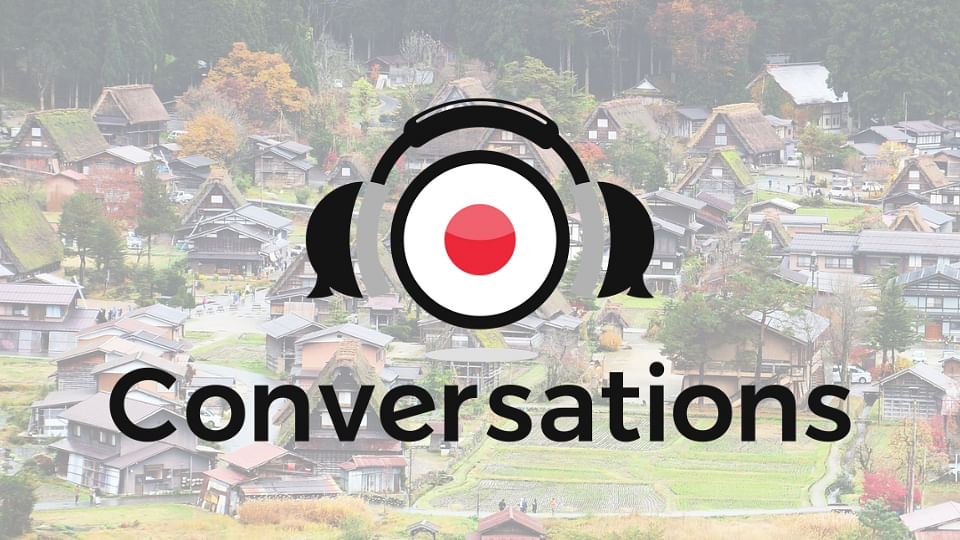
- Conversations – Do you struggle to understand fast, spoken Japanese? Conversations helps you understand real Japanese & transform your listening skills in less than 90 days.
Now You’re Ready To Start Learning Japanese Online!
Follow the tips in this article and you’ll be speaking Japanese in no time!
I’ve provided you with a roadmap and resources to help you on the way, and now the rest is up to you!
The journey to fluency in Japanese is a long one , and the right mindset is important.
Be patient and don’t be discouraged by your mistakes early on. In fact, the more mistakes you make, the faster you’ll find yourself improving.
The study of Japanese is a long journey, but the results are truly worth it.
Japanese has so many hidden treasures to offer learners. Not only does it offer deeper knowledge of Japan and its culture, it also provides possibilities for broadening your own horizons through travel and employment opportunities.
Even more so, learning Japanese will improve you as a person. It will expand your perspective on language, challenge the way you think about your own native language, test your memory and self-discipline, and make you think about things in ways you never have before!
And if you can learn Japanese, you can learn almost any other language! You’ll also have a significant advantage in learning other East Asian languages such as Chinese or Korean. As you can see, learning Japanese comes with plenty of benefits and ways to enrich your life as a whole.
Japanese may seem like an impossible task at first, but I hope you can see that it’s not as hard as you might have thought.
The truth is that you don’t have to be a genius to learn Japanese—you just have to stay motivated, challenge yourself, and practice every day! Time will take care of the rest.
I hope you’ve found this post helpful!
If you have a friend learning Japanese, please take a moment to share this post with them, it would mean a lot to me! (You can click here to send a Tweet!)
I know this is a long post and it’s difficult to take everything in all at once. That’s why I’ve created a special PDF version which you can download and refer to any time you need it! And if you download the PDF, I’ll send you even more tips to help you as you continue learning Japanese.
Click here to download the PDF version of the article and receive more great language learning tips for free.
Recommended Articles
Japanese Pronouns Made Easy
Continue Reading Japanese Pronouns Made Easy
Learn Hiragana: 8 Memorisation Tips & How To Use The Magnetic Memory Method
Continue Reading Learn Hiragana: 8 Memorisation Tips & How To Use The Magnetic Memory Method
Japanese Numbers: How To Count And Talk About Numbers In Japanese
Continue Reading Japanese Numbers: How To Count And Talk About Numbers In Japanese
Language Courses
- Language Blog
- Testimonials
- Meet Our Team
- Media & Press
Download this article as a FREE PDF ?
What is your current level in Swedish?
Perfect! You’ve now got access to my most effective [level] Swedish tips…
Where shall I send the tips and your PDF?
We will protect your data in accordance with our data policy.
What is your current level in Danish?
Perfect! You’ve now got access to my most effective [level] Danish tips…
NOT INTERESTED?
What can we do better? If I could make something to help you right now, w hat would it be?
Which language are you learning?
What is your current level in [language] ?
Perfect! You’ve now got access to my most effective [level] [language] tips, PLUS your free StoryLearning Kit…
Where shall I send them?
Download this article as a FREE PDF?
Great! Where shall I send my best online teaching tips and your PDF?
Download this article as a FREE PDF ?
What is your current level in Arabic?
Perfect! You’ve now got access to my most effective [level] Arabic tips…
FREE StoryLearning Kit!
Join my email newsletter and get FREE access to your StoryLearning Kit — discover how to learn languages through the power of story!
Download a FREE Story in Japanese!
Enter your email address below to get a FREE short story in Japanese and start learning Japanese quickly and naturally with my StoryLearning® method!
What is your current level in Japanese?
Perfect! You’ve now got access to the Japanese StoryLearning® Pack …
Where shall I send your download link?
Download Your FREE Natural Japanese Grammar Pack
Enter your email address below to get free access to my Natural Japanese Grammar Pack and learn to internalise Japanese grammar quickly and naturally through stories.
Perfect! You’ve now got access to the Natural Japanese Grammar Pack …
What is your current level in Portuguese?
Perfect! You’ve now got access to the Natural Portuguese Grammar Pack …
What is your current level in German?
Perfect! You’ve now got access to the Natural German Grammar Pack …
Train as an Online Language Teacher and Earn from Home
The next cohort of my Certificate of Online Language Teaching will open soon. Join the waiting list, and we’ll notify you as soon as enrolment is open!
Perfect! You’ve now got access to my most effective [level] Portuguese tips…
What is your current level in Turkish?
Perfect! You’ve now got access to my most effective [level] Turkish tips…
What is your current level in French?
Perfect! You’ve now got access to the French Vocab Power Pack …
What is your current level in Italian?
Perfect! You’ve now got access to the Italian Vocab Power Pack …
Perfect! You’ve now got access to the German Vocab Power Pack …
Perfect! You’ve now got access to the Japanese Vocab Power Pack …
Download Your FREE Japanese Vocab Power Pack
Enter your email address below to get free access to my Japanese Vocab Power Pack and learn essential Japanese words and phrases quickly and naturally. (ALL levels!)
Download Your FREE German Vocab Power Pack

Enter your email address below to get free access to my German Vocab Power Pack and learn essential German words and phrases quickly and naturally. (ALL levels!)
Download Your FREE Italian Vocab Power Pack
Enter your email address below to get free access to my Italian Vocab Power Pack and learn essential Italian words and phrases quickly and naturally. (ALL levels!)
Download Your FREE French Vocab Power Pack
Enter your email address below to get free access to my French Vocab Power Pack and learn essential French words and phrases quickly and naturally. (ALL levels!)
Perfect! You’ve now got access to the Portuguese StoryLearning® Pack …
What is your current level in Russian?
Perfect! You’ve now got access to the Natural Russian Grammar Pack …
Perfect! You’ve now got access to the Russian StoryLearning® Pack …
Perfect! You’ve now got access to the Italian StoryLearning® Pack …
Perfect! You’ve now got access to the Natural Italian Grammar Pack …
Perfect! You’ve now got access to the French StoryLearning® Pack …
Perfect! You’ve now got access to the Natural French Grammar Pack …
What is your current level in Spanish?
Perfect! You’ve now got access to the Spanish Vocab Power Pack …
Perfect! You’ve now got access to the Natural Spanish Grammar Pack …
Perfect! You’ve now got access to the Spanish StoryLearning® Pack …
Where shall I send them?
What is your current level in Korean?
Perfect! You’ve now got access to my most effective [level] Korean tips…
Perfect! You’ve now got access to my most effective [level] Russian tips…
Perfect! You’ve now got access to my most effective [level] Japanese tips…
What is your current level in Chinese?
Perfect! You’ve now got access to my most effective [level] Chinese tips…
Perfect! You’ve now got access to my most effective [level] Spanish tips…
Perfect! You’ve now got access to my most effective [level] Italian tips…
Perfect! You’ve now got access to my most effective [level] French tips…
Perfect! You’ve now got access to my most effective [level] German tips…
Download Your FREE Natural Portuguese Grammar Pack
Enter your email address below to get free access to my Natural Portuguese Grammar Pack and learn to internalise Portuguese grammar quickly and naturally through stories.
Download Your FREE Natural Russian Grammar Pack
Enter your email address below to get free access to my Natural Russian Grammar Pack and learn to internalise Russian grammar quickly and naturally through stories.
Download Your FREE Natural German Grammar Pack
Enter your email address below to get free access to my Natural German Grammar Pack and learn to internalise German grammar quickly and naturally through stories.
Download Your FREE Natural French Grammar Pack
Enter your email address below to get free access to my Natural French Grammar Pack and learn to internalise French grammar quickly and naturally through stories.
Download Your FREE Natural Italian Grammar Pack
Enter your email address below to get free access to my Natural Italian Grammar Pack and learn to internalise Italian grammar quickly and naturally through stories.
Download a FREE Story in Portuguese!

Enter your email address below to get a FREE short story in Brazilian Portuguese and start learning Portuguese quickly and naturally with my StoryLearning® method!
Download a FREE Story in Russian!
Enter your email address below to get a FREE short story in Russian and start learning Russian quickly and naturally with my StoryLearning® method!
Download a FREE Story in German!
Enter your email address below to get a FREE short story in German and start learning German quickly and naturally with my StoryLearning® method!
Perfect! You’ve now got access to the German StoryLearning® Pack …
Download a FREE Story in Italian!
Enter your email address below to get a FREE short story in Italian and start learning Italian quickly and naturally with my StoryLearning® method!
Download a FREE Story in French!

Enter your email address below to get a FREE short story in French and start learning French quickly and naturally with my StoryLearning® method!
Download a FREE Story in Spanish!
Enter your email address below to get a FREE short story in Spanish and start learning Spanish quickly and naturally with my StoryLearning® method!
FREE Download:
The rules of language learning.

Enter your email address below to get free access to my Rules of Language Learning and discover 25 “rules” to learn a new language quickly and naturally through stories.
What can we do better ? If I could make something to help you right now, w hat would it be?
What is your current level in [language]?
Perfect! You’ve now got access to my most effective [level] [language] tips…
Download Your FREE Spanish Vocab Power Pack

Enter your email address below to get free access to my Spanish Vocab Power Pack and learn essential Spanish words and phrases quickly and naturally. (ALL levels!)
Download Your FREE Natural Spanish Grammar Pack
Enter your email address below to get free access to my Natural Spanish Grammar Pack and learn to internalise Spanish grammar quickly and naturally through stories.
Free Step-By-Step Guide:
How to generate a full-time income from home with your English… even with ZERO previous teaching experience.
What is your current level in Thai?
Perfect! You’ve now got access to my most effective [level] Thai tips…
What is your current level in Cantonese?
Perfect! You’ve now got access to my most effective [level] Cantonese tips…
Steal My Method?
I’ve written some simple emails explaining the techniques I’ve used to learn 8 languages…
I want to be skipped!
I’m the lead capture, man!
Join 84,574 other language learners getting StoryLearning tips by email…
“After I started to use your ideas, I learn better, for longer, with more passion. Thanks for the life-change!” – Dallas Nesbit
Perfect! You’ve now got access to my most effective [level] [language] tips…
Perfect! You’ve now got access to my most effective [level] [language] tips…
Join 122,238 other language learners getting StoryLearning tips by email…
Find the perfect language course for you.
Looking for world-class training material to help you make a breakthrough in your language learning?
Click ‘start now’ and complete this short survey to find the perfect course for you!
Do you like the idea of learning through story?
Do you want…?
How to prepare for JLPT
Starting Your Japanese Language Journey: A Guide for Absolute Beginners
Embarking on the journey of learning a new language is exciting, enriching, and at times, a bit daunting. This is particularly true when the language in question is as fascinating and complex as Japanese. However, with the right approach, learning Japanese can become a rewarding and enjoyable endeavor. In this blog post, we will provide a comprehensive guide for absolute beginners looking to start their Japanese language journey.
Why Learn Japanese?
Before we dive into the how, let’s first explore the why. Japanese is spoken by over 125 million people worldwide, primarily in Japan, but also in Japanese communities globally. Learning Japanese opens the door to a rich culture, steeped in history, and a modern society that is a global leader in technology and innovation. Whether your interest lies in anime, manga, J-pop, samurai culture, or the intricacies of Japanese cuisine, learning Japanese will allow you to engage with these facets on a deeper level.
Understanding the Structure of the Japanese Language:
Unlike many Western languages, Japanese does not use the Latin alphabet. Instead, it uses three scripts: Hiragana, Katakana, and Kanji . Hiragana and Katakana are phonetic scripts consisting of 46 characters each. These characters represent unique sounds, and mastering them is crucial to your Japanese language proficiency. Kanji , on the other hand, is based on the Chinese writing system and is used to represent words or concepts. There are thousands of Kanji characters, but a working knowledge of about 2,000 is needed for daily life in Japan.
Starting with the Basics:
As a beginner, start by learning Hiragana and Katakana. These scripts are the building blocks of the Japanese language and are relatively easier to learn. There are many resources available online, including charts, flashcards, and apps, to help you practice.
Once you’re comfortable with Hiragana and Katakana, you can start learning basic grammar and vocabulary. Remember, the key to learning a new language is consistency. Make it a point to learn and practice a few new words every day.
Understanding Japanese Grammar:
Japanese grammar is significantly different from English. For example, sentences in Japanese follow a Subject-Object-Verb (SOV) structure as opposed to the Subject-Verb-Object (SVO) structure in English. Furthermore, Japanese is a context-heavy language, which means that subjects and objects can often be omitted if they’re understood in context.
Another unique aspect of Japanese grammar is the use of particles. Particles are small words that follow a word or phrase and indicate its function in the sentence. Understanding how to use particles correctly is crucial to forming proper sentences in Japanese .
Exploring Japanese Culture:
Learning a language goes beyond memorizing vocabulary and mastering grammar rules. It’s also about understanding and respecting the culture that language represents. Japanese culture places a great emphasis on respect and politeness, which is reflected in its language. For example, there are different levels of politeness in Japanese , and the level you use depends on your relationship with the listener and the social context.
Learning Japanese Through Immersion:
One of the most effective ways to learn Japanese , or any language, is through immersion. While traveling to Japan would be the ideal scenario, it’s not the only way to immerse yourself in the language. You can watch Japanese movies or anime, listen to J-pop, read manga, or even join a local Japanese language club. The more you expose yourself to the language, the faster you’ll learn.
Conclusion:
Starting your journey to learn Japanese might seem challenging at first, but with the right mindset and resources, it can be a deeply rewarding experience. Remember, learning a language is not a race; it’s a journey to be enjoyed at your own pace. Take your time to understand the nuances, appreciate the culture, and celebrate your progress, no matter how small.
Moreover, learning Japanese is more than just acquiring a new skill. It’s about opening doors to new experiences, understanding a culture that’s different from your own, and connecting with people you might not have otherwise met. It’s about embracing diversity and nurturing a global mindset.
So, whether you’re learning Japanese to watch anime without subtitles, to read a Murakami novel in its original language, to converse with locals on your next trip to Japan, or simply for the sheer joy of learning something new – remember to enjoy the process. Every character you master, every sentence you form, and every conversation you have is a step forward in your language learning journey.
Finally, learning a language can be a transformative experience, and starting your Japanese language journey could be the beginning of an adventure of a lifetime. So, pick up your textbook or download that language app, and say “Konnichiwa” to a new chapter in your life. As they say in Japanese , 頑張って (Ganbatte)! Keep going and good luck!
My Recommendations for your Japanese learning
- Japanese Pod 101 My Honest Review Read more
- JLPT N5 Test Prep-course - The Expert Secret Check Out
Related Posts
Jlpt n5 kanji: 木 (boku, ki) tree, wood.
It is essential to learn Japanese vocabulary when studying the language. In addition to words borrowed from other languages, Japanese…
Japanese Weather Words: Describing the Elements in Japanese
Whether you’re planning a trip, engaging in small talk, or just trying to understand the day’s weather forecast, knowing how…
How to Say ‘How Much Does It Cost?’ and Discuss Prices in Japanese
In everyday life, discussing prices and asking ‘How much does it cost?’ can be essential, whether you’re shopping or inquiring…

The Complete Roadmap to Learning The Japanese Language
%20(1).jpg)
Nowadays, plenty of information, materials, and services are already available, particularly on the internet, to help you learn the Japanese language. With just one click on search engines such as Google, you can now have and gather plenty of learning materials to help you learn. However, despite this abundance of information, finding the right method to learn the Japanese language still can be a difficult task.
In this blog, we will identify the best way of learning the Japanese language by providing you with a complete roadmap. This roadmap can help you to learn the language efficiently and more effectively. There may be other methods of learning Japanese. However, this complete roadmap is one of the fastest and most systematic ways to learn the Japanese language. Let's get into it!
The Complete Roadmap to Learning Japanese
If you are an absolute beginner or a fresh student, this roadmap will save you hundreds of hours of effort and many frustrating moments. Here are the following steps that you should follow:
Step 1: Learn the Japanese Writing System

Learning the Japanese writing system is crucial for anyone who wants to become proficient in the language. Not only will it allow you to read and write in Japanese, but it will also deepen your understanding of the culture and the nuances of the language. There are three scripts used in the Japanese writing system: hiragana, katakana, and kanji. Hiragana and katakana are phonetic scripts that represent syllables, while kanji are Chinese characters that represent meaning.
To learn the Japanese writing system, start by mastering hiragana and katakana. These scripts are used for writing particles, verb endings, and other grammatical structures in Japanese. You can use flashcards, online quizzes, or workbooks to practice reading and writing these scripts until you're comfortable with them.
After learning hiragana and katakana, you can start studying kanji. There are thousands of kanji characters in Japanese, but you don't need to learn them all at once. Start by focusing on the most commonly used characters, and gradually add more to your repertoire over time. You can use textbooks, mobile apps, or online resources to study kanji and practice reading and writing them in context. Once again, we would like to reiterate that learning Kanji, although useful, does not contribute as much to learning Japanese as learning Hiragana and Katakana do during your early stages in mastering Japanese.
To fully master the Japanese writing system, it's important to practice regularly and consistently. Try to read and write in Japanese every day, and use a variety of materials, such as books, manga, and news articles, to improve your skills. You can also practice with Japanese native speakers, who can provide feedback on your writing and help you understand the nuances of the language.
At Japademy, we have created lots of useful handouts that can help you learn Hiragana and Katakana in as short as a week. Just send us an email to [email protected] and we can share these ones with you!
Step 2: Learn the Japanese Grammar

Learning Japanese grammar can initially seem daunting, but it can be a rewarding and enjoyable experience with the right approach and resources. One of the best ways to learn Japanese grammar is by studying the basic sentence structures and word order. Once you understand these fundamentals well, you can start building on your knowledge by learning new grammar concepts and sentence patterns.
To help with your Japanese learning journey, many online resources and textbooks provide detailed explanations and exercises on Japanese grammar. These resources will help you understand the meaning and usage of various particles, verb conjugations, and sentence structures. We recommend you to join our Beginner Japanese Video Courses where we teach you how to use the “wa”, “ga”, “de”, “to” particles and much more!
It's important to practice using what you've learned to master Japanese grammar fully. You can practice writing simple sentences and gradually moving on to more complex ones. You can also use language exchange websites or apps to practice speaking and listening to Japanese with native speakers and receive feedback on your grammar and pronunciation.
Another helpful tip is to learn Japanese grammar in context. This means studying grammar concepts alongside examples from real-life situations, such as conversations or texts. This will help you understand how to use grammar in practical situations and improve your overall comprehension of the Japanese language.
Finally, don't be afraid to make mistakes. Learning a new language, especially grammar, takes time and effort, and making mistakes is a natural part of the process. By approaching Japanese grammar with a positive and curious mindset and practicing consistently, you'll be able to build a strong foundation in the language and achieve fluency in no time!
Step 3: Build Your Japanese Vocabulary

If you wish to communicate effectively in Japanese, then you have to build your Japanese vocabulary. Building your Japanese vocabulary can seem daunting at first, but it can be a fun and rewarding process. One way to start is by learning common words and phrases related to your interests or daily life. For example, if you are a food lover, learn the names of your favorite Japanese dishes. If you enjoy anime, learn the vocabulary used in anime titles or common expressions used by characters. You can also use flashcards, quizzes, or language-learning apps to practice and reinforce new words. At Japademy, we have created lots of useful and engaging Japanese vocabulary flashcards , just send us an email to [email protected] and we can share these ones with you!
Another effective way to improve your Japanese vocabulary is by immersing yourself in the language. This can be done by reading Japanese books, listening to Japanese music or podcasts, and watching Japanese movies or TV shows. By exposing yourself to the language regularly, you will naturally pick up new words and phrases without even realizing it!
Step 4: Practice Listening and Speaking

To become proficient in Japanese, you need to practice listening and speaking skills. Without these skills, you'll struggle to communicate effectively with native Japanese speakers and understand the language in real-life situations. To practice these skills, you can start by listening to Japanese music, watching Japanese TV shows and movies, and engaging with Japanese speakers online or in person.
When it comes to listening, it's important to start with simple conversations and gradually work your way up to more complex content. This will help you develop an ear for the language and improve your comprehension. You can also use apps and websites that provide listening exercises and quizzes to hone your skills.
Additionally, speaking in Japanese is also crucial for learning the language. It's not enough to memorize the vocabulary and grammar rules of the Japanese language. You need to be able to put them into practice in real-life situations. To practice speaking, try to find a language exchange partner or a Japanese language teacher who can help you practice conversation skills. You can also use apps like Duolingo or Memrise that have listening exercises.
Remember that one of the most important things in this step is to be patient with yourself.
Step 5: Improve Your Reading and Writing Skills

Once you have a solid foundation in the basics of the language, it's time to focus on reading and writing skills. In this step, it's important to immerse yourself in Japanese written material as much as possible. This can include reading Japanese books, newspapers, or magazines, as well as practicing writing in Japanese through exercises or journaling.
One effective method for improving your reading skills is to start with simple materials, such as children's books or easy-to-read news articles, and gradually work your way up to more complex texts. As you read, try to identify and memorize new vocabulary words, and make notes of any grammar structures or sentence patterns that you find interesting or challenging.
Writing in Japanese can also be a great way to improve your language skills. You can start by practicing writing basic sentences and gradually move on to more complex texts, such as essays or journal entries. There are also online writing tools and language exchange websites that can help you connect with native Japanese speakers and receive feedback on your writing.
Ultimately, the key to improving your reading and writing skills in Japanese is to practice consistently and persistently. By immersing yourself in the language and practicing regularly, you'll gradually develop the skills and confidence needed to read and write Japanese with ease!
Step 6: Incorporate Japanese into Your Daily Life

Learning Japanese is a long-term commitment, and it's important to make it a part of your daily life. There are many simple and fun ways to do this, no matter where you live or what your daily routine looks like. One easy way to incorporate Japanese into your daily life is to listen to Japanese music or podcasts during your commute or while doing chores. This will help you develop an ear for the language and learn new vocabulary words and expressions.
You can also practice your reading skills by subscribing to Japanese news or entertainment websites and reading articles or reviews in Japanese. This will expose you to new vocabulary and grammar structures, as well as current events in Japan. Another fun way to incorporate Japanese into your daily life is to watch Japanese TV shows or movies with English subtitles. This will help you improve your listening skills and gain a better understanding of Japanese culture.
If you have Japanese friends or colleagues, try to speak with them in Japanese as much as possible and ask them to correct your grammar or pronunciation. This will help you improve your speaking skills and build confidence in using the language. Finally, find opportunities to practice Japanese in your community, such as attending language exchange events or cultural festivals. This will help you meet other Japanese learners and native speakers and provide you with a supportive environment to practice your language skills.
Incorporating Japanese into your daily life doesn't have to be difficult or time-consuming. With a bit of creativity and commitment, you can make learning Japanese a natural part of your everyday routine and enjoy the process along the way!
Step 7: Keep Learning

As we've said earlier, learning a language is a life-long commitment and an ongoing process. There is always something new to learn about the Japanese language. To keep learning, you have to continue to challenge yourself with new vocabulary, grammar structures, and speaking opportunities. You can also attend language exchange events, join online communities, and find new ways to practice and improve your skills. Remember, learning a language takes time and effort, but with patience and dedication, you can become proficient in Japanese!
Bonus: The Best Way To Learn Japanese
Following this roadmap will make your learning experience so much better. However, it still takes a serious amount of time and commitment to find the right resources. If you want to learn Japanese without any chance of failure, we recommend you to join a Japanese Language Course, online or in person, taught by a professional native Japanese teacher. Although it may come at a cost, it will pay off in the long run.
There are several great courses that you can join but since you are already here, we definitely encourage you to have a look at our Japanese Online Lessons for Beginners . Our course has seen over 300 students in the last 12 months who went from absolute beginners to intermediate and advanced levels. Our native Japanese teachers provide you with valuable feedback and guidance on your progress.
Final Thoughts

Learning Japanese is an exciting and rewarding journey that requires dedication, commitment, and patience. By following the complete roadmap to learning Japanese above, you can set yourself up for success and achieve your Japanese language goals. Remember to start with the basics, such as Hiragana and Katakana, and then gradually build up your vocabulary and grammar knowledge.
Additionally, you have to incorporate Japanese into your daily life through various activities, such as listening to music, watching TV shows, and practicing with native speakers. Remember to also focus on your speaking, listening, reading, and writing skills, and use a variety of resources and techniques to make your learning experience fun and engaging. With time and effort, you can become fluent in Japanese and open up a world of opportunities to explore Japanese culture, literature, and business. Good luck on your Japanese learning journey!

Japademy | Learn Japanese

Join our newsletter
- Online Courses (10-weeks)
- Online Private Lessons
- Video Courses
- Japanese Blog
- Japanese Vocabulary
- Self Level Check
- Success Stories
- Privacy Policy


Learn Japanese online with us
If you're traveling to Japan, watching Anime, or need to know Japanese for your job, we can help! With hundreds of lessons, smart tools and a great community, you can learn to read, write and speak Japanese quickly.
Start your Japanese language learning journey with a risk-free 7 day trial now.

Students of All Ages are Simply Raving about Nihongo Master
I’ve worked extensively with foreign language learning materials (primarily Slavic), and I am very impressed at how well the short online learning capsules break down grammatical concepts into short easy explanations that are very approachable for someone with no background in East Asian Languages.
Will Morgan

Master Fluent Japanese for Work, School, Travel, Love, or to Enjoy Pop Culture
Are you moving to or visiting Japan and need to learn Japanese? Or maybe you need to learn it because of work, school, a new relationship, or you simply want to watch your favorite Japanese anime shows without having to read pesky subtitles.
No matter your need or desire to learn the Japanese language, Nihongo Master’s user-friendly online learning platform offers you everything you need in one place. Now you can finally say goodbye to boring language lesson books or tedious online courses, and say hello to a fun, exciting and fully engaging way to learn Japanese!
Japanese Lessons Created by Experts Designed Perfectly For You
Everything you’ll discover inside the Nihongo Master online platform is created by our team of seasoned experts (from young teens to experienced professionals). The goal? To take your skills of reading, writing, and speaking fluent Japanese to the next level – no matter if you’re a total newbie or someone with previous knowledge or experience.
- Parts of speech noun (common) (futsuumeishi) Meaning house; residence; dwelling Example sentence 家 に帰りましょう か 。 Why don't we go home?
24/7 Online Access to Our Advanced Japanese Dictionary
Stuck on the correct meaning, spelling, or usage of a specific word, kanji or phrase?
The Nihongo Master Japanese/English dictionary is here to save you a whole lot wasted time, hassles, and headaches! In a matter of seconds, you can browse the entire Japanese dictionary, create customized study lists, and even test your knowledge with our captivating flash cards.
This simple, yet in-depth dictionary, is available to you online or can be accessed via our handy iOS and Android apps! Explore the dictionary for yourself right now to see everything it has to offer you on your Japanese language journey.
Intelligent SMART Tools That’ll Make Learning Japanese Easy Breezy!
Imagine having access to online tools that could detect what you already know, and where you need to focus next during your Japanese language learning journey?
Luckily for you, now you will, thanks to Nihongo Master! Here's the exclusive learning tools we've created to help you…
Time-Tested Drills
Learn Japanese faster thanks to our time-tested drills that cover everything from grammar, words, and Kanji. Who knew language drills could be so fun?
Customized Study Lists
Create your own customized study lists made with specific words and Kanji that interest you the very most - with a few simple quick clicks!
Writing Practice Sheets
Speaking Japanese is important, but so is writing it. Our practice sheets are designed to help you not only write in Japanese easily, but also correctly.
Join 50,000 Other Students On Your Japanese Learning Journey
Learning Japanese online has never been this simple, this enjoyable or this social! Now instead of learning how to read, write and speak Japanese on your own, you’ll become part of a tight-knit online community who’s here to help fast-track your journey. Get assistance from fellow students or from our amazing team of friendly Japanese language instructors when you need it!
Discussion Groups
Join helpful and relevant discussions around your favorite Japanese topics and make connections with your fellow learners while you're at it!

Leaderboards
Our leader boards are designed to recognise and award outstanding learners daily and weekly.
Member Chat
Member chat is a great way to share ideas with community members in a fast, real time way
Begin your FREE 7-Day TRIAL with any of our 3 subscription plans
What's inside?
- Hundreds of Japanese lessons for beginners to advanced
- Chat with others to practice what you've learned
- Drill system to help you learn words and Kanji quickly
- Dictionary with over 150,000 words and 13,000 Kanji
- Community of friendly Japanese language students
- Customize your drills with words and kanji from our dictionary
- Print customized sheets to practice writing Kanji
- Mobile friendly site to learn on the go
Our online school brings Japan to you
Learn Japanese Online with Nana
Discover all the Japanese language skills you need in one place. From grammar to speaking, we've got you covered!

Total Followers
Why learn with Nana?
Join us on your path to your japanese fluency.
We believe that building confidence is the key to learning a new language. We don’t expect perfection, but we’ll provide you with the skills and support to confidently communicate with native Japanese speakers in real-life situations.
- Learn anytime, anywhere in the world
- Gain confidence with practical lessons
- Get the best personalized support
- Connect with people and culture
- Experience Japan without living in
Self-paced Courses
Crash course 1.

Flexibility Meets Effectiveness! Establish a strong foundation in Japanese with our self-paced course. We will help you learn faster and gain confidence.
What You’ll Learn?
☑ How to start learning Japanese ☑ Japanese reading and writing system ☑ How to read and write hiragana ☑ How to read and write katakana ☑ Introduction to kanji
Private lessons
Book 1 on 1 lessons.
Are you ready to take your Japanese language skills to the next level?
Nana and other dedicated and experienced tutors will customize lessons to your individual needs and goals.
Whether you’re a beginner or an advanced learner, you will improve your speaking skills, expand your vocabulary, and gain confidence in Japanese conversation.
Join our Community
Add fun into your study and achieve more.

Connect with other Japanese language learners and get personal support from Nana in our Discord community.
Stay motivated on your language learning journey and share your progress with us.
What's included :
★ Weekly Video Calls – Boost your speaking skills with Nana and other teachers/ learners.
★ Q&A Support – Get your language-related questions answered with 24 hour support.
★ Group Chat – Stay motivated by connecting with others with real life conversation.
★★FREE for our regular students – If you are enrolled in any of our programs (private lessons or courses), this community is completely free !
Student Reviews
See what others have to say.
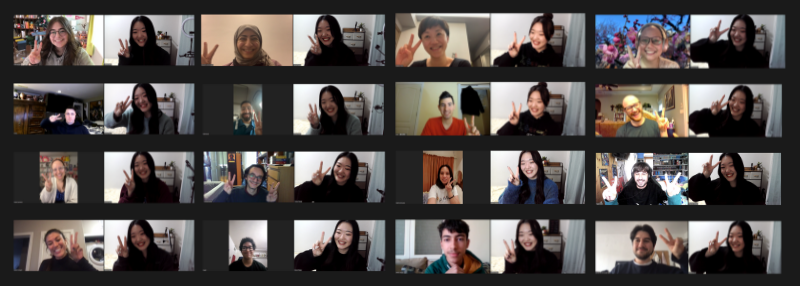
Check out what our students are saying about their experiences with our Japanese language lessons!Reading their reviews can give you a glimpse into the progress they’ve made and the confidence they’ve gained on their language learning journey.
Check out our student reviews
You are not alone on your journey..

Nana's teaching style is engaging and interactive. She provides a variety of speaking activities that are designed to help me improve my pronunciation, intonation, and fluency. Her lessons are always tailored to my specific needs and interests, and she is always willing to adjust the lesson content as necessary.

Nana's speaking lessons are also very practical. She focuses on teaching me useful phrases and expressions that are commonly used in daily conversation. This has helped me to communicate more effectively with Japanese people in both casual and professional settings.

Nana's speaking lessons are truly exceptional. She is an expert at helping her students improve their conversational Japanese skills. Through her lessons, I have gained a lot of confidence in speaking Japanese, and I am able to hold conversations with native speakers more easily.

Read Japanese at any level, effortlessly

Naturally learn Japanese anytime, anywhere, and at your own pace.
Our built-in features make reading and learning Japanese simple and efficient.
Easy Word Look Up
Yomu Yomu offers easy word look up and sentence translations to help learners understand the meaning of Japanese phrases as they read.
Kanji / Hiragana
As you learn Japanese, you may come across unfamiliar kanji. We give you the ability to switch from kanji to hiragana to support your language learning journey.
Japanese phonetics can be difficult to memorize. Turn Romaji on or off to help you read and pronounce Japanese as you learn hiragana, katakana, and kanji.
Pitch Accent
Learning the proper pitch accent of words is essential to sounding like a native speaker. Yomu Yomu will guide you so that you can perfect your pitch accent.
Try it yourself!
Our teachers have curated the most commonly used Japanese words to create engaging stories that keep you reading.

In this short story based on the vocabulary of 250 words, we meet a stray cat who is learning to fend for itself. With no parents, home, or food, join this brave kitty as it learns about the joys and hardships of life on the streets, and the true meaning of home.

Enter the eerie and unsettling world of a reclusive writer and her unexpected visitor, based on Edogawa Ranpo’s short story “The Human Chair”. When a mysterious letter arrives, a young author discovers a confession of crimes from a chair maker who claims to have an intangible connection to his work. Read our JLPT N4 level adaptation of this classic story that uses a vocabulary of 1500 words.
- Help & information
- Privacy & Terms
- yomu yomu © Sinamon AB
- Data sources
FREE - Japanese writing resources!

Let's learn Japanese!
This website is dedicated to provide innovative methods for learning the basics of Modern Japanese language and writing, and find inner peace through the power of writing meditation.
LET'S LEARN JAPANESE !
Modern Japanese
Welcome to our website, where we provide innovative methods for learning the basics of the japanese language and writing. our primary focus is on helping individuals understand the importance of japanese writing and its connection to language comprehension. additionally, we offer the bonus of incorporating meditation practices to enhance your overall learning experience. join us on this unique journey towards japanese language proficiency and inner peace..

Learn Romaji Before You Start Japanese

MODERN JAPANESE
New japanese conversation course.
FREE DOWNLOAD
Japanese Writing Essentials!
Get your free Hiragana & Katakana glyphs here! This downloadable sheet is designed to fit on standard copy paper size (8.5" x 11"), so you can easily print it out. Signup for our newsletter and get the FREE essentials! Start practicing Japanese writing today!
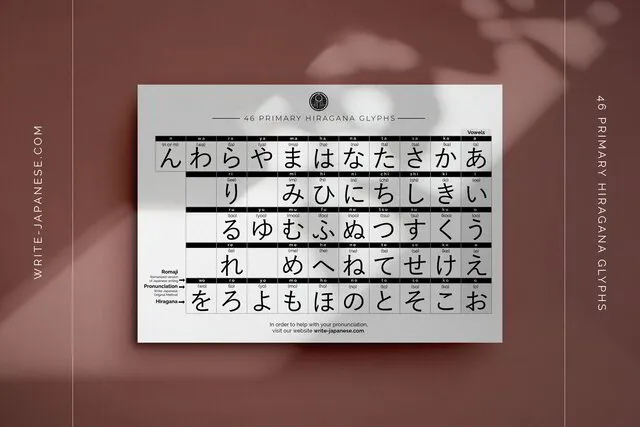
FREE HIRAGANA GLYPHS
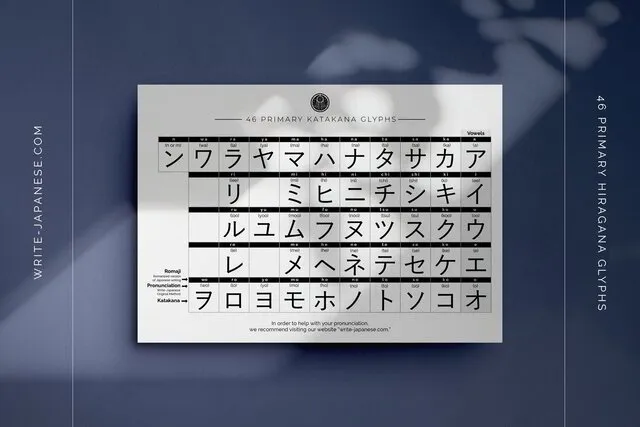
FREE KATAKANA GLYPHS

FREE WRITING WORKSHEET

Write & Learn Japanese
You'll find a variety of resources and tools to help you master the art of writing in Japanese, including lessons on hiragana , katakana , and kanji ; romaji ; and writing exercises. Our writing meditation section, on the other hand, offers guidance and techniques for using meditation to transform your writing practice and unlock your inner peace. Whether you are a beginner or an experienced learner, we have something for you. Start exploring and start learning today!
Let's Learn to Write Japanese!
The Japanese writing system is made up of three different scripts: hiragana , katakana , and kanji . In addition to these three scripts, the Japanese writing system also includes the use of romaji , or the Romanization of Japanese, for certain purposes such as inputting Japanese text on a keyboard for computer or phone and to read and pronounce words correctly.
Before diving into the complexities of hiragana , we highly suggest starting with romaji. Romaji uses the Roman alphabet to represent Japanese words, will aid in reading and pronunciation and make typing in Japanese on your computer or phone a breeze. By mastering romaji first, you'll have a solid foundation to build upon as you continue your Japanese language journey.

Hiragana is the main phonetic writing system used to represent every distinct sound in Japanese. We recommend you to learn hiragana first, and also, learn how to pronounce all these in the Japanese language.

Katakana has the same sounds as hiragana . It is mainly used to represent words imported from other languages; such as "Website", "Google", "Banana", and people's names, etc.
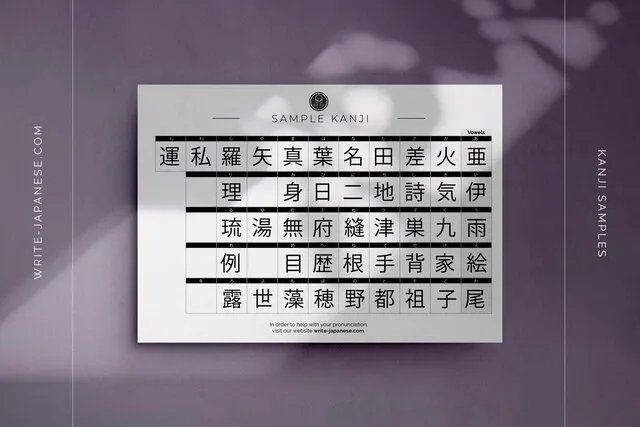
Most words in Japanese are written in kanji . Kanji are Chinese characters adapted for Japanese. They are heavily used in writing, and it has been evolving with Japan’s culture over the years.
A guided writing meditation
Free download.
A writing meditation will help you clear your mind, and connect to your inner self. It can also be used as a way to work through some of the emotions that you are feeling in the moment.

Shop Japanese Writing Textbooks
--------------, master japanese writing with our beautifully created textbooks, our " hiragana i " & " katakana i " book includes 46 primary phonetics to practice, while " hiragana ii " & "katakana ii" includes 30 dakuon/handakuon and 39 yo-on., all books are available in left-handed versions as well., improve your japanese reading and writing skills with our fun and effective practice worksheet books., kanji textbooks are coming soon, free audio download .

ONE WORD A DAY PRACTICE WORKBOOK

One Word A Day Practice Hard Cover in Beige
One Word A Day Japanese Practice
Hard Cover in Beige

One Word A Day Practice Hard Cover in Midnight
Hard Cover in Midnight
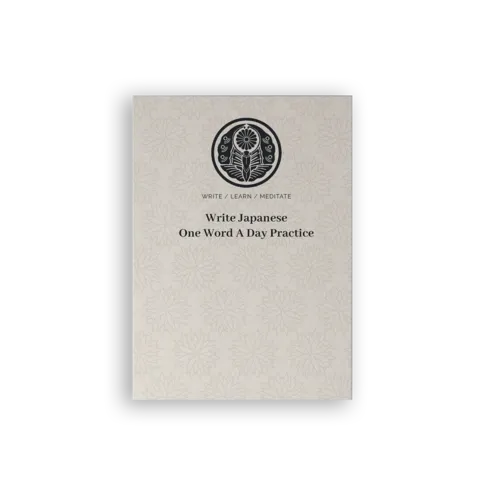
One Word A Day Practice Soft Cover in Beige
Soft Cover in Beige

One Word A Day Practice Soft Cover in Midnight
Soft Cover in Midnight
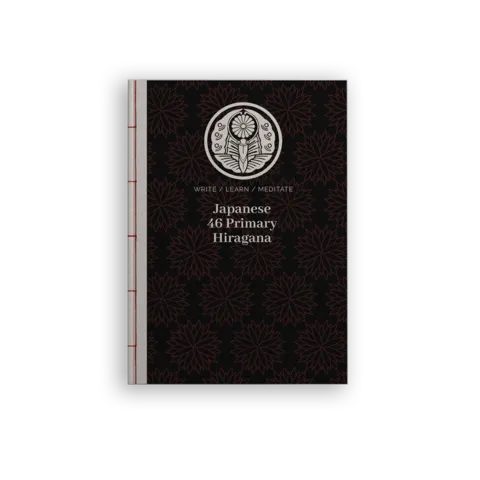
Japanese Primary Hiragana Hard Cover
Japanese Primary Hiragana

Japanese Primary Hiragana Soft Cover

Japanese Primary Hiragana For Lefty Soft Cover
Japanese Primary Hiragana for Lefty
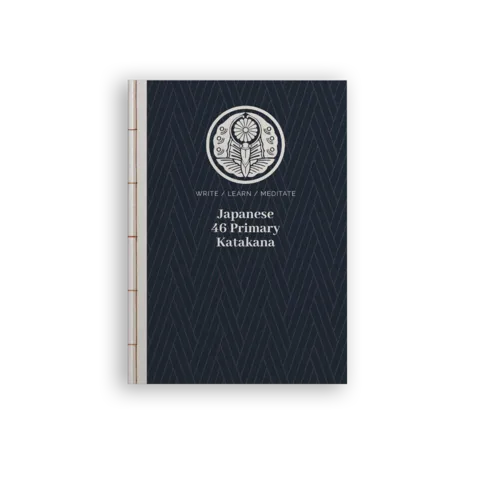
Japanese Primary Katakana Hard Cover
Japanese Primary Katakana
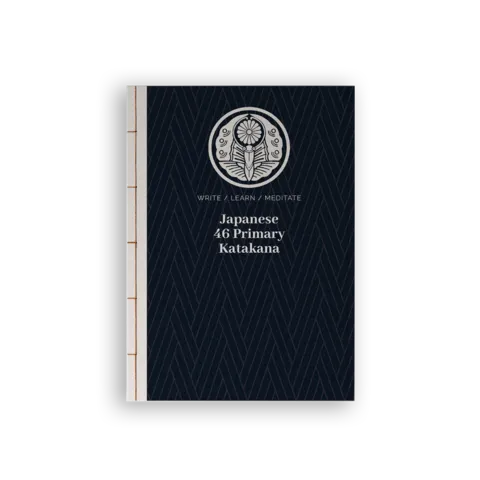
Japanese Primary Katakana Soft Cover
The write path.
A Blog About Writing, Learning, and Meditating in Japanese. Read More Blog Posts ↗
Read More Blog Posts ↗

Online Worldwide Learning OWL Ja panese Lessons

Personalized
Online Japanese
Customized & Effective Lessons
Embark on an exciting exploration of learning Japanese with us! What fuels your desire to master this incredible language? Whether it's for navigating business interactions, immersing yourself in Japanese travel experiences, conquering the JLPT, or refining your pronunciation at an intermediate or advanced level — we've got you covered.
Our one-on-one lessons are a unique blend of creativity and tailored precision. From upper-beginner to advanced levels, we craft lessons that resonate with your individual needs and aspirations. Learning Japanese is an adventure, and we're here to make it both enjoyable and interactive.
Begin your Japanese language journey today! Join us, and let a certified professional Japanese teacher guide you to fluency, boosting your confidence every step of the way. Let's make your language experience thrilling and enriching!
2 024 Lesson Calendar
Winter Session 1/ 8 -3/22
Spring Sess ion 4/1-6/ 7
Summer Session 7/8 -8/31
Fall Session 9/9-12/20

N aoko / Lead Instructor
Naoko is a certified Japanese teacher with a B.A. in Humanities, specializing in Literature. She completed the 420-hour Advanced Japanese Teacher Training Course and the Japanese Pronunciation for Communication course. In 2010, she relocated to the U.S. and commenced her teaching journey in 2015, tutoring at e-learning firms. Presently, she serves as the principal of OWL Japanese Lessons, offering online instruction in Japanese language and culture worldwide. She specializes in business Japanese and provides guidance for JLPT test preparation.
Introducing Special Guest Speakers for This Spring Session!

Daniel has studied Japanese for over eight years, including one year at Foreign Language College in Fukuoka, Japan. He passed the highest level of the JLPT, the N1, and is currently a Graduate Teaching Assistant for Japanese at the University of Washington. He has also studied Japanese-to-English translation at Japan Visualmedia Translation Academy. Daniel holds a Master of Computer Science from Michigan State University and worked as a software engineer at Microsoft.

Learning Japanese Guideline for beginner

Learn Japanese Alphabet
Learn Kanji
Learn common Japanese phrases
Explore Japanese Guideline
LET'S LEARN JAPANESE
Table of contents.
- Starting your adventure
- Setting the stage
- Hiragana Basics
- Typing Hiragana in Mobile
- Mastering Katakana
- Guideline for beginners
- Kanji Overview
- Kanji Radical
- On-yomi vs Kun-yomi
- Typing Kanji on Mobile
- Build your words deck
- The SRS Method
- Grammar Foundations
- Self-Guided Grammar Adventures
- Occasional Hurdles
- Choosing Your Companion
- Solo or Supported
- Resource Roundup
- Stepping into Intermediate Territory
Welcome to Your Japanese Journey
Hey there, friend! Welcome to your exciting Japanese adventure! 🎉 I'm thrilled that you've decided to embark on this journey, and trust me, it's going to be an incredible ride filled with new discoveries, challenges, and lots of fun!
Starting your adventure: Keep an open mind and excitement.
First things first, keep that sense of wonder and excitement burning bright within you! Learning Japanese is like unlocking a door to a whole new world, so approach it with an open mind and a heart full of curiosity. Embrace the beauty of the language and culture, and you'll find yourself falling more in love with it every day.
Setting the stage: Goals and mindset for a successful journey.
Let's talk about goals! What are you hoping to achieve on this journey? Whether it's mastering conversational Japanese, understanding anime without subtitles, or simply being able to order sushi like a pro, having clear goals will keep you motivated and focused along the way. And remember, it's not just about reaching the destination, but enjoying every step of the journey. So, let's dive in with positivity and determination!
Unlocking the Japanese Alphabet: Hiragana & Katakana
Let's talk about Hiragana—it's like Japan's special alphabet, the first step on our journey to becoming Japanese reading champs!
Hiragana basics: Your first steps into reading, writing and typing Japanese.
Now, don't worry if you're feeling a bit overwhelmed with the idea of learning a whole new writing system. We've got this together, and I'm here to cheer you on every step of the way.
So, why start with Hiragana? Well, it's kind of like the foundation of the Japanese language. Think of it as the soil from which our language garden grows. Without it, we'd be lost in translation!
I know some folks might say it takes ages to get the hang of Hiragana, but guess what? We're not going to follow that slow lane. Instead of spending weeks doodling each Hiragana character, we'll use some cool tricks and tools to speed up our learning process.
Imagine this: with the help of funny games and handy worksheets, you could be reading Hiragana by tonight! Yes, seriously!
With MochiKana support, we're going to tackle both reading and writing Hiragana at the same time! Now, I know it might sound like a double whammy, but trust me, it's going to work wonders for us.
See, by practicing both skills together, we'll reinforce our understanding of Hiragana even faster. Sure, it might be a tad challenging at first, but hey, that's where the fun is, right?
So, let's jump right in and start decoding those hiragana characters. We'll read them, write them, and watch our skills skyrocket together. I promise you, this approach will make our learning journey all the more exciting and rewarding. With our approach, you'll crack the code of Hiragana in just a day or two, instead of dragging it out for a month. Let's do this! 🚀
Let's do this:
Using MochiKana Mobile App to learn typing Hiragana quickly:
So, what do you say? Ready to tackle Hiragana together and unlock a whole new world of Japanese language and culture? Let's do this! 🎉
Hiragana works sheet
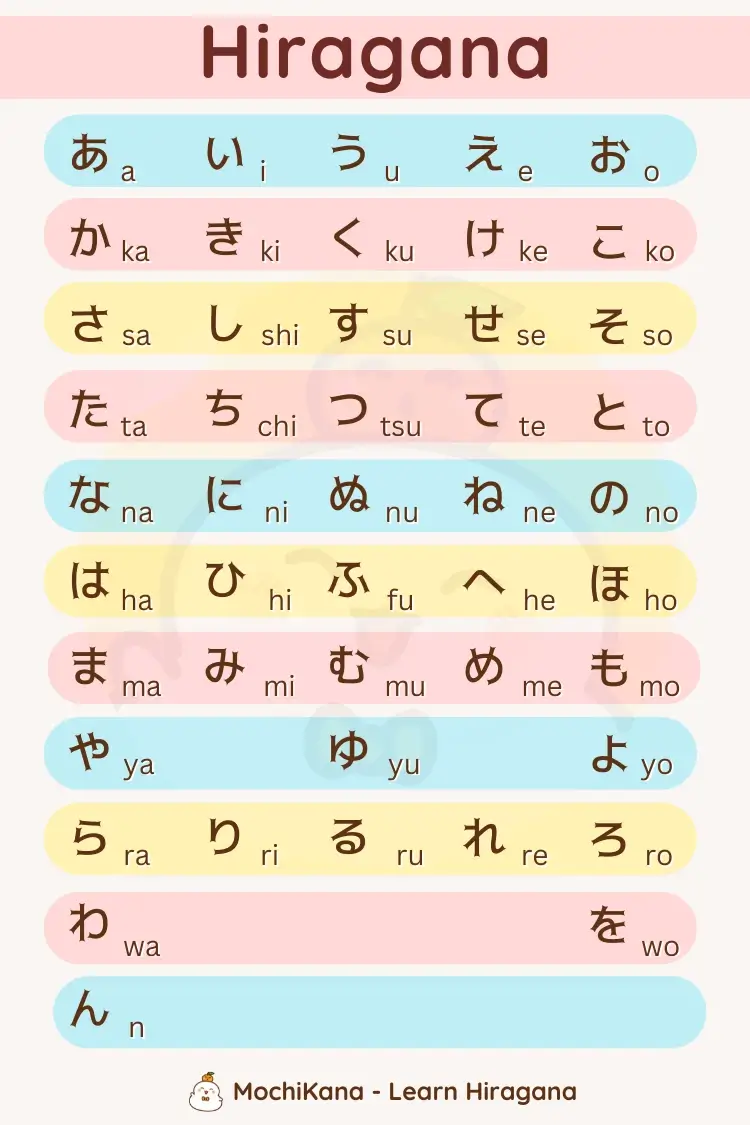
Typing Hiragana in Mobile: Using Romaji is the easiest method
Although I'm a lover of writing Hiragana and Kanji, most of our writing is done on keyboards these days, right? By mastering typing Hiragana, along with a bit of Katakana and Kanji down the line, we'll cover the vast majority of modern writing needs.
And here are the few steps to typing Hiragana on your Mobile:
- Enable the Japanese Keyboard: First, you'll need to enable the Japanese keyboard on your mobile device. You can usually do this through the settings menu under "Language & Input" or "Keyboard Settings."
- Type using Romaji: In the Japanese keyboard, you'll type using Romaji, which is the Romanized version of Japanese characters. For example, type "a" to get あ, "ka" to get か, and so on. The keyboard will automatically convert your Romaji input into Hiragana characters.
- Choose the correct character: Sometimes, the keyboard will offer suggestions for Kanji or Katakana characters based on the context of your sentence. You can select the desired character from the suggestions bar that appears above the keyboard.
Practice Makes Perfect! Like anything worth learning, typing in Japanese takes practice. But hey, we're in this together! Keep at it, and soon enough, you'll be zipping through your Japanese messages like a pro.
Mastering Katakana: Step-by-step guide to reading, typing and writing Katakana.
Understanding the Difference: Hiragana vs. Katakana
Katakana is like the cool cousin of Hiragana. While Hiragana is used for native Japanese words and grammatical elements; Katakana has a sharper, more angular look, reflecting its role in representing foreign words, loanwords, and technical terms. You'll often find Katakana used for words borrowed from other languages, like "コーヒー" (koohii) for coffee or "アメリカ" (amerika) for America. Its distinct appearance sets it apart and signals that you're dealing with non-native vocabulary.
Guideline to Learn Katakana:
- Get Familiar with the Characters: Katakana characters may look a bit different from Hiragana, but trust me, they're just as friendly once you get to know them! Start by familiarizing yourself with the basic Katakana characters and their sounds.
- Learn the Stroke Order: Just like with Hiragana, mastering the stroke order of Katakana characters is key to writing them beautifully. Take your time to practice writing each character following the correct stroke order.
- Associate Sounds with Images: Katakana characters can sometimes resemble the sounds they represent. For example, ソ (so) might remind you of a "sore" shape. Use these visual associations to help you remember the sounds of each character.
- Practice, Practice, Practice: The more you practice, the easier it gets! Set aside some time each day to review and practice writing Katakana characters. You can use worksheets, online resources, or even write Katakana versions of your favorite words.
- Use Mnemonics and Memory Aids: Mnemonics, memory aids, and association techniques can be your best friends when learning Katakana. Create fun stories or visual images to help you remember the shapes and sounds of each character.
- Apply What You Learn: As you progress, start looking for Katakana characters in the wild! Keep an eye out for Katakana words on signs, packaging, and menus. The more you encounter Katakana in real-life situations, the more it will solidify in your memory.
- Stay Positive and Patient: Learning Katakana might feel a bit overwhelming at times, but remember, every step you take brings you closer to your goal. Stay positive, be patient with yourself, and celebrate your progress along the way!
- Learn to read and write Katakana together
- Using MochiKana Mobile App to learn typing Katakana quickly
- Mochikana IOS App
- MochiKana Android App
Katakana works sheet
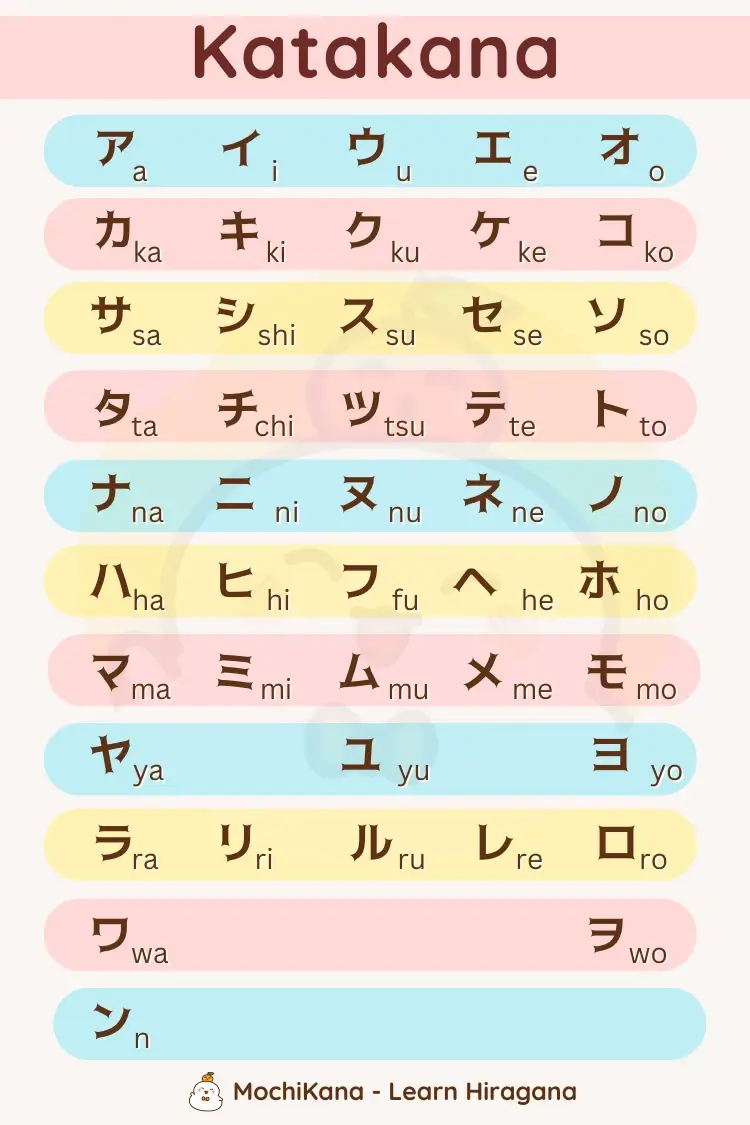
Remember, we're in this together, my friend! So let's roll up our sleeves, dive into learning Katakana, and unlock a whole new world of Japanese language and culture. You've got this! 🌟
Japanese Pronunciation
Japanese pronunciation is characterized by its relatively simple sound system and syllable structure.
Overview: Understanding the basics of Japanese pronunciation.
1. Vowels: Japanese has five vowel sounds: "a," "i," "u," "e," and "o." These vowels are pronounced consistently, with each having a single, clear sound.
2. Consonants: Japanese consonants are generally pronounced as in English, with a few exceptions:
- "R" sound: Japanese "r" is a single flap sound, similar to the "d" sound in "butter" or "latter."
- "S" sound: Japanese "s" is always pronounced as in "sun," never as in "rose."
- "Tsu" sound: The small "tsu" (っ) indicates a geminate or double consonant sound, where the following consonant is held for a slightly longer duration.
3. Syllable Structure: Japanese syllables follow a strict pattern of consonant-vowel (CV) or vowel-consonant-vowel (CVC) combinations. For example, "ka," "ki," "ku," "ke," and "ko" are CV syllables, while "kaki," "kiku," "kake," and "koko" are CVC syllables.
4. Pitch Accent: Japanese also has pitch accent, where certain syllables in a word are pronounced with a higher or lower pitch. However, pitch accent is generally less important for beginner learners and can be acquired naturally over time through exposure to spoken Japanese.
Guideline for Beginners: 7 steps to master Japanese Pronouncation
Here's a step-by-step guideline to help beginners improve their Japanese pronunciation:
- Master the Vowel Sounds: Start by familiarizing yourself with the five Japanese vowel sounds: "a," "i," "u," "e," and "o." Practice pronouncing them clearly and consistently.
- Learn Hiragana and Katakana: Since each Hiragana and Katakana character represents a syllable, learning these scripts will help you understand and pronounce Japanese words accurately.
- Listen and Repeat: Listen to native speakers of Japanese and try to imitate their pronunciation. Pay attention to the rhythm and intonation of spoken Japanese.
- Practice Basic Words and Phrases: Start with simple Japanese words and phrases and practice pronouncing them aloud. Use resources like language apps, textbooks, or online tutorials to find beginner-friendly vocabulary lists.
- Record Yourself: Record yourself speaking Japanese and listen back to identify areas for improvement. Notice any differences between your pronunciation and that of native speakers, and work on adjusting accordingly.
- Be Patient and Persistent: Like any skill, mastering Japanese pronunciation takes time and consistent practice. Be patient with yourself and celebrate your progress along the way.
- Seeking Feedback and Persistence: Don't be shy to ask for tips from language buddies or tutors. Keep chatting and practicing regularly to improve. Stick with it—embracing challenges and staying dedicated will speed up your progress!
- Let's try to learn some common Japanese phrases and conversations
- Practice with MochiKana Mobile App
By following these steps and dedicating time to regular practice, you'll gradually improve your Japanese pronunciation and feel more confident speaking the language. Remember, every effort you put in brings you closer to fluency!
Exploring Kanji
Kanji are the beautiful and intricate characters borrowed from Chinese characters, used in Japanese writing. They represent words, ideas, and even entire concepts, making them an essential part of the Japanese language. Think of them as little puzzles waiting to be solved!
Kanji overview: Unveiling the mysteries of Kanji and its significance.
Guideline to learn Kanji
- Start with Basic Kanji: Begin your journey by focusing on the most commonly used Kanji characters. These are the building blocks of the language, so mastering them will give you a solid foundation to build upon. Start with simple characters that appear frequently in everyday words.
- Learn Stroke Order: Just like with Hiragana and Katakana, mastering the stroke order of Kanji characters is crucial. This not only helps you write them neatly but also aids in memorization. Take your time to practice writing each stroke in the correct order.
- Understand Radicals: Kanji characters are often composed of smaller components called radicals. Understanding these radicals can help you break down complex characters into simpler parts, making them easier to remember. Think of it as solving a puzzle!
- Use Mnemonics and Memory Tricks: Kanji can be tricky, but they're also full of stories waiting to be told. Create mnemonics or visual images to associate with each character to make them more memorable. The more creative, the better!
- Practice, Practice, Practice: Repetition is key when it comes to learning Kanji. Set aside dedicated time each day to review and practice writing Kanji characters. Use flashcards, worksheets, or online resources to reinforce your learning.
- Read, Read, Read: Exposure to Kanji in context is essential for mastery. Start reading simple texts, children's books, or manga with furigana (small hiragana characters above the Kanji) to help you along. The more you read, the more familiar Kanji will become.
- Stay Consistent and Patient: Learning Kanji is a marathon, not a sprint. Be patient with yourself and celebrate your progress along the way. Consistency is key, so keep at it, and you'll be amazed at how far you've come!
Using MochiKanji Mobile App to learn Kanji easier:
Kanji radical: Easy strategies to begin your Kanji journey.
Kanji radicals are the building blocks of Kanji characters. They are the smaller components or elements that make up more complex Kanji characters. Think of them as the Lego pieces that you can put together to form different structures.
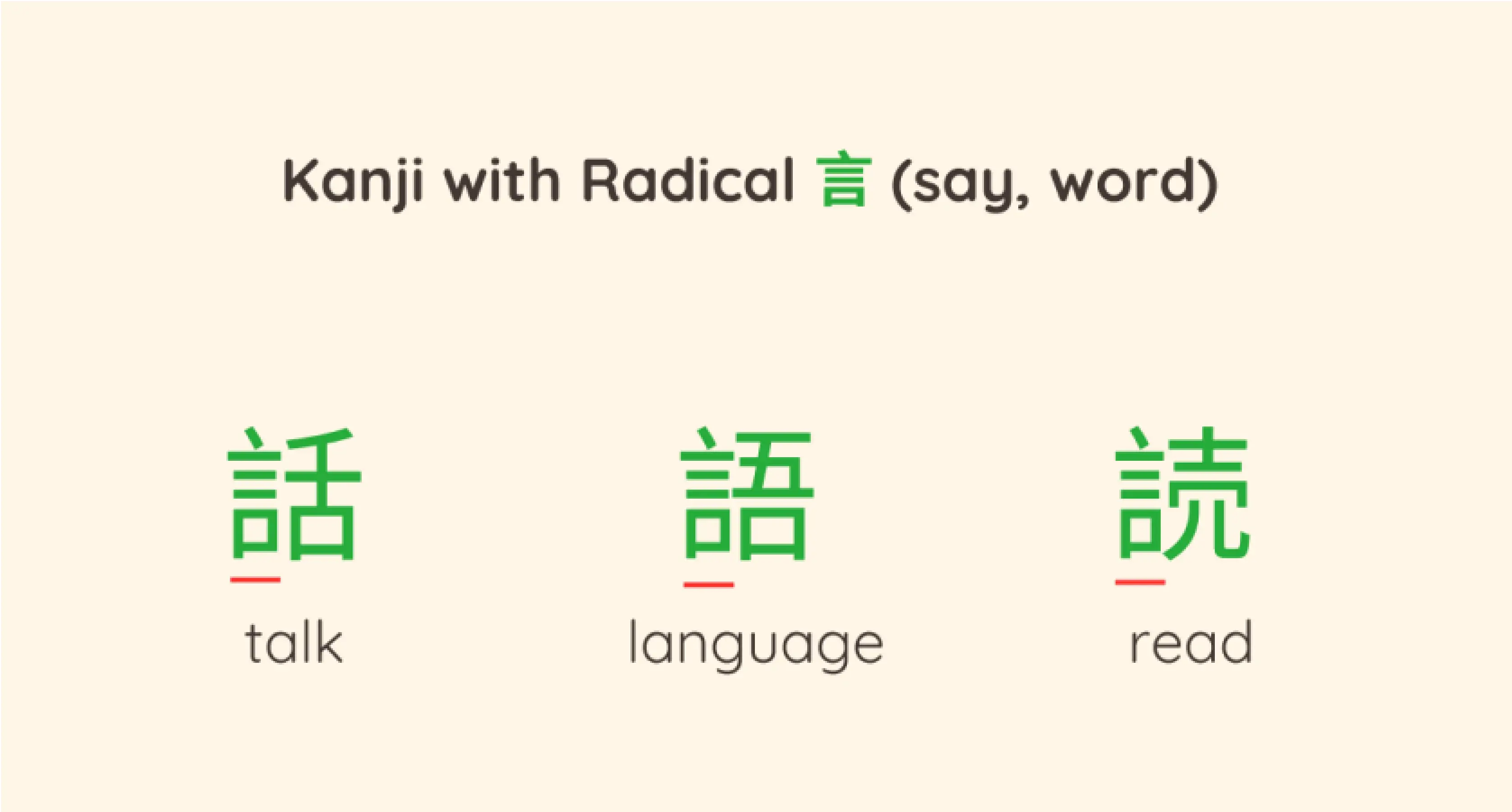
Why are Kanji radicals important?
Understanding Kanji radicals is crucial for several reasons
- Breaking Down Complexity: Kanji characters can be quite complex, but radicals help break them down into smaller, more manageable parts. By recognizing radicals, you can better understand the structure and meaning of Kanji characters.
- Aiding Memorization: Memorizing hundreds or even thousands of Kanji characters can seem daunting, but radicals provide a systematic approach. By learning common radicals and their meanings, you can more easily remember and recognize Kanji characters.
- Enhancing Vocabulary: Many radicals have meanings or associations that carry over into the characters they form. By understanding radicals, you can often guess the meaning of unfamiliar Kanji characters based on the radicals they contain, thus expanding your vocabulary.
Common Kanji radicals:
There are hundreds of Kanji radicals, but some are more common and recurring than others. Here are a few examples of commonly encountered radicals:
- 人 (ひと) - "Person" radical. Examples: 会 (meeting), 仕 (to do), 休 (rest).
- 口 (くち) - "Mouth" radical. Examples: 口 (mouth), 味 (flavor), 同 (same).
- 木 (き) - "Tree" radical. Examples: 本 (book), 林 (woods), 森 (forest).
- 日 (ひ) - "Sun" radical. Examples: 明 (bright), 曜 (day of the week), 時 (time).
- 水 (みず) - "Water" radical. Examples: 河 (river), 波 (wave), 汽 (vapor)
Learning Kanji radicals:
Here's how you can start learning Kanji radicals:
- Study Common Radicals: Begin by familiarizing yourself with common radicals and their meanings. You can find lists of radicals in Kanji dictionaries or online resources.
- Practice Recognition: As you encounter Kanji characters, try to identify the radicals within them. Pay attention to how radicals contribute to the meaning or pronunciation of the characters.
- Create Mnemonics: Some radicals can be quite abstract, so creating mnemonic devices or visual associations can help you remember them more easily.
- Use Radical-Based Learning Resources: There are resources available that teach Kanji characters based on their radicals. These resources often provide mnemonics, example words, and practice exercises to reinforce learning.
- Practice writing Kanji
- Using Mochikanji mobile app to learn Kanji easier
- MochiKanji IOS App
- MochiKanji Android App
By understanding Kanji radicals, you'll gain insight into the structure and meaning of Kanji characters, making the process of learning and memorizing them much more manageable. So, embrace the power of radicals, and let them guide you on your Kanji-learning journey!
On-yomi vs Kun-yomi: What are the differences!
On-yomi (音読み):
- What: Pronunciations borrowed from Chinese.
- Where: Used in compound words, especially those of Chinese origin.
- Example: 大 (big) can be pronounced as "dai" or "tai" in compound words like 大人 (adult).
Kun-yomi (訓読み):
- What: Native Japanese pronunciations based on meaning.
- Where: Used in native Japanese words and expressions.
- Example: 大 (big) can be pronounced as "ookii" in words like 大きい (big).
- On-yomi: Chinese-based, used in compounds.
- Kun-yomi: Japanese-based, used in native words.
- Understanding both helps in reading Japanese text effectively.
How many Kanji should you learn?
While there are technically more than 50,000 kanji characters, there is something known as the Joyo kanji (常用漢字). Joyo kanji refers to a list of kanji characters that are designated as “regular-use kanji” by the Japanese government. The term “Joyo” (常用) translates to “regular use” or “daily use.” However, to be considered fluent in Japanese, you only need to know 1,500 to 2,500 kanji — roughly N2 or N1 level. As you improve your Japanese language skills, you’ll notice that it’s easier to read texts with kanji than texts with just Hiragana and Katakana. Why? Kanji characters provide visual cues and help break up the text into meaningful units. So let's get started to find tips that help you to learn Kanji effectively!
How to learn Kanji? (Tips, methods, materials)
There’s a common misunderstanding that Kanji is a separate part of Japanese alongside vocabulary and grammar. No, it’s not. Kanji is basically the written form of words, and it only makes sense to learn them in the context of a word, not in a vacuum.
Kanji have multiple readings and meanings but you are not required to memorize all of them if you acquire them through vocabulary. For instance, the Kanji character “先”: In the word 先生 meaning teacher, the Kanji “先” is pronounced as “せん - sen,” while in the word “先ず” meaning first, it is pronounced as “ま - ma.”
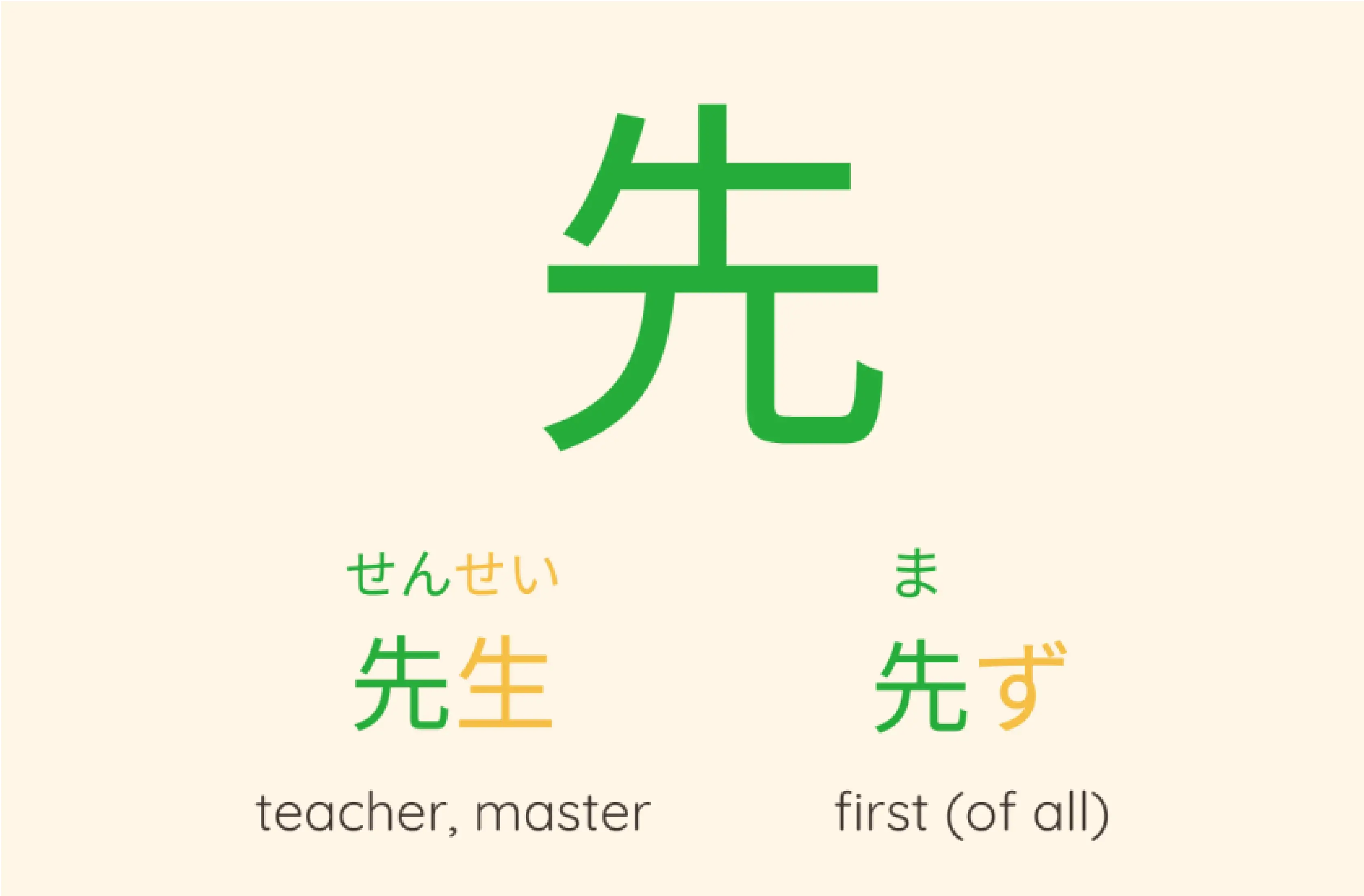
Furthermore, when learning vocabulary and Kanji at the same time, you could guess the meaning of a word. The side effect of this is that you'll start to pick up on the meaning of the kanji in the words you're learning. I think I responded to you or someone else in that thread but it's like how you'll see that in 最高, 最悪, 最低 they all share the same 最 kanji, which you might look up out of curiosity, and find that it means 'most/highest/extreme'. You'll easily be able to recognize and remember this meaning in any new words you come across containing it, and usually have a good guess at what the word itself means.
Typing Kanji on mobile: Step by step to type Kanji on mobile phone.
Ready to make typing Kanji on your mobile device a breeze? With a few simple steps, you'll be composing messages and texts in Japanese like a pro. Let's walk through the process together, making it easy and enjoyable. Here's how to get started!
- Enable Japanese Keyboard: Go to your phone's settings, add the Japanese keyboard under "Language & Input."
- Switch to Japanese keyboardt: While typing, switch to the Japanese input mode by tapping the globe or language icon on your keyboard until you see "日本語" or "あ"
- Type Using Romaji: In Japanese input mode, type using Romaji (English letters). For example, "tai" for 大 (big) or "eki" for 駅 (station).
- Select Kanji from Suggestions: As you type, your keyboard will suggest Kanji characters based on the Romaji input. Tap the desired Kanji from the suggestions bar above the keyboard.
- Confirm and Continue: Once you've selected the Kanji you want, tap it to confirm, and continue typing or composing your message.
Mastering Kanji & Vocabulary with Spaced Repetition
Build your words deck: gathering words to expand your lexicon..
Gathering words is like collecting treasures for your language journey. Start by immersing yourself in Japanese media you enjoy, like anime, manga, or movies, and jot down any unfamiliar words. Websites and apps like MochiMochi are fantastic resources for discovering new vocabulary. Create your own word deck tailored to your interests and learning goals. The more words you gather, the richer your Japanese lexicon will become.
The SRS Method: A magical tool for memory.
Spaced Repetition System (SRS) is your secret weapon for efficient and effective learning. It's based on the scientifically proven principle that spaced intervals of repetition optimize memory retention. Here's how it works: as you review words in your deck, SRS algorithms determine the optimal timing for future reviews based on how well you remember each word. Words you struggle with appear more frequently, while those you ace are reviewed less often. This ensures you focus your efforts where they're needed most, maximizing your learning potential.
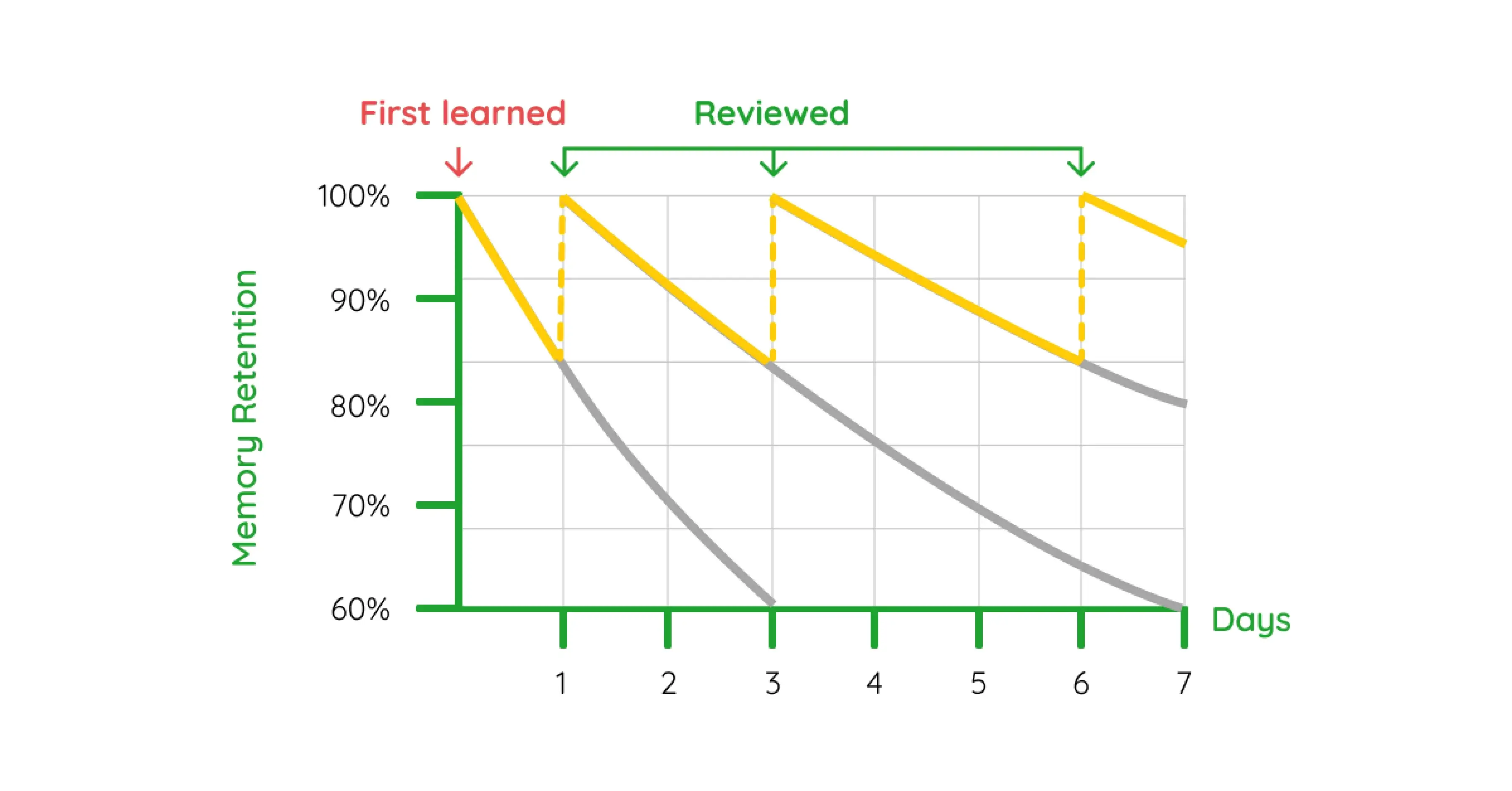
Try MochiMochi - the best app for learning Kanji and Japanese Vocabulary with SRS method:
SRS Tips: For effective SRS practice.
- Consistency is Key: Set a daily routine for reviewing your word deck. Even just a few minutes each day can yield significant results over time. Make it a habit, like brushing your teeth or having your morning coffee.
- Mix It Up: Keep your learning fresh by mixing new words with ones you've already mastered. Don't just stick to one source or type of word—variety is key to building a well-rounded vocabulary.
- Use Mnemonics: Get creative with memory aids to help reinforce difficult words. Create vivid stories, visual images, or memorable associations that make the word easier to remember. The more outrageous or absurd, the better!
- Stay Positive: Learning a new language can be challenging, but don't let setbacks discourage you. Celebrate your progress, no matter how small, and recognize that every step forward is a step closer to fluency.
- Challenge Yourself: Don't shy away from difficult words. Embrace the challenge and view it as an opportunity for growth. Push yourself outside your comfort zone and tackle words that stretch your abilities. You'll be amazed at how quickly you improve when you challenge yourself.
By harnessing the power of spaced repetition and incorporating these tips into your practice routine, you'll unlock the full potential of your Japanese learning journey. So gather your words, fire up your SRS tool, and let's embark on this adventure together. Your Japanese fluency awaits! 🌟
The Grammar Gateway for beginner
Grammar foundations: building blocks for constructing sentences..
Think of grammar as the scaffolding that supports your language skills. Start by mastering basic sentence structures and essential grammar points, like subject-object-verb order and basic sentence endings. Practice constructing simple sentences using these building blocks until they become second nature. Don't worry about getting everything perfect right away—learning is a journey, not a race!
Self-guided Grammar Adventures
Ready to embark on your grammar journey? Explore resources like textbooks, online tutorials, and language apps to discover new grammar concepts. Take it one step at a time, focusing on one grammar point at a time to avoid feeling overwhelmed. Use examples, exercises, and practice drills to reinforce your understanding. And remember, it's okay to make mistakes—each one is a chance to learn and grow!
Occasional Hurdles: Accepting and overcoming learning plateaus.
Learning plateaus are a natural part of the language learning process. Accept them as temporary roadblocks rather than insurmountable barriers. When you hit a plateau, take a step back and assess your progress. Are there areas of grammar you need to review or concepts you need to reinforce? Adjust your study approach as needed and keep pushing forward. With perseverance and determination, you'll overcome any hurdle that comes your way!
Additional tips:
- Immerse Yourself: Surround yourself with Japanese as much as possible. Watch Japanese movies, listen to Japanese music, and engage with native speakers whenever you can. Immersion is one of the most effective ways to internalize grammar patterns and natural language usage.
- Practice, Practice, Practice: The more you use grammar in context, the better you'll understand it. Practice writing and speaking Japanese regularly, even if it's just journaling about your day or chatting with a language partner. The more you practice, the more confident you'll become in applying grammar rules.
- Stay Motivated: Learning Japanese is a marathon, not a sprint. Celebrate your progress along the way, no matter how small. Set realistic goals and reward yourself for achieving them. And most importantly, don't forget to have fun! Learning a new language should be an enjoyable experience, so find ways to make it engaging and exciting for yourself.
Remember, my friend, you're on an incredible journey of discovery and growth. Embrace the challenges, celebrate the victories, and never lose sight of your ultimate goal: becoming fluent in Japanese. Together, we'll navigate the grammar gateway and emerge stronger and more confident than ever before! 🚀
Enriching Your Learning Experience
Choosing your companion: selecting the right textbook or program..
Selecting the right textbook or program is like finding a loyal travel buddy for your language journey. Look for resources that align with your learning style, whether you prefer structured lessons or more interactive approaches. Consider factors like clarity of explanations, variety of exercises, and supplementary materials like audio recordings or online resources. Don't be afraid to try out different textbooks or programs until you find the one that feels like the perfect fit.
Q&A Haven: Getting answers to your burning questions.
Got burning questions about Japanese grammar, vocabulary, or culture? Don't fret—there's a whole world of resources out there to help you find answers. Online forums like Reddit's r/LearnJapanese, language exchange platforms like HelloTalk, and even dedicated Discord servers are treasure troves of knowledge and support. Ask questions, join discussions, and connect with fellow learners and native speakers who can offer insights and guidance along your learning journey.
Solo or Supported: Deciding on self-study vs. finding a tutor.
Deciding between self-study and finding a tutor is a personal choice that depends on your learning preferences, goals, and budget. Self-study offers flexibility and autonomy, allowing you to learn at your own pace and on your own schedule. However, working with a tutor or language partner can provide personalized feedback, accountability, and motivation. Consider your learning style and needs to determine which approach is best for you. And remember, there's no shame in seeking support when you need it!
Resource Roundup: Handpicked books and tools for your journey.
Ready to stock up on tools and materials for your Japanese learning arsenal? Here are some handpicked recommendations to kickstart your journey:
- Textbooks: Genki, Minna no Nihongo, Irodori, are popular choices for beginners.
- Online Platforms: MochiMochi is great for supplementing your studies.
- Language Exchange Apps: HelloTalk, Tandem, and Speaky connect you with native speakers for language practice.
- Podcasts and YouTube Channels: JapanSocietyNYC, NHK, and Miku Real Japanese offer audio and video lessons to complement your learning.
Experiment with different resources and find the ones that resonate with you. Remember, the key is to keep exploring, experimenting, and adapting your approach as you progress on your Japanese learning journey.
You're doing amazing, my friend! Keep up the fantastic work, stay curious, and never stop striving for progress. Together, we'll unlock the secrets of Japanese language and culture, one step at a time. Let's make this journey unforgettable! 🌟
Beyond the basics
Congratulations on reaching the intermediate level of Japanese proficiency! You've mastered the basics and are ready to take your language skills to the next level. Here's how to prepare for the exciting journey ahead:
- Expand Your Vocabulary: Start by building your vocabulary with more advanced words and expressions. Dive into topics that interest you, whether it's politics, technology, or pop culture, and learn vocabulary related to those subjects. Reading Japanese news articles, blogs, or novels can be a great way to discover new words in context.
- Deepen Your Understanding of Grammar: Delve deeper into Japanese grammar by exploring more complex sentence structures and nuances. Focus on intermediate-level grammar points, such as conditional forms, causative verbs, and passive voice. Practice using these structures in various contexts to solidify your understanding.
- Enhance Your Listening and Speaking Skills: Immerse yourself in spoken Japanese by listening to podcasts, watching Japanese TV shows or movies without subtitles, and engaging in conversations with native speakers. Pay attention to natural speech patterns, intonation, and colloquial expressions to sound more fluent and natural.
- Practice Reading and Writing: Challenge yourself with more advanced reading materials, such as Japanese novels, newspapers, or academic articles. Take notes while reading to reinforce vocabulary and grammar concepts. Additionally, continue writing regularly in Japanese, whether it's journal entries, essays, or creative writing exercises.
- Seek Feedback and Guidance: Don't hesitate to seek feedback from tutors, language exchange partners, or online communities. Share your writing or recordings with others and ask for constructive criticism. Take advantage of resources like language exchange meetups, online forums, and language schools to connect with fellow learners and receive guidance from experienced speakers.
- Set Clear Goals and Stay Motivated: Define your language learning goals and create a study plan to track your progress. Break down your goals into smaller, achievable milestones and celebrate your accomplishments along the way. Stay motivated by reminding yourself of the reasons why you're learning Japanese and envisioning the benefits of achieving fluency.
With dedication, perseverance, and a thirst for learning, you'll continue to progress and reach new heights in your Japanese language journey. Embrace the challenges, stay curious, and never stop exploring the rich tapestry of Japanese language and culture. The path to mastery may be challenging, but the rewards are well worth the effort. Keep moving forward, and remember that you're capable of achieving greatness! 🌟
215 episodes
Join SayuriSaying for an enriching journey into Japanese culture and language, perfect for intermediate learners and cultural enthusiasts. Dive into a variety of topics, from social norms to personal insights and cultural concepts like '縁(En)'. Enjoy engaging discussions, both in solo narratives and special episodes featuring guest speakers, bringing Japan's essence closer to you. Explore deeper with our transcripts and video podcasts at sayurisaying.com. Subscribe for a unique blend of insightful language learning and cultural experiences with us🐧!
Everyday Japanese Podcast Sayuri Saying
- 4.8 • 47 Ratings
- APR 28, 2024
215. Osaka Discoveries: Urban Nature and Trail Adventures | 大阪近郊の自然と冒険
Dive into the vibrant life of Osaka through its hidden natural wonders. This episode explores scenic hiking trails from Rokko Mountain to Kongo Mountain, offering a fresh perspective on urban adventures. Discover the ease of accessing nature via Osaka's transit system and enjoy tales of trails that offer more than just a walk in the park. Check out our transcripts, video podcasts, and Japanese learning resources at: https://sayurisaying.com/urban-adventures-embracing-osaka Please consider a donation to support this podcast: https://ko-fi.com/sayurisaying
- APR 21, 2024
214. From Rural Tranquility to Urban Energy: My Move from Kagawa to Osaka | 田舎から都会に引っ越した理由
Dive into my personal journey from the tranquil shores of Kagawa to the vibrant streets of Osaka. I discuss my reasons for moving, the challenges I faced, and how this change reflects broader life choices. Ideal for anyone contemplating a similar transition. These descriptions offer a concise yet detailed overview, enticing listeners who are curious about life changes and cultural adjustments within Japan. Check out our transcripts, video podcasts, and Japanese learning resources at: https://sayurisaying.com/from-kagawa-to-osaka-my-journey Please consider a donation to support this podcast: https://ko-fi.com/sayurisaying
- APR 14, 2024
213. Beneath Your Feet: The World of Decorative Manhole Covers in Japan | マンホール
Embark on an exploration of Japan's decorative manhole covers, from Kagawa's Slowpoke to Osaka Castle motifs. Learn about the community of "manholers" who collect manhole cards and how these colorful covers serve as a canvas for expressing local identity and culture. This episode reveals the surprising artistry found in everyday streetscapes and the story behind this fascinating aspect of Japanese urban design. Check out our transcripts, video podcasts, and Japanese learning resources at: https://sayurisaying.com/japan-manhole-covers-exploration Please consider a donation to support this podcast: https://ko-fi.com/sayurisaying
- APR 7, 2024
212. The Art of Yakiniku: Celebrating with Grilled Delights | 焼肉でお祝い
Dive into the world of Yakiniku with us as we share memorable experiences, celebrate achievements with Wagyu, and navigate the nuances of dining alone. Learn useful phrases for ordering, from choosing meat cuts to specifying rice portions, and discover tips for enhancing your Yakiniku experience. Whether it's a festive gathering or a solo adventure, this episode is your guide to enjoying Japan's grilled delicacies to the fullest. Check out our transcripts, video podcasts, and Japanese learning resources at: https://sayurisaying.com/the-art-of-yakiniku-a-guide-to-japanese-grilled-delicacies/ Please consider a donation to support this podcast: https://ko-fi.com/sayurisaying
- MAR 31, 2024
211. Embracing the Countryside: My Favorite Way to Travel in Japan | 日本の田舎旅
Join us as we explore the tranquil allure of Japan's countryside, venturing beyond the bustling cities to Kinosaki Onsen in Hyogo. Learn about the contrasting climates of the Pacific and Japan Sea sides, the enriching simplicity of rural life, and how nature, wildlife, and Japanese literature like Shiga Naoya's works deeply influence my travel preferences. Uncover the beauty of Japan's less trodden paths, where every visit brings a new appreciation for its rich cultural tapestry and natural splendor. Check out our transcripts, video podcasts, and Japanese learning resources at: https://sayurisaying.com/exploring-japans-countryside-kinosaki-onsen-and-beyond Please consider a donation to support this podcast: https://ko-fi.com/sayurisaying
- MAR 24, 2024
210. Soak in Tradition: Discovering Kinosaki Onsen | 城崎温泉と温泉街の伝統
Embark on a cultural journey to Kinosaki Onsen, where tradition meets relaxation. From navigating tattoo-friendly hot springs to embracing the quintessential onsen town experience with yukata and wooden sandals, this episode uncovers the allure of Japanese onsen culture. Discover the warmth of outdoor baths, local cuisine, and the sound of geta on cobblestone streets. Join us as we delve into the wonders of Kinosaki, offering insights for a serene escape into Japan's cherished spa culture. Check out our transcripts, video podcasts, and Japanese learning resources at: https://sayurisaying.com/explore-kinosaki-onsen-tattoo-friendly-tradition Please consider a donation to support this podcast: https://ko-fi.com/sayurisaying
- © Sayuri Saying
Customer Reviews
Perfect for n3 listening.
Sayuri Saying is my favorite listening course as someone at N3 level. After spending a lot of time listening to Nihongo Con Teppei beginner, Sayuri Saying has been a perfect next-level-up. The podcast’s editing, music, choice of topics, as well as the conversation episodes are always pleasant and easy to learn with and listen to. Big recommend for anyone looking to break into Intermediate listening
A must for learning Japanese
This has been a life saver to improve my listening at n2 level ♥︎ She is a great speaker and keeps the perfect level between comprehensive output and challenging vocabulary. I love the pace of her voice and the real life topics and vocabulary she uses. I hope to continue learning Japanese and about Japan with her 💕⭐️ Love from Mexico
Love this podcast for learning Japanese!
I love Sayuri & Mika’s conversations! They both speak at a great pace for my learning Japanese, and I also love it for learning the more feminine form of speaking (anime speech is fun for slang words, but it isn’t always practical for speaking in the feminine way)! Also, I really appreciate her conversational podcasts for language learning because you can hear the appropriate ways to respond to someone else. In monologue podcasts, you miss these details. However, Sayuri has a very calming voice so I don’t mind listening to her podcasts without guests too.
Top Podcasts In Education
You might also like.

Author of this website, including all content and tools. Send me a message on Twitter if you find a problem with the site. Thanks!
- Custom Social Profile Link
Nihongo Journey is dedicated to making the journey to Japanese language fluency easier. Interested in advancing your Japanese language skills, but not sure how to get to the next level? You’ve come to the right place. Join me on the journey, and I’ll help shoulder the most frustrating burdens on your trek to fluency.
My Nihongo Journey
I started this site to create support and tools to help me on my journey from intermediate to advanced Japanese language fluency. Yes, it’s true—I made this website to help myself. Selfish as that may seem, that’s good news for you. I’m user numero uno, and because I’ll be using this tool every day, you can be sure that I will be dedicated to making sure the site is working well.
On the other hand, you might be questioning why you should even keep reading. Who is this 両津, and why should I trust this chump who hasn’t even verified that his method works? Well, don’t take it from me. I’m just following in the footsteps of others. Mostly. 😬
After spending years (it’s been a full decade 🤫) experimenting with different language learning programs, I hit upon a pretty effective method a few years back for improving language skills that works even for the resource-constrained learner. I call this method Immersive Repetition™ (fancy, no?). At its core the method is just reading native Japanese content while accumulating/reviewing vocabulary with Anki each day.
Note: For those of you in the know, my method is just an application of Khatzumoto’s 10,000 sentence approach ; for those of you not familiar with Khatzumoto’s AJATT (All Japanese All The Time) method, a good one-minute summary explained by Matt vs Japan is found here .
Also Note: For the Refold/MIA community, this method is a hack for getting through the slog of Stage 2
Why Nihongo Journey?
Despite my excitement in finding this effective way to build Japanese language skills, I’ve also found that the tools and advice available today are a little wanting. Despite the immense amount of support that exists for learning Japanese at an introductory level, it’s pretty darn hard to find any decent path to get from a level of moderate proficiency to native fluency.
It’s all well and good to say “Immerse Yourself” and “Use Anki,” but where’s the easy button? Don’t get me wrong: I’m grateful for the advice and support I’ve found on AJATT. But is it too much to ask to be spoonfed the things I need to do? Honestly, how’s a guy supposed to reach native fluency without living in Japan or without significant time and/or money to can dedicate to hobbies?
The point is, there has been no method for truly spoonfeeding the AJATT-approach to learning Japanese for the common working person. At least not in a way that is user-friendly and free. So, I decided to make just that: a site + associated tools to make the journey from intermediate to advanced fluency as easy as opening your email every morning. I’ll do this by attacking the three major points of friction for Immersive Repetition: finding native content, getting translations, and adding/reviewing vocabulary.
Yup, I learned app development, created this site, and decided to support an entire ecosystem of similarly situated Japanese language learning enthusiasts just to fix this problem. Ok, perhaps I do have a siginficant amount of time to dedicate on hobbies…
Who is this site for?
As you might have gathered from above, this site is NOT dedicated to beginners. Sorry, I’m just not that interested in helping beginners learn the ropes of Japanese, and honestly you should thank me for it. I’m not a patient teacher and there are a lot of better and 🎉FREE🎉 resources out there. Don’t be coming around the Nihongo Journey Twitter page asking me for support to learn ひらがな or カタカナ. I’ll just point you to Duolingo . Looking to learn some basic 漢字? Go check out Wanikani . Need to learn the basics of grammar? Tae Kim ’s got you covered.
Note: I don’t get paid for any of the references that I’ve make on this website to other study options out there. I only recommend those that I’ve tried using and have found to be pretty helpful. If I don’t recommend something that you’ve found to be useful, it’s not because it’s bad, but because I didn’t use it 🤷♂️.
For absolute beginners, I recommend completing all the levels in Duolingo before coming here. It’s way more fun and easier than textbook learning, and should get you up to speed. For those with the basics, you might be fine just by looking things up that you don’t know, as long as it doesn’t bother you. This is the only part of this site that isn’t おまかせ: you have to find the level of difficulty that you can handle before starting.
Personally, I found it very frustrating to look up vocabulary and 漢字 that I didn’t know, so I “learned” the most common 2200 漢字 and the most common 6000 vocabulary words before launching into reading native content. Right now, the best way to do that is on Anki, with some of the public decks. At some point in the future I’ll provide decks to cover basic 漢字 and vocab essentials to you, but that will be coming down the road.
Get Started
To learn more about how to use this site, click here . To signup for the SRS app and weekly content, click here . Glad to have you join the Nihongo Journey!
An immersive Japanese learning adventure
Watch Trailer
Wishlist the game on Steam
Stay informed about mobile release dates
Game CONCEPT
(Click picture for details)
A language journey in Japan
Learn Japanese with this RPG based on Japan's true geography, history and local culture.
Progress through the country while earning Hanko from Japanese Masters in their traditional castle.
SIMPLE AND OPTIMIZED LEARNING
No more endless vocabulary lists: learn Hiragana, Katakana and Kanji as they appear in the adventure.
Every word is used right away in-game.
All taught concepts are curated and Kanji readings are introduced as they appear in words.
These are the statistics as of now (1 prefecture) our mid term objective is to include all N5 content (5 prefectures)
+1 3 0 car efully selected w ords and grammar points
+150 example sentences
+400 voice d Japanese dialogues
+100 unique NPCs in game
+300 teachers in +60 countries reviewing the app
All words are used in context for better retention
USER FEEDBACKS
Support us on Patreon!
Join Free Beta Test (Limited)
Join the community
Share on social media

- Class Details

Our challenge is not to increase the number of individuals who are proficient in Japanese Language,
But to increase the number of those who achieve their goals in a shorter time frame, and empower them to change their entire life story, 5 things to know about jlrc.

JLRC is not just an ordinary Japanese language school
We are not just an ordinary Japanese language school, but a research and program development center dedicated to facilitating life changes through Japanese language education.
The purpose of such research and development is to help you achieve your goals in a shorter time frame through our Japanese language training.
One key factor in realizing this is creating of our original training modules and materials. We achieve this through over 22 years of meticulous research and teaching experience for various learners as professionals.
JLRC is committed to delivering the highest value in its Nihongo courses

We firmly believe that your time is invaluable. Guided by this belief, since our establishment in 2001, JLRC has set the motto of “Less Time, Less Cost, Less Effort in learning the Japanese language.”
We have consistently strived to achieve this. But how to achieve it specifically? We believe simply that the three essential elements are crucial for achieving the results efficiently in a shorter time frame;
1. Quality of learning materials, teaching methods, and syllabus (hard aspect) 2. Quality of Instructors (soft aspect) 3. Quality of learning platform (platform)
At JLRC, we always focus on these three aspects. We constantly monitor and improve them, and offer programs and services that comprehensively enhance these aspects.

JLRC implements Result-Guaranteed System as Nihongo professionals
As Japanese language education professionals, we also believe it’s not just about providing a Nihongo curriculum that allows students to achieve results efficiently in the shortest time possible. Likewise, it’s equally important to take responsibility for these outcomes. With this thought, we have implemented a result-guaranteed system for JLPT N5 and N4 courses. (In case you cannot pass the JLPT N5 or N4 exam, you can retake the Japanese Language class for FREE, provided attendance is over 90%, valid for one year from the date of the last session)
Additionally, if you are not satisfied with the services provided by JLRC, we offer a 100% Money Back, ensuring a full refund of the service fee. (provided sending the notice before the start of the second Nihongo lesson, no questions asked)
With these guarantees in place, we provide a secure and enjoyable learning environment for all JLRC Nihongo learners.
JLRC empowers Life Changes through Japanese language education
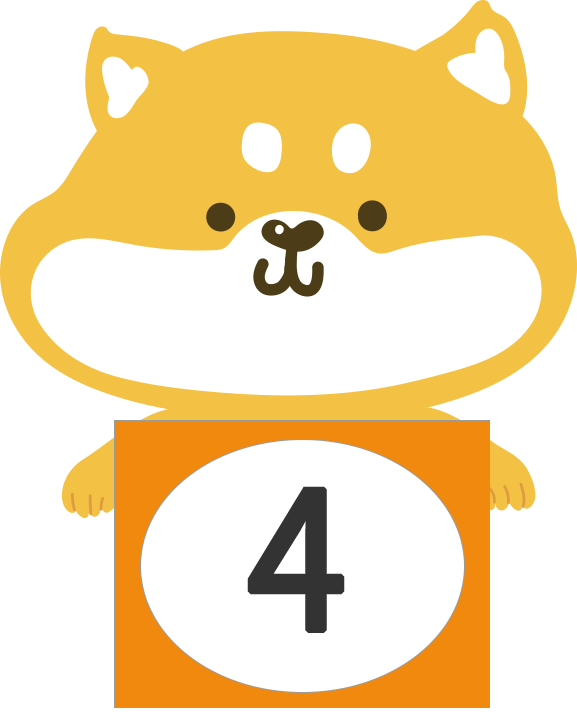
At JLRC, we perceive the mastery of Japanese not merely as a skill enhancement but as a means for life change.
For example in terms of career, this could entail promotions, career transitions, or even relocation. When it comes to Japanese content like anime and manga, mastering the original language allows a deeper enjoyment and application of these materials. Furthermore, through learning Japanese, you might encounter significant people or experiences that can profoundly impact your life.
Therefore, JLRC dedicates itself to each and every Japanese learner, earnestly engaging with them, providing steadfast support for such life changes. We also aspire to be an essential learning platform for your long-term Japanese language journey.
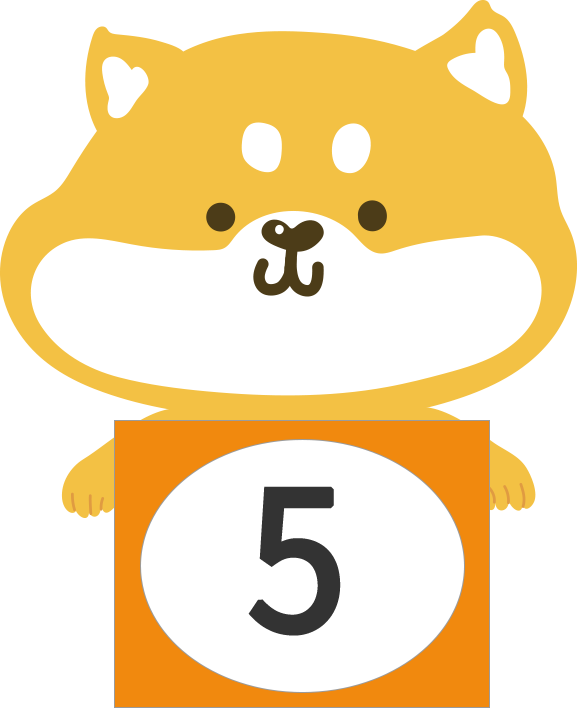
JLRC has a vision of "Opportunities, wherever you are"
Back in 2020, JLRC opted to shift its operations online, with the vision of “Opportunities, wherever you are”. Since then, the extent of JLRC’s services has reached not only provinces near Metro Manila but all over the Philippines, Japan and more than 30 other countries worldwide.
As outlined in our vision, JLRC aims to create a world of opportunities for everyone and empower life changes through its Japanese language education. To realize this vision, we will persist in delivering JLRC’s world-class services on a global scale. Furthermore, our dedication extends to providing the best Japanese language learning experience through its world-class platform.
Our mission is to make Japanese language accessible, easy and fun for everyone
Opportunities, wherever you are.
Opportunities in learning new things Opportunities in discovering your potentials Opportunities in realizing your dreams
JLRC brings opportunities to everyone through online services, regardless of your location, across regions and countries.
JLRC creates a society where people can expand their world beyond language barrier and uniquely shine as they are.

Seeds of Passion: Inception of JLRC's Japanese Language Education (2001)
In 2001, JLRC “Japanese Language Research Center” was established not for the purpose of business grandeur but mainly as a venue for Japanese Language Study and Research. It started with a student of the University of the Philippines who studied in Japan as an exchange student. She developed a love for teaching the Japanese language after her return to the Philippines. She initially started JLRC at her small living area space in East Avenue, Quezon City, Metro Manila, as a sole proprietor business with a small number of vigorous and creative staff. The very minimal capital was augmented with sheer guts, peculiar ideas and love for the Japanese Language.
Building Aspiration: JLRC's Early Struggles (2001-2008)
She has been teaching Nihongo part-time for years and realized that a lot of learners want to study the Japanese language and pass the Proficiency Exam in a shorter time frame. Moreover, they aim to achieve this in a very minimal budget and not much effort exerted in the class. Those days it was a great challenge for the very few Japanese Language teachers to effectively teach Japanese as the learning materials available were very limited. There was no other recourse but to create Nihongo teaching materials in order to augment the sparse learning resources available. On top of this, Japanese companies offering free Japanese language training to their employees were also requesting a shorter training duration to save on the cost. Not to mention, the employees were already having a hard time struggling with their daily workloads, so the additional effort needed for the Japanese language training courses was indeed very challenging.
To address this dilemma, JLRC initiated the motto of “LESS TIME, LESS COST and LESS EFFORT”.
A new Nihongo training module was designed and a new set of materials were developed. The new module design had to accommodate the shortened training hours without sacrificing the overall quality of the class. While, the training materials were adjusted to match the shortened module and at the same time simplify even the most complex topics so that the students could easily understand. Lastly, the module content and materials were adjusted to match the ever changing content of the Japanese language Proficiency Exam.
Roller Coaster Journey: JLRC’s Way to Success (2008-2020)
In 2008, JLRC became a corporation as its Nihongo services volume grew. Despite this, JLRC mainly focused on research and development, and the management had very minimal business acumen. Throughout the years, JLRC has been through so many ups and downs. One can say that JLRC has gone through a tough roller coaster ride reaching the very pinnacle of success in its prime years and going through the very brink of bankruptcy in its worst years. If there’s a silver lining to this experience, it’s that nothing is scary anymore and it brought forth a strong determination for the company to move forward, try harder and become better. It is notable though that those trying years also helped in producing the countless quality materials, effective training designs and high caliber instructors. Hence, these are now utilized as the solid base of its current operation. It is indeed true that turbulent times create beautiful masterpieces.
10 years after she started the company, JLRC transformed into a more stable and profitable business venture with capable employees. There was a great adjustment done in balancing financial stability with technical creativity for Japanese language education.
Beyond Boundaries: New Challenges for Global Japanese Language Education (2020-Present)
In 2020, the Covid-19 pandemic hit and affected all businesses worldwide. JLRC, like the majority of industries, had to halt operations. After a month of business hiatus, JLRC opted to shift its operations online, with the thought “Opportunities, wherever you are”.
At the moment, the extent of JLRC’s services has reached not only provinces near Metro Manila but all over the Philippines, Japan and other countries worldwide. JLRC’s challenge for pursuing ” Less Time, Less Cost, Less Effort ” in learning the Japanese language for the sake of Nihongo learners will never cease. JLRC always retains the essence and spirit of its foundation in mind.
Please feel free to get in touch with us

Copyright © 2024 JLRC Inc. All Rights Reserved
For inquiries, you may call us at (63)2-7358-0565 or (63)917-163-3371
Japanese Language Research Center
Unit 506 Cityland Shaw Tower, Shaw Blvd, Mandaluyong, 1552 Metro Manila, Philippines

10 Fascinating Facts About the Japanese Language
The Japanese language, with its intricate characters and rich linguistic tapestry, holds a myriad of captivating secrets that often go unnoticed. Beyond its role as the official language of Japan, Japanese extends its reach across the globe, leaving an indelible mark on diverse communities. Unraveling the nuances of this language unveils not only its complexity but also its unique features that make it a linguistic treasure. Join us on a journey to discover ten fascinating facts about the Japanese language, shedding light on its global influence, intricate writing systems, and cultural connections.
It's not just spoken in Japan

Beyond the shores of its island home, the Japanese language resonates in unexpected corners of the world, creating a global tapestry of linguistic diversity. While Japan proudly claims Japanese as its official language, the story of its dissemination unfolds in communities far from its native soil.
Historical migration patterns have woven the threads of Japanese into the cultural fabric of various countries. In Brazil, Paraguay, and the United States, significant Japanese-speaking communities have flourished, each contributing to a cultural mosaic that transcends geographical boundaries. This diaspora is a testament to the resilience and adaptability of the Japanese language, finding a home in the hearts and conversations of those far from Japan's archipelago.
The global reach of Japanese pop culture serves as an additional ambassador for the language. Anime, manga, and J-Pop, with their universal appeal, have introduced Japanese phrases and expressions to a vast international audience. Fans worldwide not only consume these cultural exports but also adopt elements of the Japanese language, creating a shared linguistic bridge that spans continents.
It uses four writing systems

The intricate dance of strokes and symbols that form the Japanese written language is a mesmerizing reflection of its cultural richness and historical journey. Unlike languages that rely on a single script, Japanese employs a quartet of distinct writing systems, each with its unique purpose and aesthetic.
Kanji , the first among equals, stands as a testament to Japan's historical ties with China. These characters, borrowed and adapted over centuries, give visual life to concepts and words. With thousands in existence, mastery of Kanji is a formidable but rewarding endeavor.
Hiragana , a syllabic script, takes the stage for grammatical nuances and native Japanese words. Its flowing characters, with their curves and loops, bring a softer dimension to the written language. Hiragana is an essential brushstroke in the canvas of Japanese literature and communication.
Enter Katakana , a sibling to Hiragana but with a distinct role. Reserved for foreign words and onomatopoeia, Katakana's angular characters convey a sense of modernity and exoticism. It's the script that spells out the global influences embedded in the Japanese lexicon.
And then, there's Romaji , the rebel of the quartet, embracing the Roman alphabet. While not traditionally Japanese, Romaji finds its place in transliteration, aiding learners and appearing in modern branding. It's the bridge between Japanese and the broader world, a reminder of the language's adaptability.
It has a ton of "I"s

In the realm of personal pronouns, the Japanese language unfurls a spectrum of nuances and subtleties that diverge significantly from the simplicity of English. Unlike English, which generally employs a single pronoun for the self—'I'—Japanese introduces a kaleidoscope of choices, each laden with cultural connotations, formality, and interpersonal dynamics.
"Watashi" is a common and neutral choice, suitable for formal situations or daily conversation. It embodies a sense of politeness and is often used in professional settings.
"Boku" leans towards informality and is often employed by younger individuals or in casual contexts. It exudes a more relaxed and approachable tone.
"Ore" takes a bolder stance, often associated with masculinity and assertiveness. It's a pronoun chosen in informal settings, conveying confidence and a certain level of familiarity.
"Atashi" , on the other hand, offers a softer, more feminine touch. It's a choice that reflects a gentler, approachable demeanor, often used by women.
This nuanced array of pronouns allows Japanese speakers to subtly convey their social status, relationship with the listener, and the formality of the situation. It's a linguistic dance where the choice of "I" is not just a matter of grammar but a reflection of the speaker's identity, the intricacies of their relationships, and the social context in which the conversation unfolds.
Navigating this spectrum of self-references adds depth to Japanese communication, making it a language where the nuances of 'I' are as diverse as the individuals who employ them. In this linguistic kaleidoscope, every "I" tells a story, woven into the intricate fabric of Japanese social dynamics and cultural subtleties.
Verbs come last

In the symphony of sentence construction, the Japanese language orchestrates a distinctive arrangement where verbs take the final bow. This departure from the familiar subject-verb-object structure found in English and many other languages can be a linguistic labyrinth for those embarking on the journey of learning Japanese.
In Japanese sentences, the verb is the pièce de résistance, the element that brings the narrative to its conclusion. This structural divergence arises from the language's preference for a subject-object-verb (SOV) order. For English speakers accustomed to the subject-verb-object (SVO) sequence, this inversion can initially feel like a linguistic jigsaw puzzle.
Consider the English sentence "I eat sushi." In Japanese, this culinary declaration transforms into "Watashi wa sushi o tabemasu," with "tabemasu" (eat) gracefully taking its place at the sentence's conclusion. This inversion lends a certain rhythmic cadence to Japanese speech, a melody where the subject sets the stage, the object awaits its turn, and the verb delivers the final flourish.
This distinctive sentence structure extends beyond the basic elements of communication, permeating storytelling, poetry, and everyday discourse. The placement of the verb at the conclusion allows for a gradual buildup of information, adding a layer of anticipation and suspense to the listener's experience.
There are no articles

In the linguistic landscape of Japanese, the absence of articles like "the" or "a" creates a canvas where nouns stand boldly, unadorned by the nuances of definiteness or indefiniteness. This absence of articles is a distinctive feature that sets Japanese apart from languages like English, challenging learners to navigate a realm where context reigns supreme.
Unlike English, where articles serve as linguistic signposts indicating whether a noun is specific or general, Japanese nouns are presented with a minimalist elegance. Consider the English sentence "I see a cat." In Japanese, the same sentiment is conveyed with a straightforward "Neko ga mieru" (猫が見える), where "neko" (cat) emerges without the need for an accompanying article.
This simplicity in noun presentation places a heavy reliance on context and shared knowledge between speakers. The Japanese language encourages a level of conversational fluidity where the absence of articles invites a shared understanding of what is being referred to. It's a linguistic dance where speakers, attuned to the rhythm of conversation, effortlessly navigate the terrain of shared knowledge.
It's a fast-paced language

Embarking on the journey of learning Japanese is not merely a linguistic adventure but a rhythmic exploration into a language that pulses with energy. Japanese speakers, like seasoned dancers in a linguistic ballet, navigate a fast-paced tempo that distinguishes their communication style from many other languages, including English.
In the ebb and flow of conversation, Japanese speakers often exhibit a notable cadence, articulating thoughts and expressions at a pace that may seem brisk to those more accustomed to slower linguistic rhythms. This rapidity is not just a product of linguistic efficiency but is deeply ingrained in the cultural fabric of Japan.
The fast-paced nature of Japanese can be attributed to various factors, including the structure of the language itself and the cultural emphasis on succinct and direct communication. Unlike English, where intonation and stress play pivotal roles in conveying meaning, Japanese relies on pitch accent and precise timing to convey nuances.
For learners, this swift tempo can pose both a challenge and an opportunity. On one hand, it demands a heightened level of attentiveness, as words and phrases cascade swiftly in conversation. On the other, it imparts a dynamic and vibrant quality to the language, creating an environment where the exchange of ideas feels like a lively dance.
It has its own unique sign language

Diversity in communication takes on a profound dimension in Japan, where the Japanese Sign Language (JSL) becomes a silent, yet expressive, participant in the linguistic symphony of the country. While spoken and written Japanese form the backbone of communication, JSL adds a layer of inclusivity, offering a unique visual language to the deaf and hard-of-hearing community.
Japanese Sign Language, or Nihon Shuwa (日本手話) as it's known locally, stands as a complete and natural language in its own right. It has its own grammar, syntax, and vocabulary, providing a means of expression that mirrors the richness found in spoken languages. Just as Japanese spoken language is deeply embedded in cultural context and nuance, JSL, too, reflects the cultural nuances and diversity within Japan.
JSL has evolved independently, not directly borrowing from American Sign Language (ASL) or other sign languages prevalent in different parts of the world. This independence has allowed it to cultivate its unique identity, with gestures and signs that align with the linguistic and cultural subtleties of Japan.
The importance of JSL transcends its role as a practical tool for communication. It becomes a medium through which the deaf and hard-of-hearing community in Japan can fully participate in the cultural dialogue. It's not merely a utilitarian form of communication; it's a vibrant and integral part of the diverse linguistic landscape that defines Japan.
It's full of loanwords

The linguistic landscape of Japanese is a testament to the country's historical openness to cultural exchange and its ability to seamlessly integrate borrowed elements into its own lexicon. Japanese, a language deeply rooted in tradition, carries within its syllables an eclectic mix of loanwords from various corners of the globe.
Throughout its history, Japan has borrowed words from diverse languages, molding them to fit seamlessly into the unique phonetic and grammatical structures of Japanese. English, Portuguese, French, German - these linguistic imports have not just been adopted but adapted, resulting in a linguistic fusion that reflects Japan's global interactions.
"コンピュータ" (konpyūta) for computer, "テレビ" (terebi) for television, or "レストラン" (resutoran) for restaurant are just a few examples of how Japanese effortlessly incorporates loanwords into its vocabulary. These words, while originating from other languages, are now an integral part of daily Japanese discourse, highlighting the adaptability and openness embedded in the language.
What sets Japanese loanwords apart is their transformation to suit the phonetic nuances of the language. The borrowed terms undergo a metamorphosis, emerging as if they were always native to Japanese. This linguistic assimilation not only enriches the language but also reflects Japan's receptivity to global influences throughout its history.
It's influenced by nature

Embedded within the linguistic roots of Japanese is a profound connection to the natural world, where the language unfolds like petals, each word a delicate reflection of the rich tapestry of nature that defines Japan's landscape. From the changing seasons to the flora and fauna that inhabit the archipelago, the influence of nature permeates every syllable, making Japanese a poetic ode to the environment.
Seasonal words, known as "kigo" in Japanese, are woven into the language, expressing the profound impact of the changing seasons on culture and daily life. Words like "桜" (sakura) for cherry blossoms or "紅葉" (momiji) for autumn leaves evoke not just the visuals but the emotions and cultural significance associated with each season.
Beyond the seasons, Japanese is enriched with words that draw inspiration from the natural world. Animals, plants, and natural phenomena are seamlessly integrated into everyday language. For instance, the term "木漏れ日" (komorebi) beautifully encapsulates the interplay of sunlight filtering through the leaves of trees, capturing a moment of serenity and beauty often experienced in Japanese landscapes.
The influence of nature extends to idioms and expressions, where metaphors and analogies drawn from the natural world add depth to communication. Phrases like "石の上にも三年" (ishi no ue ni mo san nen) , translating to "three years on a rock," convey the idea that persistence leads to success, drawing an analogy from the gradual smoothing of a stone over time.
It's constantly evolving

Japanese, like a living organism, breathes and adapts with the passage of time, ensuring its relevance in an ever-changing world. Far from being stagnant, the language is a dynamic entity, constantly evolving to reflect societal shifts, technological advancements, and the cultural currents that shape Japan.
The evolution of Japanese is evident in the introduction of new words and expressions, often arising from technological innovations or emerging trends. The impact of globalization and the interconnectedness of cultures has led to an influx of loanwords, blending seamlessly into the linguistic tapestry. Terms like "スマホ" (sumaho) for smartphone or "インフルエンサー" (infuruensā) for social media influencer exemplify the language's capacity to absorb and integrate contemporary concepts.
Slang and informal expressions, reflective of the ever-changing youth culture, inject a sense of vibrancy into the language. This constant linguistic flux ensures that Japanese remains a living, breathing entity, resonating with the experiences and expressions of each generation.
Moreover, the evolution of Japanese extends beyond vocabulary to include shifts in pronunciation, grammar usage, and even the nuances of formality. The language is a mirror to the societal transformations that Japan undergoes, adapting to new norms while retaining its cultural roots.
As we delve into the intricacies of the Japanese language, it becomes apparent that its beauty lies not only in its characters and syntax but also in its dynamic evolution. From the complexity of its writing systems to the influence of nature woven into its vocabulary, Japanese stands as a testament to the deep connection between language and culture. As the language continues to transcend borders and adapt to the ever-changing global landscape, each nuance discovered is a step towards a profound appreciation of Japan's linguistic legacy. Embark on the journey of learning Japanese, and you'll find yourself not only mastering a language but also unraveling the rich tapestry of a culture that has shaped it over centuries.
- Foreign Languages
Related Posts
Career Success with Japanese Language
Survival Level Phrases in Japanese
What do we know about Geishas
Comentarios

Learn Japanese to Get a Better Job in Japan
Finding a job in Japan isn’t always easy. In addition to showcasing your experience and skills on your resume , certain positions may require proficiency in Japanese. I began my journey in Japan as an English teacher, a common path for many expats. However, I soon realized teaching wasn’t the right fit for me. I knew I needed to learn Japanese to get a better job in Japan.
I dedicated myself to learning the language, although at the time, I didn’t know anyone who had successfully pivoted industries by learning Japanese. Even my coworkers claimed it couldn’t be done. Despite the skepticism, I proved them wrong and acquired the necessary language skills to secure my desired job.
Looking back, I believe having some encouragement would have made the process smoother. With this in mind, I reached out to my colleagues at GaijinPot to ask a simple question: How did learning Japanese contribute to your job success in Japan?
Laura’s JLPT Journey
First, I had a conversation with Laura, a GaijinPot Study coordinator from the United States, like myself. Laura discussed her experiences with the Japanese Language Proficiency Test (JLPT) N2, which is widely regarded as the “business level” of the test. This indicates that Laura put significant effort into her studies, and it’s evident that her hard work has paid off. Among foreigners, her Japanese proficiency is among the best I’ve encountered.
Here’s what she had to say.
“I’ve always wanted to work in a role where I could use Japanese, which was a major factor in my decision to move to Japan. Despite achieving N2 certification, the second-highest level on the JLPT, I lacked the confidence to apply for positions requiring Japanese proficiency. So, I set a goal to study for the N1 exam.
The JLPT was a useful roadmap for acquiring the skills that eventually led me to a job.
Upon passing the N1, I gained the confidence to apply for jobs that specifically demanded Japanese skills. However, I don’t view the N1 as the ultimate measure of Japanese proficiency. There’s much more to learn beyond what’s tested, particularly in business Japanese, which encompasses more than grammar, vocabulary, and kanji.
Nevertheless, reaching the N1 level exposed me to a broad range of vocabulary that I wouldn’t have encountered otherwise. While the test isn’t comprehensive, its expansive vocabulary section covers various fields like construction, medicine, and politics. This exposure helped me expand my vocabulary beyond what I knew in my native language.
Consequently, during job interviews, I could easily define terms I had encountered in my studies. While it’s possible to achieve this without JLPT preparation, the exam was a useful roadmap for acquiring the skills that eventually led me to a job where I could use Japanese daily.”
・ Career Goals : Aim for roles in Japan requiring Japanese proficiency to align with career aspirations.
・ Confidence Boost : Attain higher JLPT levels, like N1, to bolster confidence in applying for language-demanding positions.
・ Vocabulary Help : JLPT offers exposure to varied vocabulary, although it’s not the sole indicator of proficiency.
・ Interview Preparation : Expand vocabulary using JLPT study resources for job interviews.
・ Language Skill Development : Utilize JLPT for language skills needed for daily use in Japanese workplaces.
Insights from Cindy: Navigating The Workplace
To gather additional perspectives, I reached out to my colleague Cindy from the Philippines to share her journey. She plays a vital role in our Japan Room Finder and Japan Home Finder services, connecting customers with English-speaking real estate agents in Japan. Cindy shared a very inspirational story about learning Japanese, and It motivates me to keep learning.
“I’ve wanted to live in Japan for as long as I can remember. However, I soon realized that teaching English wasn’t my calling, so I made a concerted effort to study Japanese extensively during my schooling.
Despite passing the N2 exam before graduating, I quickly learned that working in a Japanese company provides a rapid education in the language. My initial job was difficult, with overwhelming kanji and keigo (formal Japanese). There were nights filled with frustration and tears as I grappled with my perceived shortcomings. Looking back, though, those setbacks ultimately paved the way for my current position—a realization that brings me immense gratitude.
Traditional workplaces still rely on phone and fax communications, so know how to use them.
I recommend prioritizing speaking and writing skills for those aspiring to work in a Japanese company, particularly for emails (handwriting is optional but beneficial). Many companies assess candidates based on their verbal communication abilities, so refining pronunciation, diction, and fluency is crucial. Additionally, some traditional workplaces still rely on phone and fax communications, so you should know how to use them.
Each person’s career path is unique, and what worked for me may not align with your interests. Conduct thorough research into the requirements of your desired field and tailor your studies accordingly—it’ll significantly ease your job search.
Mastering Japanese is a lengthy and challenging journey, with experiences varying for each individual. If you ever feel apprehensive or uncertain about the road ahead, remember that people are willing to support you and learning extends far beyond securing a job offer.”
・ Language Proficiency : Prioritize learning Japanese for success in Japanese workplaces.
・ Communication Skills : Focus on improving verbal communication, pronunciation, and fluency for job interviews and daily interactions.
・ Adapt to Old School : Familiarize yourself with traditional communication methods such as phone and fax, which are still prevalent in some Japanese workplaces.
・ Tailored Study Approach : Customize your language studies based on the specific requirements of your desired field to enhance your job prospects.
・ Persistence and Resilience : Embrace setbacks as opportunities for growth, as navigating challenges is part of the journey to success in a Japanese career.
Reflecting on My Journey to JLPT N2 Certification
To conclude, I’d like to share a bit about my own experience. My primary goal was passing the N2 level on the JLPT, as it would enable me to confidently label myself as “business level” on my resume. Although attending a language school would have been ideal, financial constraints led me to pursue self-study. I spent many weekends immersed in Japanese textbooks, fueled by endless cups of coffee at family restaurant drink bars.
After taking the N2 test, while awaiting my results, I felt sufficiently confident in my Japanese proficiency to start applying for jobs. Through multiple interviews conducted in Japanese, I demonstrated my skills and secured a position. Fortunately, I also passed the N2 exam!
The takeaway from my experience is this: with dedication and effort, obtaining a good job in Japan is achievable through Japanese language study. Despite naysayers who may doubt your ability to learn Japanese proficiently enough for employment in Japan, many individuals, including myself, have successfully done so.
And, of course, if you need an extra push, consider exploring resources like our GaijinPot Study page for additional support.


File(s) under embargo
until file(s) become available
The Life Story of an American Learner of Japanese on a Remote Island in Japan: A Cross-cultural Adaptation Perspective
Since the 2000s, there has been a growing interest in qualitative research in the field of Japanese language education, including life story research (e.g., Miyo, 2015). One of the purposes of life story research in Japanese language education is to pay attention to, listen to, and describe the voices of people to whom Japanese language education has so far paid little attention (Miyo, 2014, 2015a). Many studies have listened to the voices of Japanese language learners living in Japan and described their experiences (e.g., Miyo, 2009; Sato, 2015; Maruyama & Ozawa, 2018). However, many studies have not paid particular attention to the region where the learners are staying. One gets the impression that the place could be anywhere as long as the learners are in Japan. Further, cross-cultural adaptation research often focuses on international cross-cultural contact. However, in recent years, it has been pointed out that cross-cultural contact also involves regional differences within a single country (Gui et al., 2012; Berry, 2016). In other words, foreigners staying in a host country experience not only intercultural contact between their own country and the host country but also intercultural contact arising from regional differences within the host country, making the adaptation process complex.
This narrative case study focused on one American learner of Japanese, Kevin (pseudonym), and his experience on Futaba Island (pseudonym) and analyzed his process of cross-cultural adaptation. Data was collected from his diary and semi-structured interviews with him over six months. The collected data were then graphically represented using the method of Trajectory Equifinality Modeling (TEM) (Sato et al., 2009; Sato et al., 2014). The data obtained in this study showed that Kevin’s back-and-forth between Futaba Island and the mainland impeded and facilitated his cross-cultural adaptation in different ways. Unlike people in large cities on the mainland, people on Futaba Island stare at Kevin and treat him as a special guest, which made him aware of cultural barriers, leading him to construct an identity as an outsider and feel, “I will never fully integrate into Japanese society.” Furthermore, when he traveled to the mainland, he experienced reverse culture shock by encountering many American tourists that he cannot see on Futaba Island. Seeing American tourists behaving incompatibly with Japanese cultural norms made Kevin realize that he was more integrated into Japanese society than he had thought. All of this suggests that when considering the cross-cultural adaptation of foreigners staying in Japan, it is essential to take a place-based perspective on where they are in Japan and where they have been during their stay. Furthermore, just because a person is staying in the host country does not mean that cross-cultural adaptation is influenced by factors that are exclusive to the host country. While staying in the host country, one’s cross-cultural adaptation may be influenced by people from or by events in their home country. It is necessary to take into account home country-related factors as well.
Degree Type
- Doctor of Philosophy
- Languages and Cultures
Campus location
- West Lafayette
Advisor/Supervisor/Committee Chair
Additional committee member 2, additional committee member 3, additional committee member 4, additional committee member 5, usage metrics.
- Japanese language


- Dealer Locator
- About YANMAR
News Release
Cultivating innovation on the european sake rice journey.
April 30, 2024 Yanmar Europe B.V.

The demand for sake in Europe has never been higher – interest in the traditional Japanese beverage rebounded to record levels in 2021 post-pandemic, and the global sake market is expected to be worth $10.7 billion by 2028*1. Factors such as the Tokyo Olympics, an increase in e-commerce sales and more Japanese restaurants in Europe have led to year-on-year increases in the amount of sake shipped to the continent from Japan.
A pioneer in solutions for customers on the land, at sea and in the city, Yanmar’s Sake Rice Project exemplifies the company’s commitment to creating a society that offers an exciting life filled with rich and fulfilling experiences. This innovative endeavor aims to develop sake rice varieties suitable for cultivation in a European climate, offering a new and exciting experience for consumers in the form of locally produced sake. Yanmar’s initiative is augmenting the continent’s strong demand for Japanese sake with European sake made from European sake rice, advancing Yanmar’s purpose to realize A Sustainable Future.
Yanmar R&D Europe agronomist Carolina Fabri explains the challenge: “The Italian environment is pretty different from the Japanese. You need to have specific varieties (of rice) that need to be cultivated in specific soil and weather conditions.”
Japanese Soul, European Ingredient

Yanmar partnered with the Italian Rice Experiment Station (IRES) in northern Italy. Here, Yanmar’s team of agronomists met with head of the IRES, Massimo Biloni, to start work on developing a new sake rice variety for the unique soil and climate conditions found in this part of Italy.
“Collaboration with agronomists and experts was very important,” according to Massimo. By studying how to adapt the process of sowing, fertilising, controlling weeds and harvesting, the team ensured these new varieties could thrive.
The distinctive combination of environmental factors, known as terroir, is one of the reasons European sake is so unique. The Italian soil and climate conditions which influence the rice varieties, combined with Japanese brewing techniques, makes for a fascinating new product. Georgio Maggioni, a member of the Sake Sommelier Association in Milan, describes it as having “a Japanese soul, with Italian ingredients.” He has high hopes for the new rice varieties and believes the sake it produces will fit perfectly into the European market, providing consumers with interesting new choices and an enriched beverage culture.
The process of developing new rice varieties was not without its challenges. The Italian environment is very different from Japan’s, and this meant any new rice variety would have to be adapted to the specific soil and weather conditions found there. However, thanks to rigorous research and advanced agronomy technology, the result was two new sake rice varieties available to European farmers: EuSake 01 and EuSake 02. Yanmar was then able to work with milling partners to process the new rice to sake-making standards. Massimo summarised the implications of this success: “Thanks to Yanmar, we are developing not only new sake rice varieties, but also greater sustainability.”
Local Production for Local Consumption

Following the successful cultivation of the new varieties, Yanmar approached local brewers to start turning locally grown sake rice into viable sake.
One of these was Gregoire Boeuf, owner and chief brewer of the sake brewery, Les Larmes Du Levant, located in Pélussin, France. He was given the opportunity to work with the European grown rice by Yanmar and was enthusiastic about the possibility of using local ingredients.

“When you drink sake, you’re not only drinking a beverage – you are drinking history, you are drinking the cultural heritage of Japan itself,” Gregoire says. He explains that the sake making process is a fine balance between rice, water, yeast, enzymes and the right temperatures. “Everything happens at the same time, so it’s a very living process.”
Importantly, the quality of sake made at Les Larmes Du Levant is not compromised when using European rice instead of Japanese. Gregoire states that the varieties produce an excellent final product which will offer a new drinking experience for his customers. There are several benefits to his business: local ingredients for local produce contribute to a more sustainable and environmentally friendly business model, whilst also offering an exciting new opportunity for the European consumer. At the same time it provides breadth and diversity that is complimentary to the traditional Japanese sake market.

“It’s of the utmost importance for the future of sake making in Europe,” he says.
Sustainable Solutions for Food and Drink Production
The Sake Rice Project also addresses environmental and economic concerns which come with transporting sake rice from Japan to Europe. In the last five years, the cost of shipping a 720ml bottle of sake increased 1.5 times, from USD 5.20 to USD 8.21*2. And in terms of carbon emissions, shipping to Europe results in around 149 tons of CO2 per ton of sake rice – 7,491 tons if transported by plane*3. Through the cultivation of European rice varieties, the project reduces the dependence on exports from Japan and lowers the environmental impact of sake production. Carolina Fabbri, an agronomist at Yanmar Research and Development Europe, stated: “It’s great to work on a project which takes care of sustainability throughout the whole production process.”

Following the successful introduction of the two new rice varieties for the Italian climate, there is now the potential to develop further varieties which are suitable for cultivation in other European environments.
Thanks to Yanmar’s pioneering project, the European consumer is benefitting from a solution that embodies Yanmar’s spirit of HANASAKA – a principle of challenge and opportunity towards unlocking people’s full potential. Carolina also points out that within the framework of Yanmar’s wider R&D strategy, “innovation can be used and applied to the European market not only in agriculture, but in other sectors as well.”

This initiative is not only sustainable and environmentally friendly, but also represents an exciting development for consumers, giving greater choice, and a wider appeal for this delicious and fascinating Japanese beverage.

*1: Data Bridge Market Research Market Analysis Study 2021 *2: Ministry of Finance, Japan compiled by Sake Experience Japan (JPY110 to the USD, average rate for 2021). *3: Calculated with the carboncare emissions calculator tool: https://www.carboncare.org/en/ .
Yanmar Europe B.V., Marketing Dept. [email protected]
- Note: Information contained in the news release is valid at the time of publication and may differ from the most recently available information.
Inquiries and Support
- Subscribe Digital Print

- Tourism in Japan
- Latest News
- Deep Dive Podcast
Today's print edition
Home Delivery
- Crime & Legal
- Science & Health
- More sports
- CLIMATE CHANGE
- SUSTAINABILITY
- EARTH SCIENCE
- Food & Drink
- Style & Design
- TV & Streaming
- Entertainment news
Brazil's last Japanese-language newspaper innovates to stay in print

Diario Brasil Nippou, the last remaining Japanese-language newspaper in Brazil, is struggling to keep its presses rolling.
Behind the difficulties facing the paper is a decline in the number of subscribers, partly reflecting the aging of immigrants from Japan.
The daily hopes to stay afloat by stressing the cultural role it plays. As part of those efforts it has started soliciting "supporters," and will print a special edition to coincide with Prime Minister Fumio Kishida's visit to Brazil in early May.
During World War II Japanese-language newspapers were banned in Brazil, and many immigrants from Japan believed the propaganda broadcasts made by the Japanese government on shortwave radio. While publication of Japanese-language papers was resumed after the war, a conflict erupted between Japanese immigrants who believed Japan had won the war and those who knew it had lost.
Masayuki Fukasawa, the 58-year-old chief editor of Diario Brasil Nippou, says that the conflict highlighted the need to provide correct news as a Japanese newspaper.
Japanese-language papers in Brazil, which have a history stretching back over 100 years, had dwindled to two by 1998 — and one of them went out of business at the end of 2018.
The remaining paper was forced to cease publishing at the end of 2021 due to the fallout of the COVID-19 pandemic. But it was reborn as Diario Brasil Nippou in January 2022 thanks to funding by an investor who was eager to continue the publication of a Japanese-language newspaper.
Still, the structural problem of subscription fee and ad revenues not being enough to keep the paper going remained unresolved.
To revamp the business model, Kimiko Aso, 54, a Japan Overseas Cooperation Volunteers member dispatched to Brazil by the Japan International Cooperation Agency in November, launched a program allowing a person who pays 3,000 Brazilian real or more a year to become a "supporter" of the newspaper.
Such supporters can get special offers in five tiers depending on the amount of their payments, such as being able to read a sister paper and run advertorials.
Aso points out that a Japanese-language newspaper has a role to play in keeping a record of Japanese society abroad, adding that she wants companies to understand that Diario Brasil Nippou has social significance, rather than only having them run ads in the newspaper.
The planned special edition will include comments from people who look forward to active economic exchanges between Brazil and Japan.
The Japanese government's efforts to join forces with Japanese communities in Latin American countries serve as a tail wind. Fukasawa says he wants Kishida to read the special edition.

In a time of both misinformation and too much information, quality journalism is more crucial than ever. By subscribing, you can help us get the story right.
David Gulpilil's epic final journey and funeral in Arnhem Land captured for new documentary
From outback hearse to remote helicopter, the unique final journey and funeral of one of Australia's most celebrated actors has been captured for a new documentary.
NOTE: Aboriginal and Torres Strait Islander readers are advised this article contains an image of a person who has died.
The late actor's family has granted permission to use his name and image.
Trailblazing actor David Gulpilil was one of the Australian film industry's most recognisable faces, starring in landmark movies including Storm Boy, The Tracker, Crocodile Dundee and Rabbit Proof Fence, prior to his death in 2021, aged 68.
He grew up in the Northern Territory bush, from where he was plucked by British film director Nicholas Roeg for the lead role in his first film, 1971 psychedelic outback odyssey, Walkabout.
In his final years of life, Gulpilil had voiced his hope for returning to his birthplace of Arnhem Land to hunt, fish and live on his traditional homeland of Gupulul Marwuyu.
While he didn't make it home in his lifetime, his family followed through with his final wishes for his body to be repatriated to Arnhem Land for a traditional Yolŋu bäpurru (funeral ceremony).
A film crew captured Gulpilil's final journey from the small town of Murray Bridge in South Australia back to the remote NT, which is being turned into new documentary named Journey Home – David Gulpilil, set to hit cinemas and television screens on NITV later this year.
His son Jida Gulpilil told the ABC his father had wanted the efforts to be captured "to show the world – his audience and supporters – about who we are and where we come from".
"This is as honest as it's gonna get to telling my father's story about where we come from, and the ceremonies that we do for our people," Mr Gulpilil said.
"Dad taught me how to live and work and hunt the crocodile.
"These are the things that we live with, and this is the beautiful side of being who we are, and we want to share that with the world."
Gulpilil's journey home to Arnhem Land included a 3,000-kilometre ride in a refrigerated hearse up the Stuart Highway to Darwin.
After this, he was flown by charter aircraft back to the territory town of Nhulunbuy, and later, was taken by chopper back to his remote homeland near the community of Ramingining.
"We flew him across the Arafura Swamp in a big helicopter and got him home, where we rolled out the red carpet," his son said.
The film is being directed by respected filmmakers Maggie Miles and Trisha Morton-Thomas, and is being backed with a Screen Territory investment of $150,000.
- X (formerly Twitter)
Related Stories
When he was told he had months to live, david dalaithngu knew he had to make one more film.
'Grandpa came home': Tears and pride as Gulpilil returns to Arnhem Land
Sydney Opera House illuminates life of acting legend David Gulpilil in posthumous tribute
David Gulpilil died thousands of kilometres from home. Now his son wants to see change
- Alice Springs
- Indigenous (Aboriginal and Torres Strait Islander)
- Indigenous Culture
- Indigenous Policy
- Tennant Creek
Navigating Large Language Models Fundamentals and Techniques for Your Use Case
Describing SAP's Approach to Large Language Models (LLMs)
After completing this unit, you will be able to:
- Describe LLMs
- Identify benefits and risks of using LLMs
- Describe SAP's approach towards LLMs
Explaining Product Development for LLM Use Cases at SAP
Introducing Techniques for Maximizing LLM Performance for Your Use Case
Applying Retrieval Augmented Generation (RAG) and Fine-Tuning Strategies to Improve LLM Performance
Evaluating and Testing LLMs
Record of Achievement
Pass all the quizzes and receive a digital badge.

Navigating Large Language Models fundamentals and techniques for your use case
Share your recently acquired knowledge across your social and professional networks.
Related live sessions
Sap learning group.
Join our SAP Learning Group moderated by an SAP Learning expert. Ask your questions about your digital learning journeys, prepare successfully for your SAP Certification exams, and collaborate with other learners to reach your learning goals.


IMAGES
VIDEO
COMMENTS
I want to learn Japanese! If you follow the instructions in this over the top, step-by-step guide, you will reach your goal of Japanese fluency. However, this journey is going to take a lot of effort and hard work on your part. Anyone who tells you learning a language is going to be easy is either misinformed or trying to sell you something.
Take a look at these 11 simple steps to help you cover these bases and start your Japanese learning journey. 1. Learn the Japanese alphabet. The best way to learn Japanese is to start with learning the alphabet. There are three basic writing systems you need to learn to be able to read Japanese: Hiragana, Katakana, and Kanji.
For those on the path to learn Japanese, there are many twists and bends along the journey.Every language encompasses an entire plethora of forms and patterns, and Japanese is no different. And it can feel quite overwhelming for new learners to retain all of the novelty that comes with a new language or even to know where to start!
begin your japanese language journey today! Join Now. Based on the #1 best-selling Japanese From Zero! book series. Japanese YOUR way! Are you a beginner? ... Using his unique insights and experience, he has helped students around the world to master the Japanese language.
The known history of the modern Japanese language begins sometime before the 5th century AD, after the Chinese language was introduced to Japan. ... The study of Japanese is a long journey, but the results are truly worth it. Japanese has so many hidden treasures to offer learners. Not only does it offer deeper knowledge of Japan and its ...
Every character you master, every sentence you form, and every conversation you have is a step forward in your language learning journey. Finally, learning a language can be a transformative experience, and starting your Japanese language journey could be the beginning of an adventure of a lifetime. So, pick up your textbook or download that ...
Step 2: Learn the Japanese Grammar. Learning Japanese grammar can initially seem daunting, but it can be a rewarding and enjoyable experience with the right approach and resources. One of the best ways to learn Japanese grammar is by studying the basic sentence structures and word order.
Learn Japanese online with us. If you're traveling to Japan, watching Anime, or need to know Japanese for your job, we can help! With hundreds of lessons, smart tools and a great community, you can learn to read, write and speak Japanese quickly. Start your Japanese language learning journey with a risk-free 7 day trial now.
What's included : ★ Weekly Video Calls - Boost your speaking skills with Nana and other teachers/ learners. ★ Q&A Support - Get your language-related questions answered with 24 hour support. ★ Group Chat - Stay motivated by connecting with others with real life conversation. ★★FREE for our regular students - If you are ...
Find a language exchange partner to practice speaking and listening. Engage with Japanese communities and forums to interact with other learners. Set achievable goals and track your progress. Embrace Japanese customs and traditions to deepen your understanding. Stay motivated and enjoy the journey of learning Japanese.
learn Japanese for beginners: a fun & easy beginner's journey through Hiragana, Katakana, Genki and Japanese language fundamentals.let's study japanese toget...
Mastering the Japanese writing systems is a crucial milestone for anyone embarking on the journey to learn the language. The complexity of having three distinct scripts - Hiragana, Katakana, and Kanji - may initially seem overwhelming, but each plays a vital role in Japanese communication.
When a mysterious letter arrives, a young author discovers a confession of crimes from a chair maker who claims to have an intangible connection to his work. Read our JLPT N4 level adaptation of this classic story that uses a vocabulary of 1500 words. Read story. Your #1 Japanese language learning tool. Yomu Yomu offers lessons, translations ...
From its origins in ancient Japan to its modern forms, the Japanese language reflects the dynamic cultural and social changes that have shaped the nation. In this article, we will delve into the journey of the Japanese language, exploring its origins, influences, and important milestones that contributed to its modern complexity and beauty.
Learn Japanese with ease, using the award-winning website: Modern Japanese. Our professional writing tools provide easy access to kanji characters and hiragana letters for beginners and experts alike. Get started with your language journey today!
In 2010, she relocated to the U.S. and commenced her teaching journey in 2015, tutoring at e-learning firms. Presently, she serves as the principal of OWL Japanese Lessons, offering online instruction in Japanese language and culture worldwide. She specializes in business Japanese and provides guidance for JLPT test preparation.
Switch to Japanese keyboardt: While typing, switch to the Japanese input mode by tapping the globe or language icon on your keyboard until you see "日本語" or "あ". 3. Type Using Romaji: In Japanese input mode, type using Romaji (English letters). For example, "tai" for 大 (big) or "eki" for 駅 (station). 4.
Join SayuriSaying for an enriching journey into Japanese culture and language, perfect for intermediate learners and cultural enthusiasts. Dive into a variety of topics, from social norms to personal insights and cultural concepts like '縁(En)'. Enjoy engaging discussions, both in solo narratives and special episodes featuring guest speakers ...
The first year of my Japanese learning journey! Studying. Today I reached the one-year mark in my Japanese learning journey! Usually, I'm not one to write progress reports and such, but I've seen quite a lot of them while browsing this sub, so I thought why not add to the already veritable plethora of posts like this.
My Nihongo Journey. I started this site to create support and tools to help me on my journey from intermediate to advanced Japanese language fluency. Yes, it's true—I made this website to help myself. Selfish as that may seem, that's good news for you. I'm user numero uno, and because I'll be using this tool every day, you can be sure ...
A language journey in Japan. Learn Japanese with this RPG based on Japan's true geography, history and local culture. Progress through the country while earning Hanko from Japanese Masters in their traditional castle.
Unlock the power of life changes through Japanese language education. Embrace a journey that transcends language barriers, shaping not just your skills but your entire life story. ... We also aspire to be an essential learning platform for your long-term Japanese language journey. JLRC has a vision of "Opportunities, wherever you are" Back in ...
Embarking on the journey of learning Japanese is not merely a linguistic adventure but a rhythmic exploration into a language that pulses with energy. Japanese speakers, like seasoned dancers in a linguistic ballet, navigate a fast-paced tempo that distinguishes their communication style from many other languages, including English.
Finding a job in Japan isn't always easy. In addition to showcasing your experience and skills on your resume, certain positions may require proficiency in Japanese. I began my journey in Japan ...
Since the 2000s, there has been a growing interest in qualitative research in the field of Japanese language education, including life story research (e.g., Miyo, 2015). One of the purposes of life story research in Japanese language education is to pay attention to, listen to, and describe the voices of people to whom Japanese language education has so far paid little attention (Miyo, 2014 ...
Reflecting on his academic and professional journey, Alexander encourages anyone considering a Diploma of Language Studies to pursue their passion and study what they find interesting. "Studying a language at university is fun, and such a great opportunity to develop language skills and a deep understanding of another country and culture ...
Georgio Maggioni, a member of the Sake Sommelier Association in Milan, describes it as having "a Japanese soul, with Italian ingredients." He has high hopes for the new rice varieties and believes the sake it produces will fit perfectly into the European market, providing consumers with interesting new choices and an enriched beverage culture.
Sao Paulo - Diario Brasil Nippou, the last remaining Japanese-language newspaper in Brazil, is struggling to keep its presses rolling. The South American country is home to the largest Japanese ...
A film crew captured Gulpilil's final journey from the small town of Murray Bridge in South Australia back to the remote NT, which is being turned into new documentary named Journey Home - David ...
Get started with the Large Language Models fundamentals and techniques with our self-paced learning journey. Enroll now!